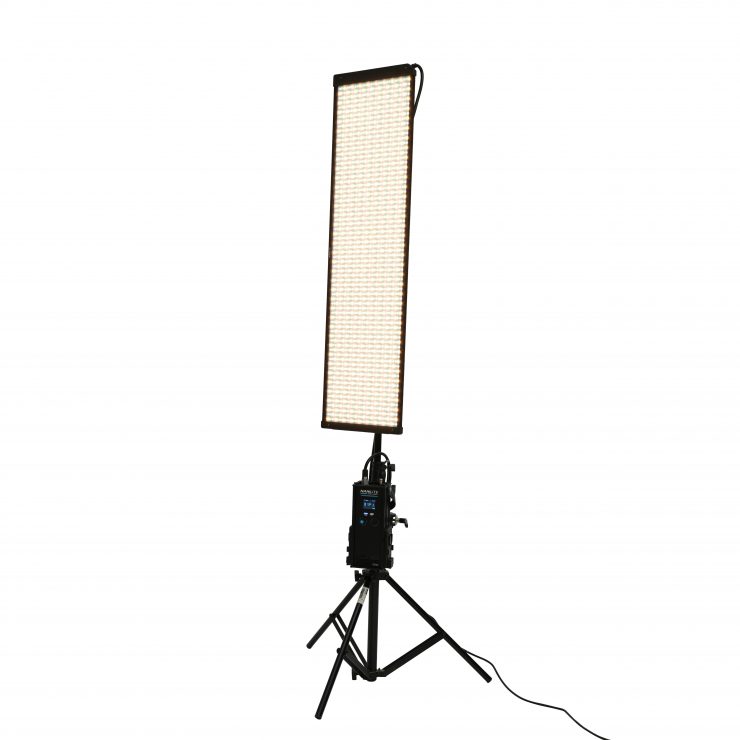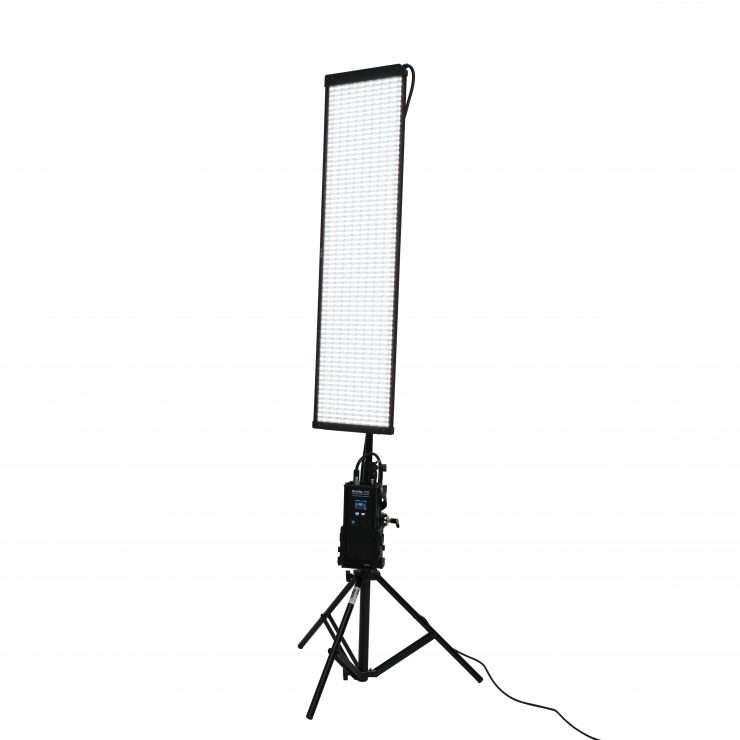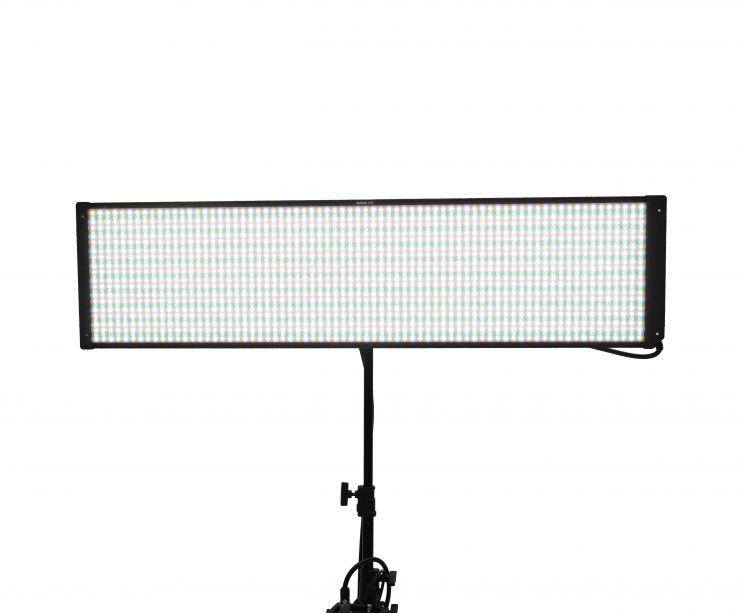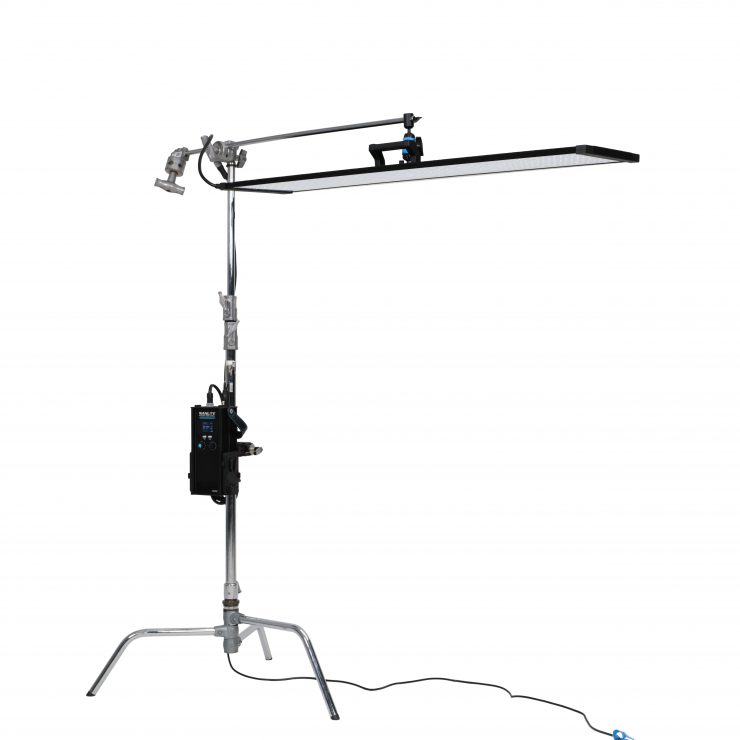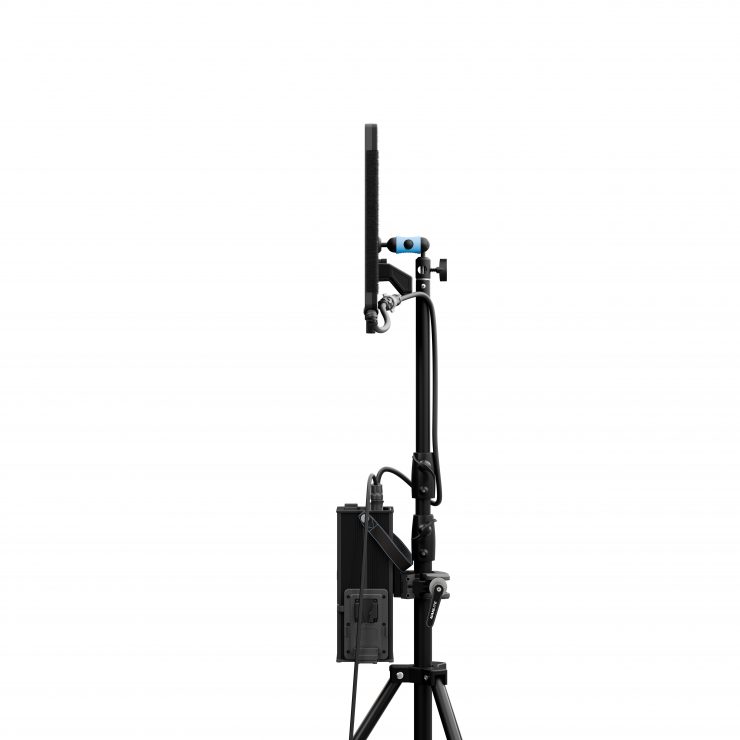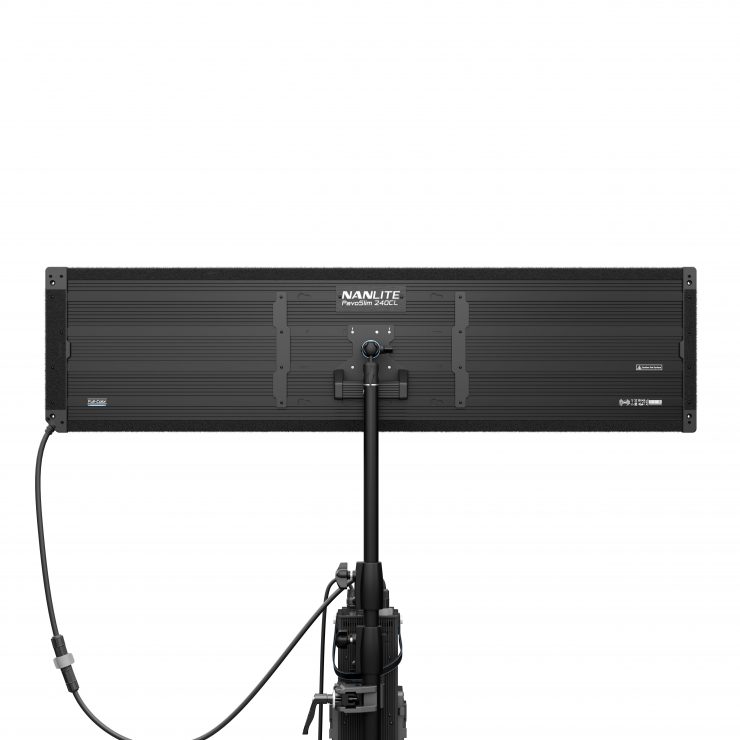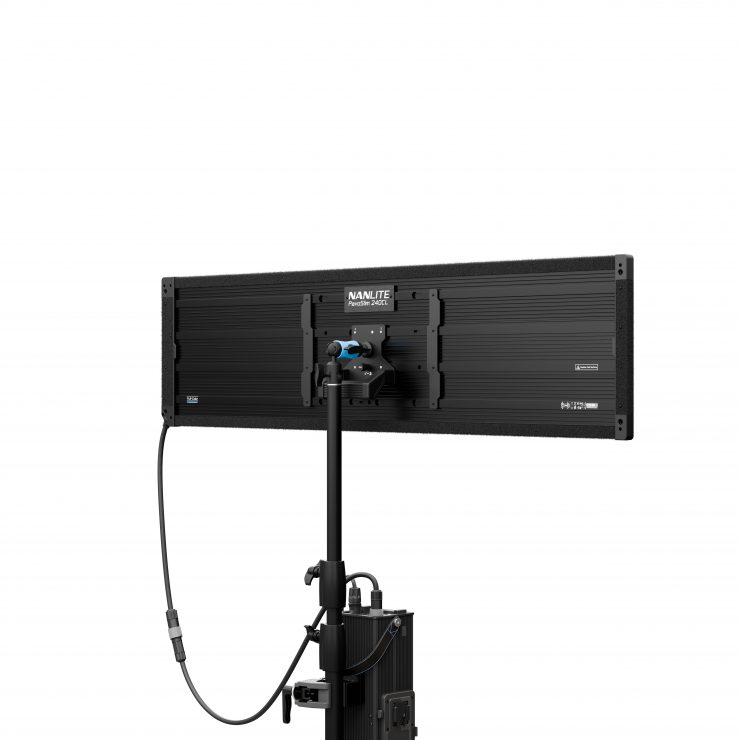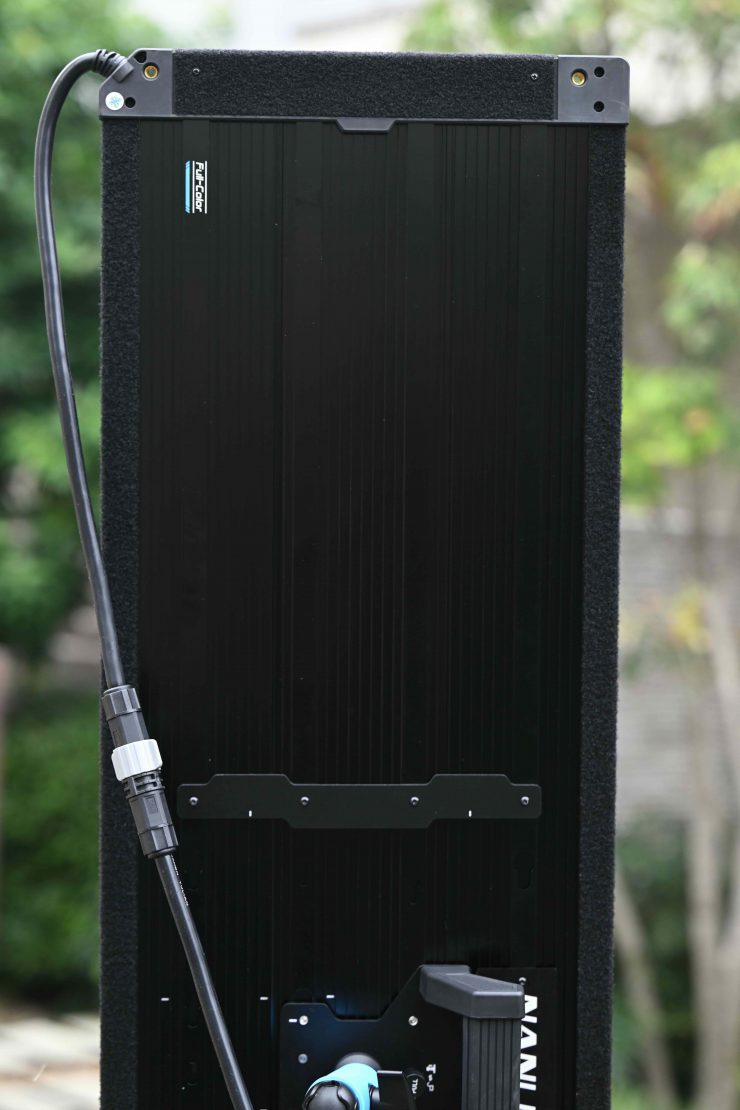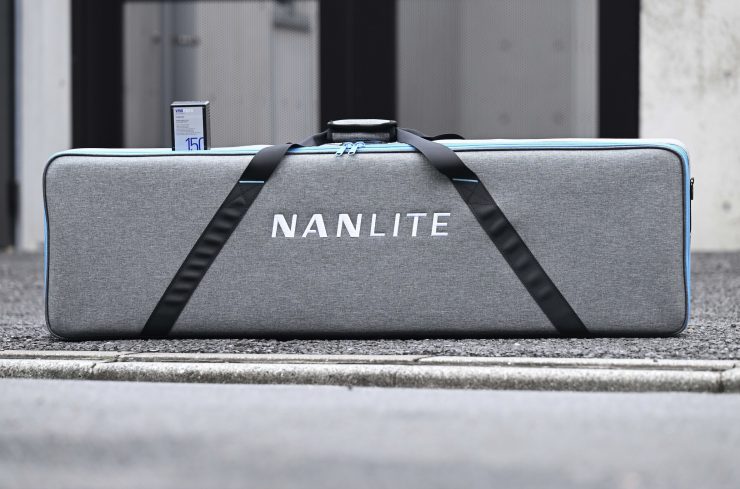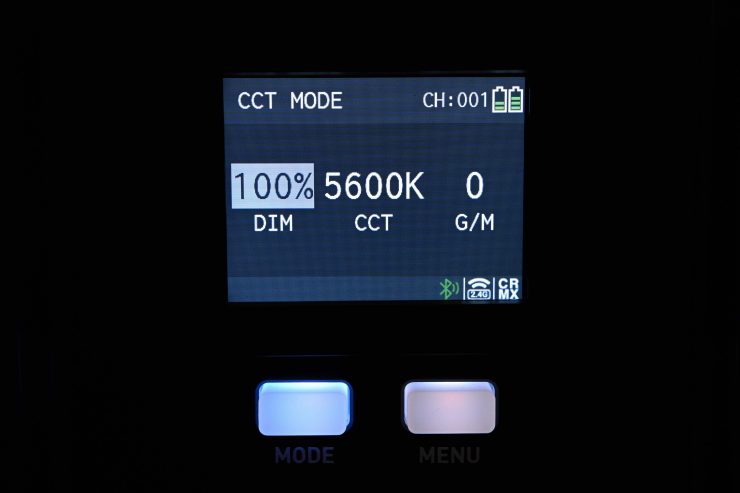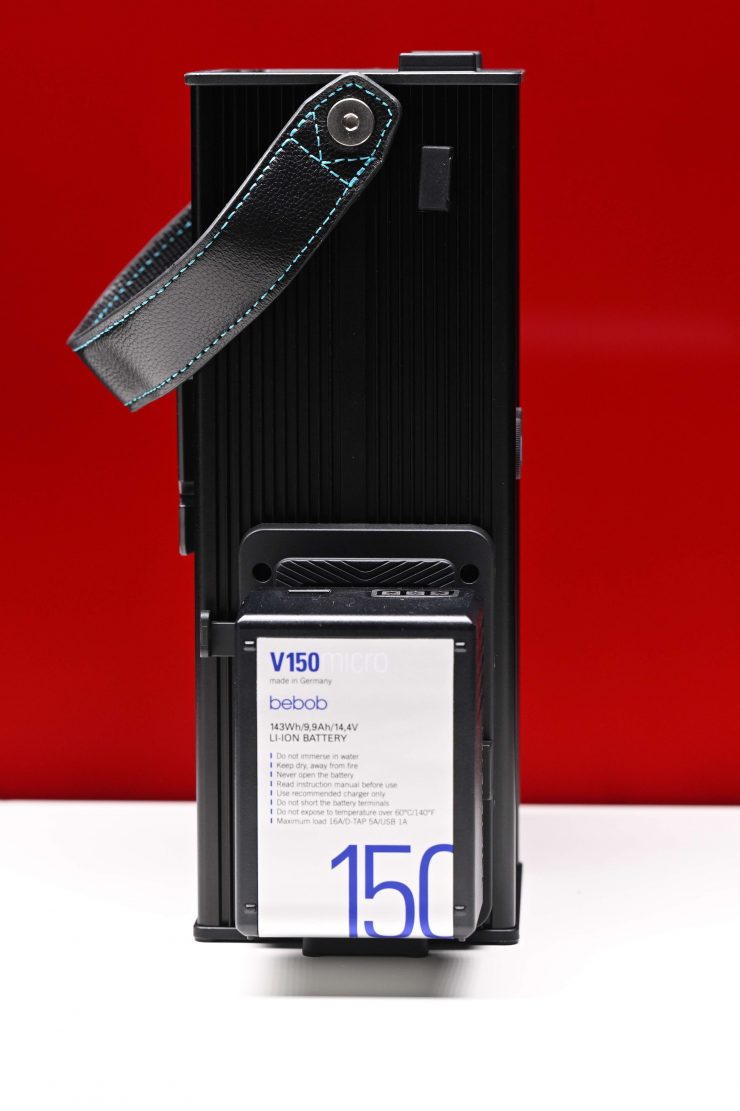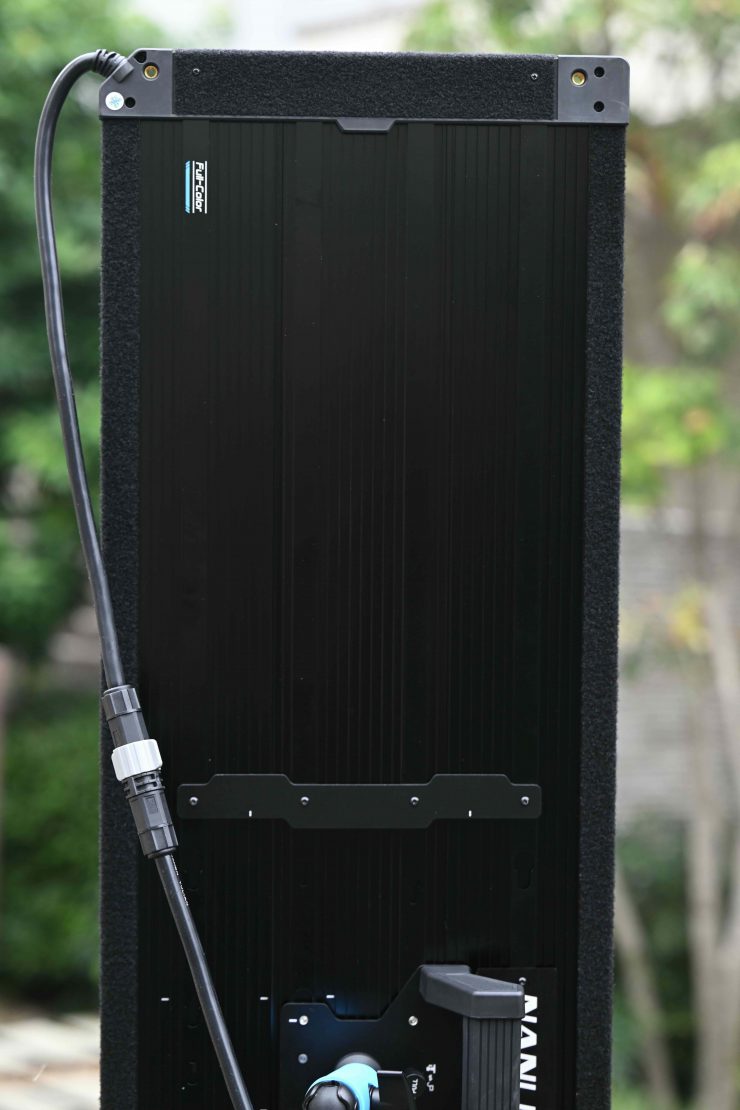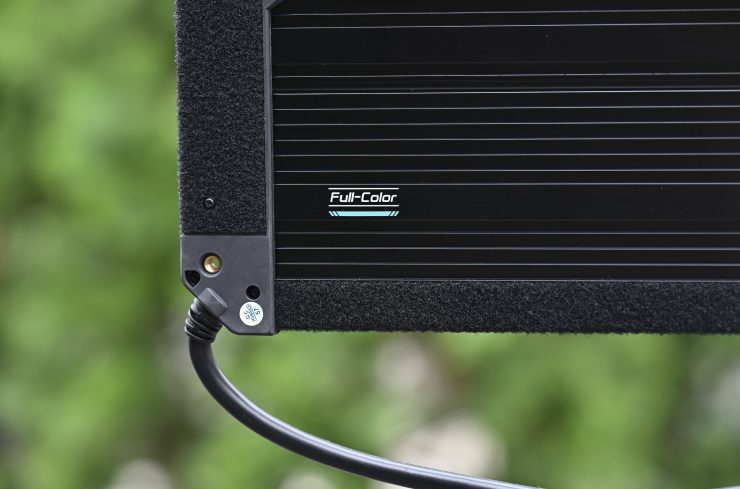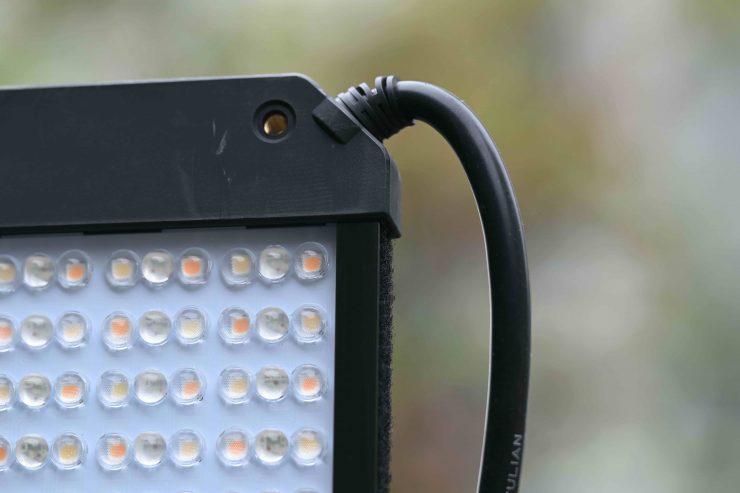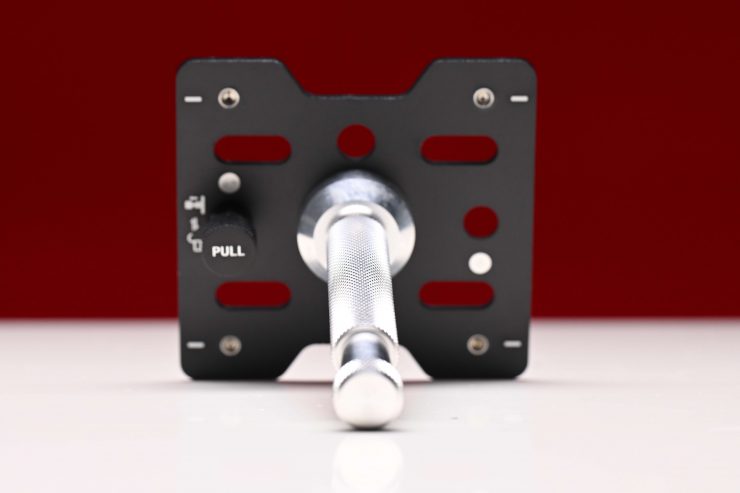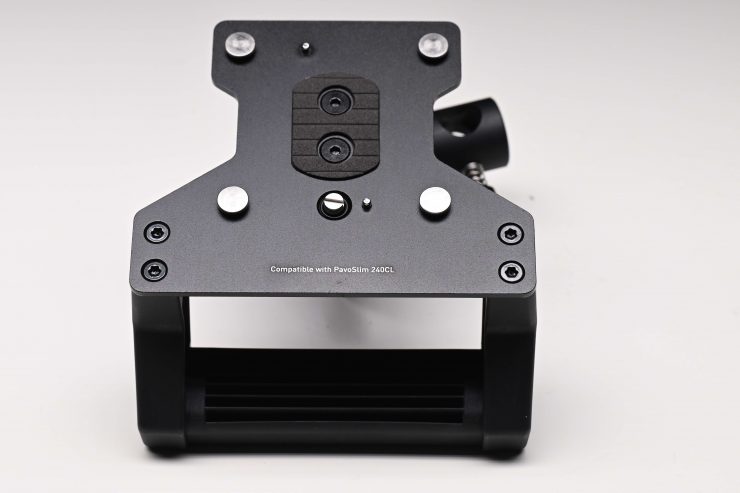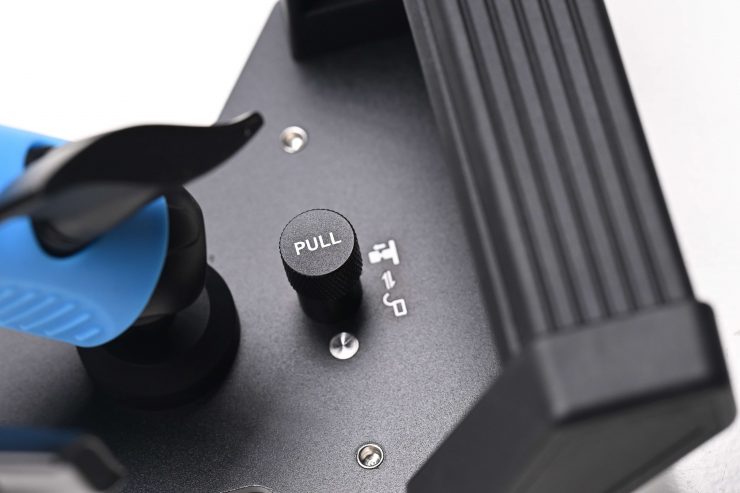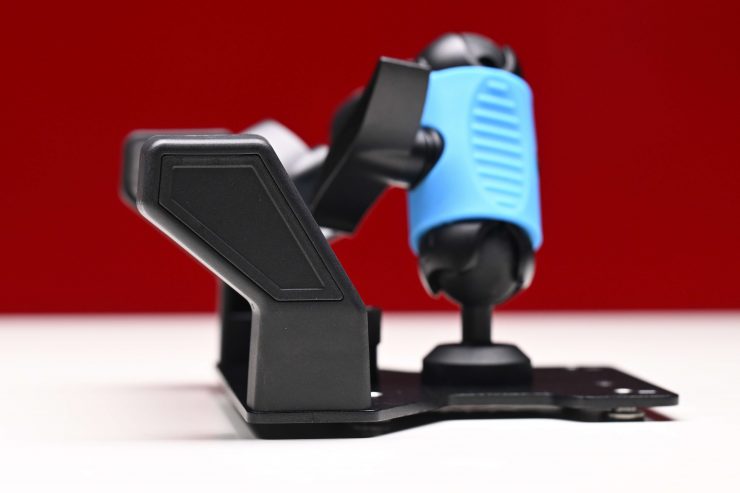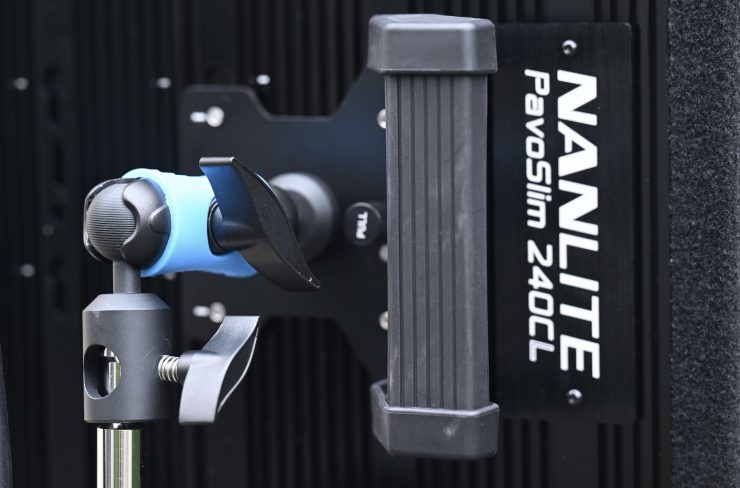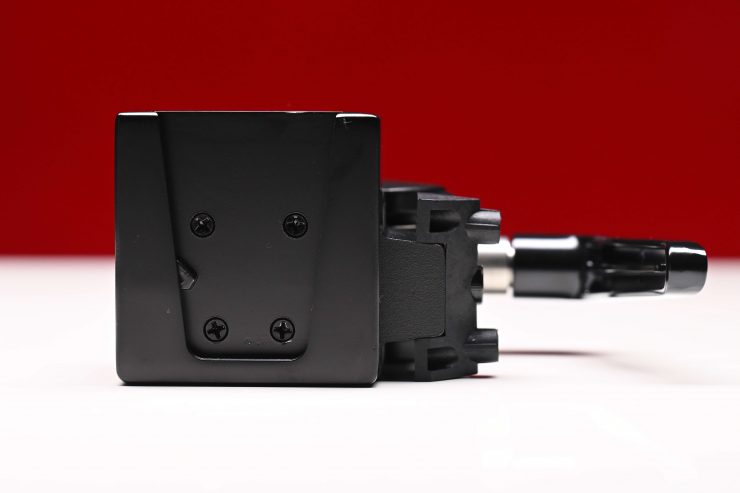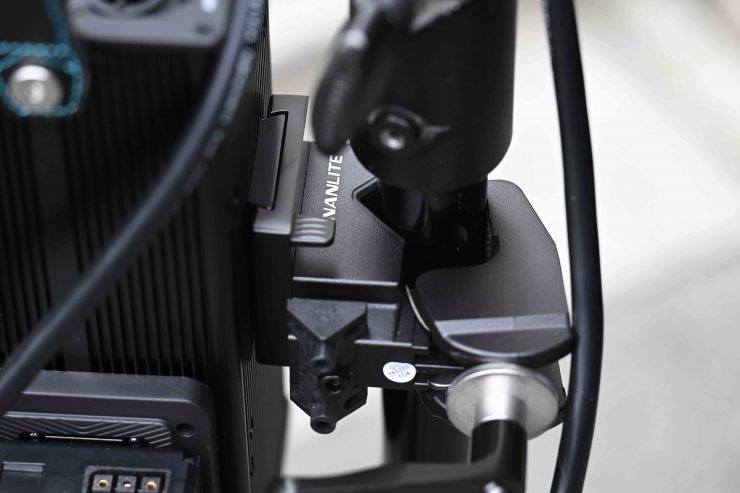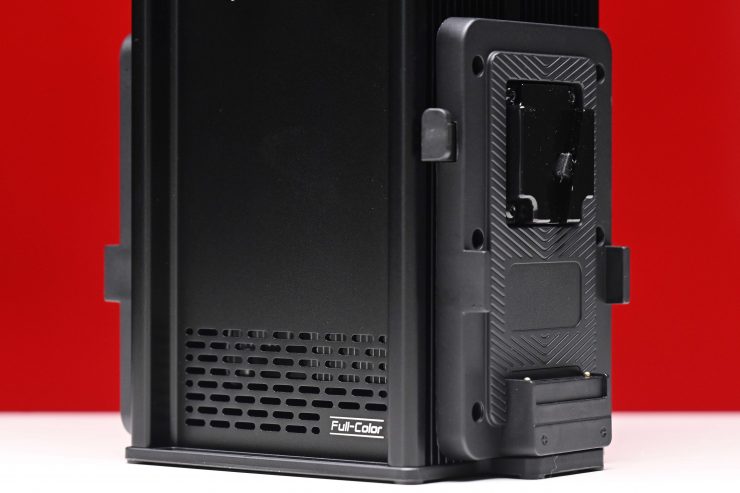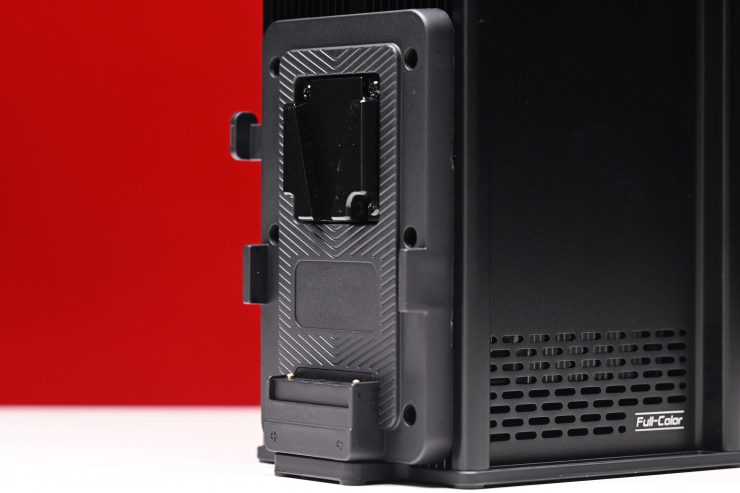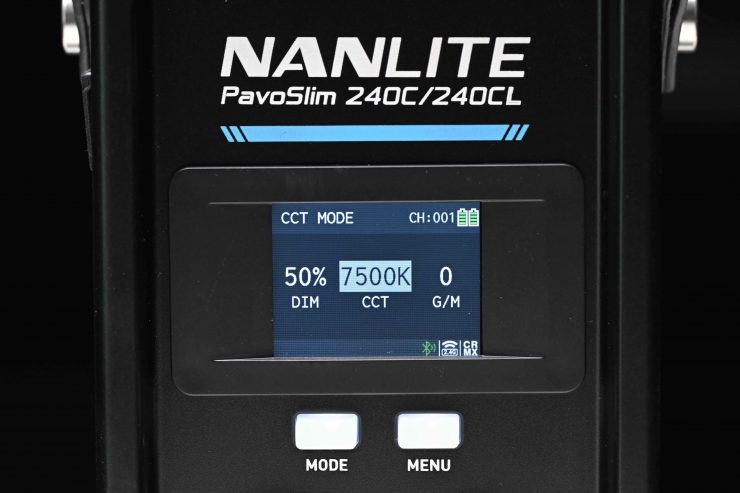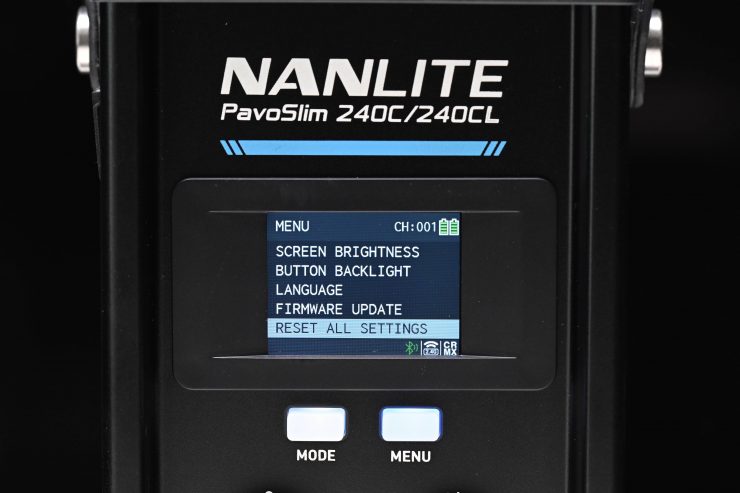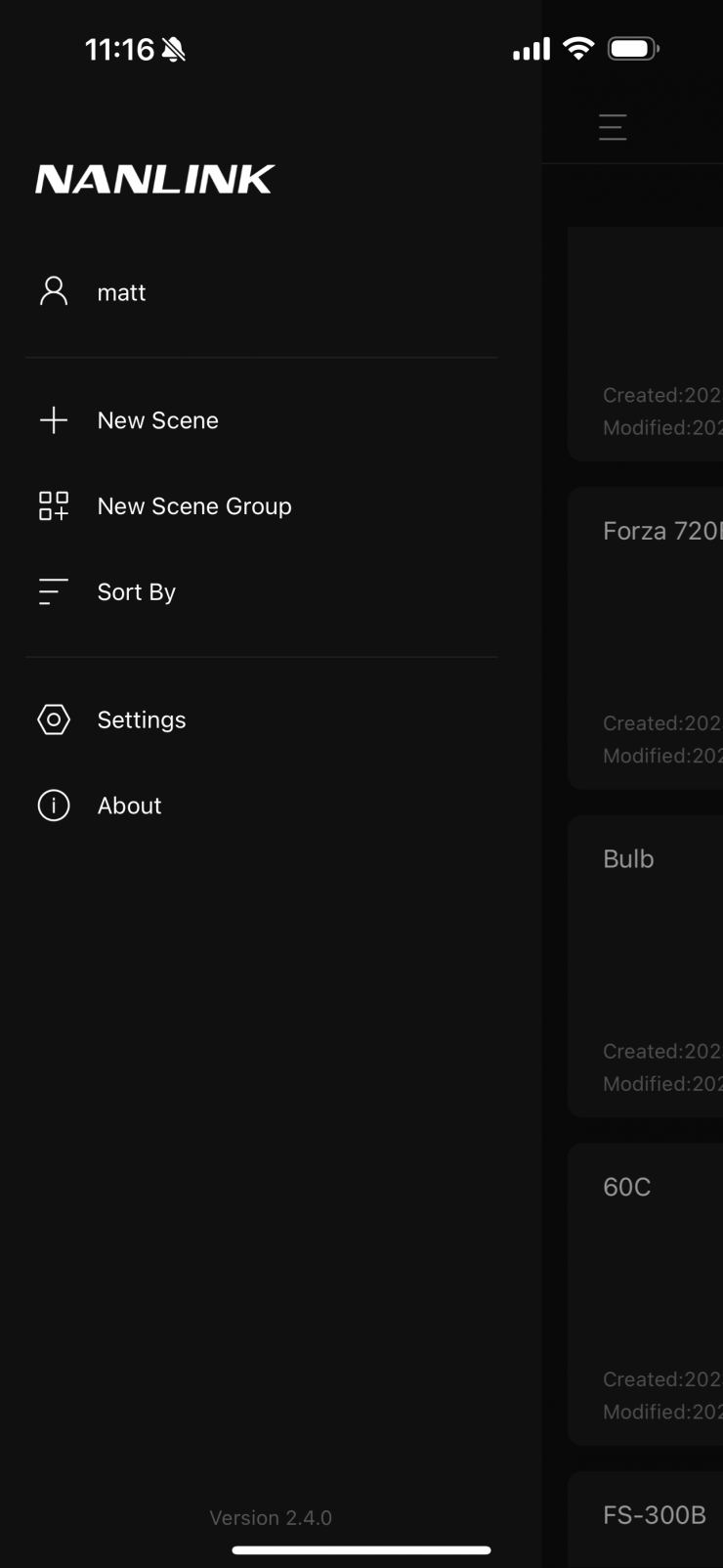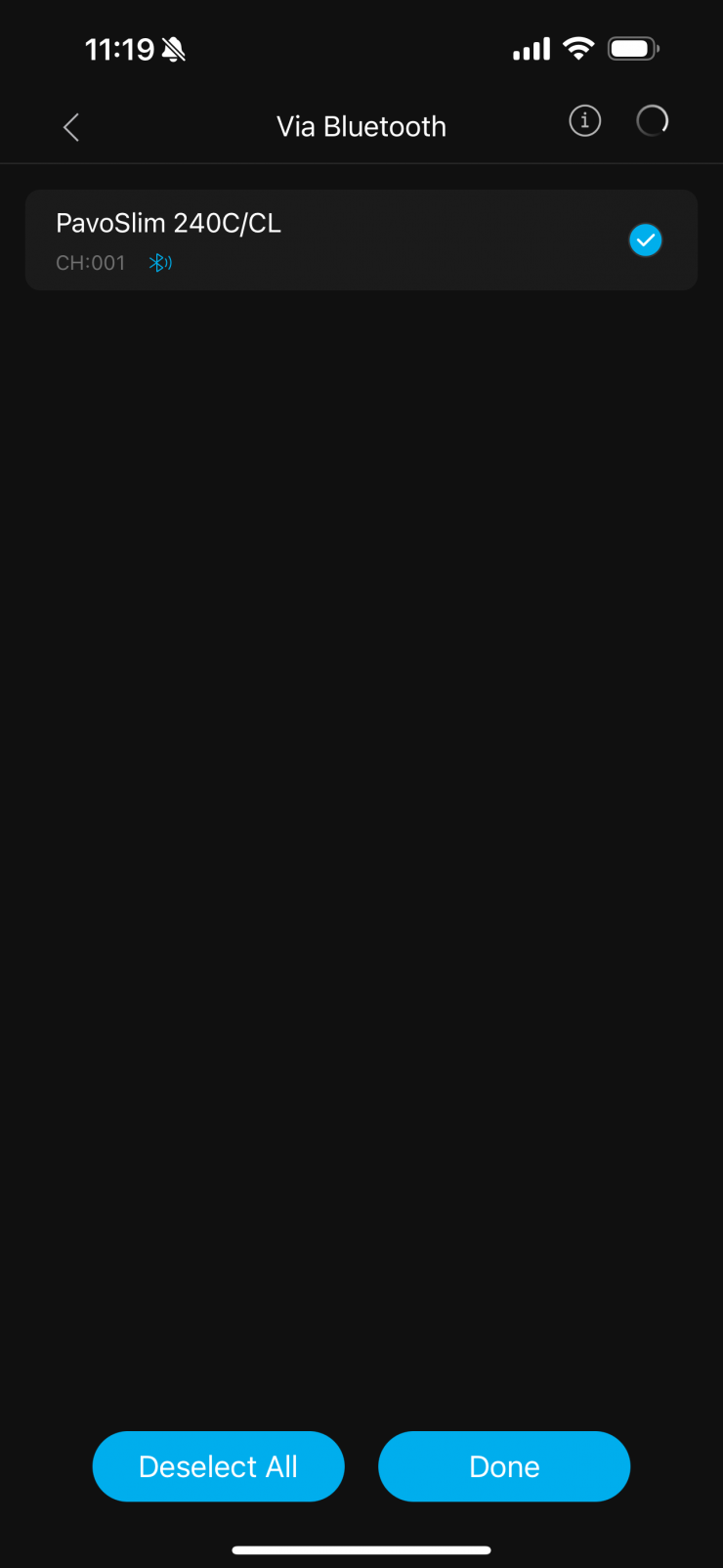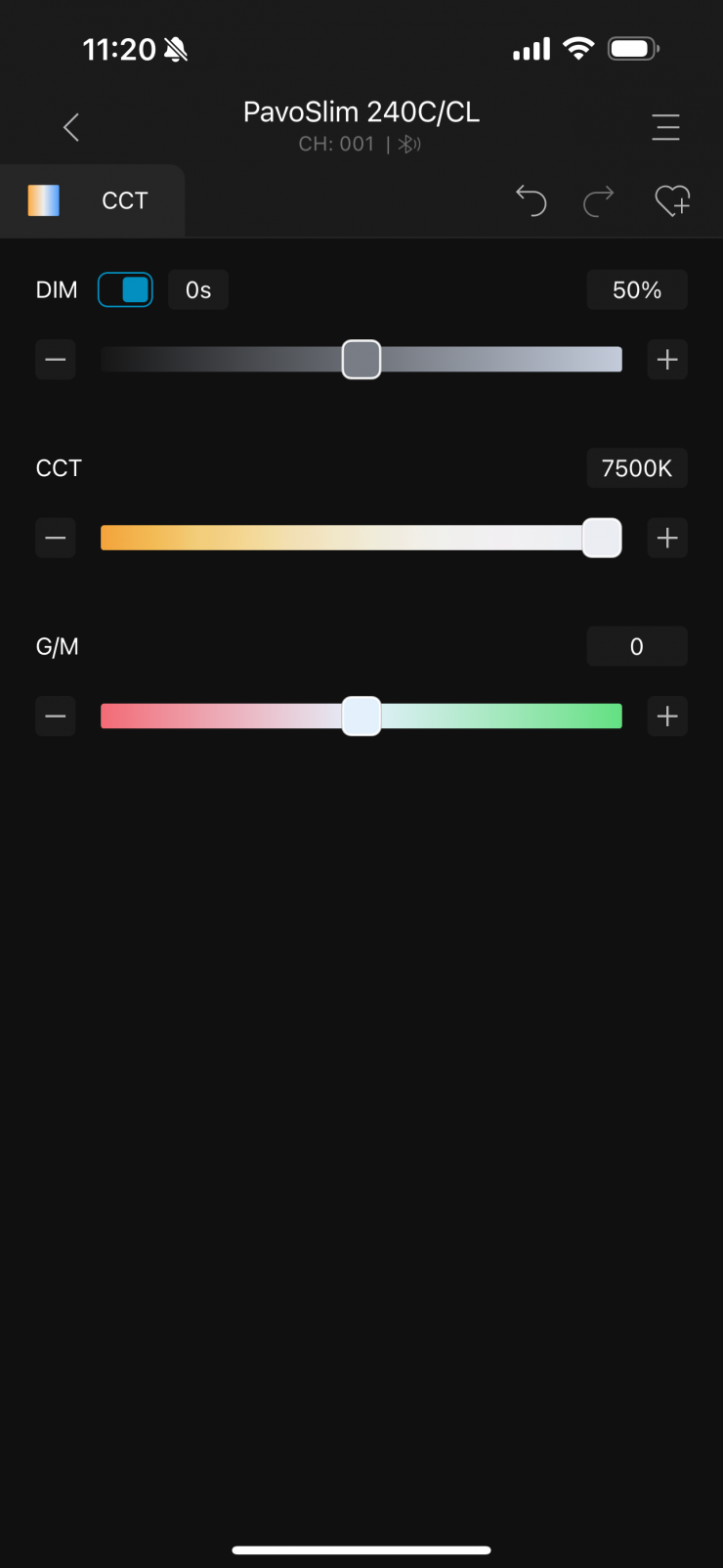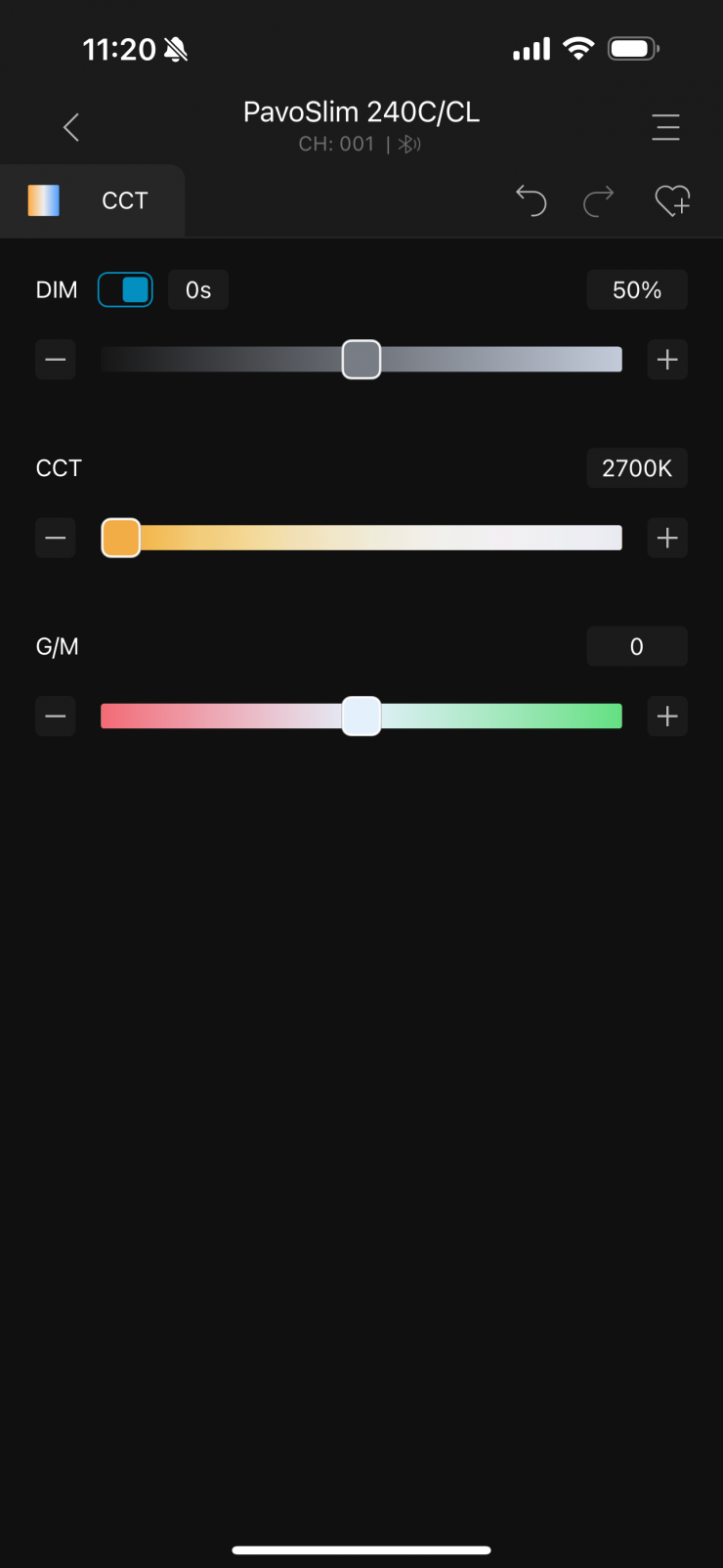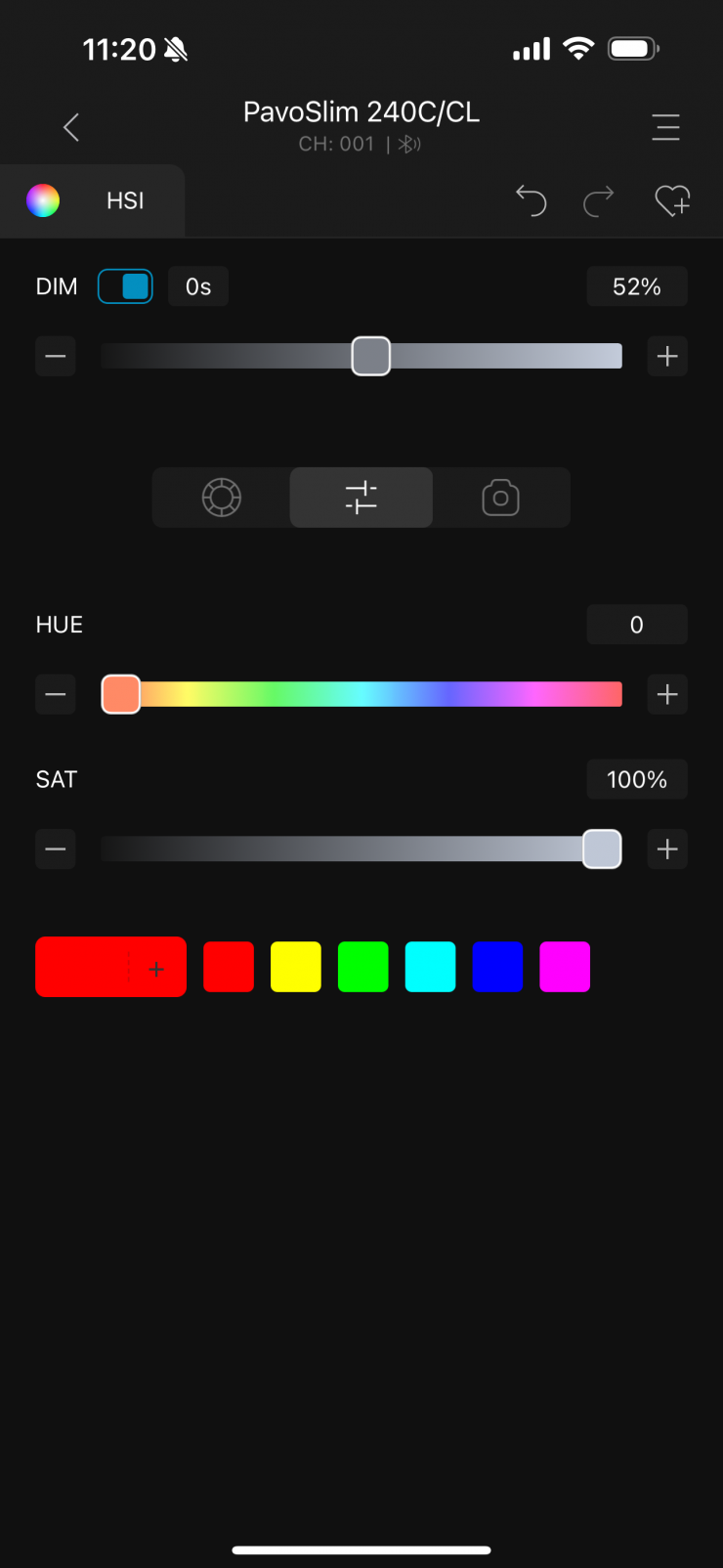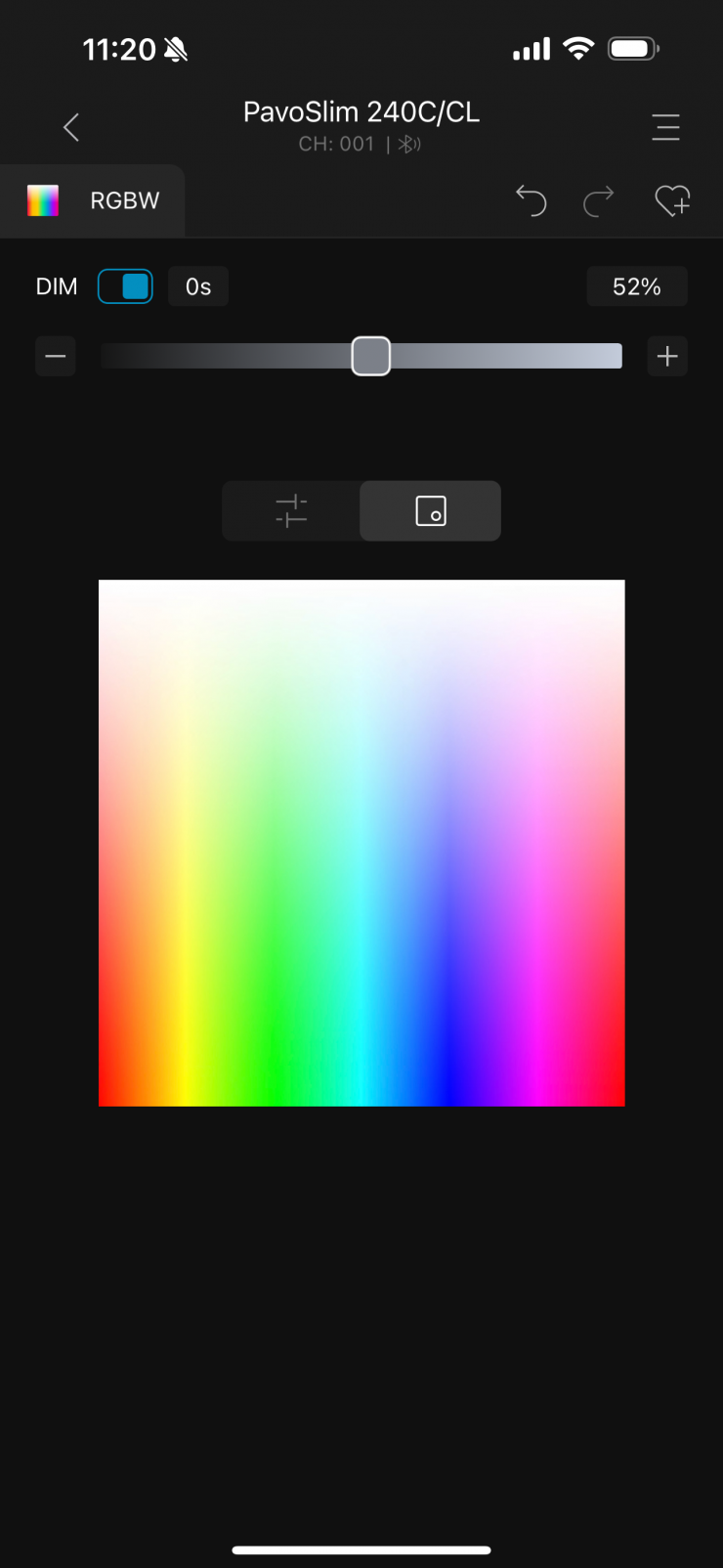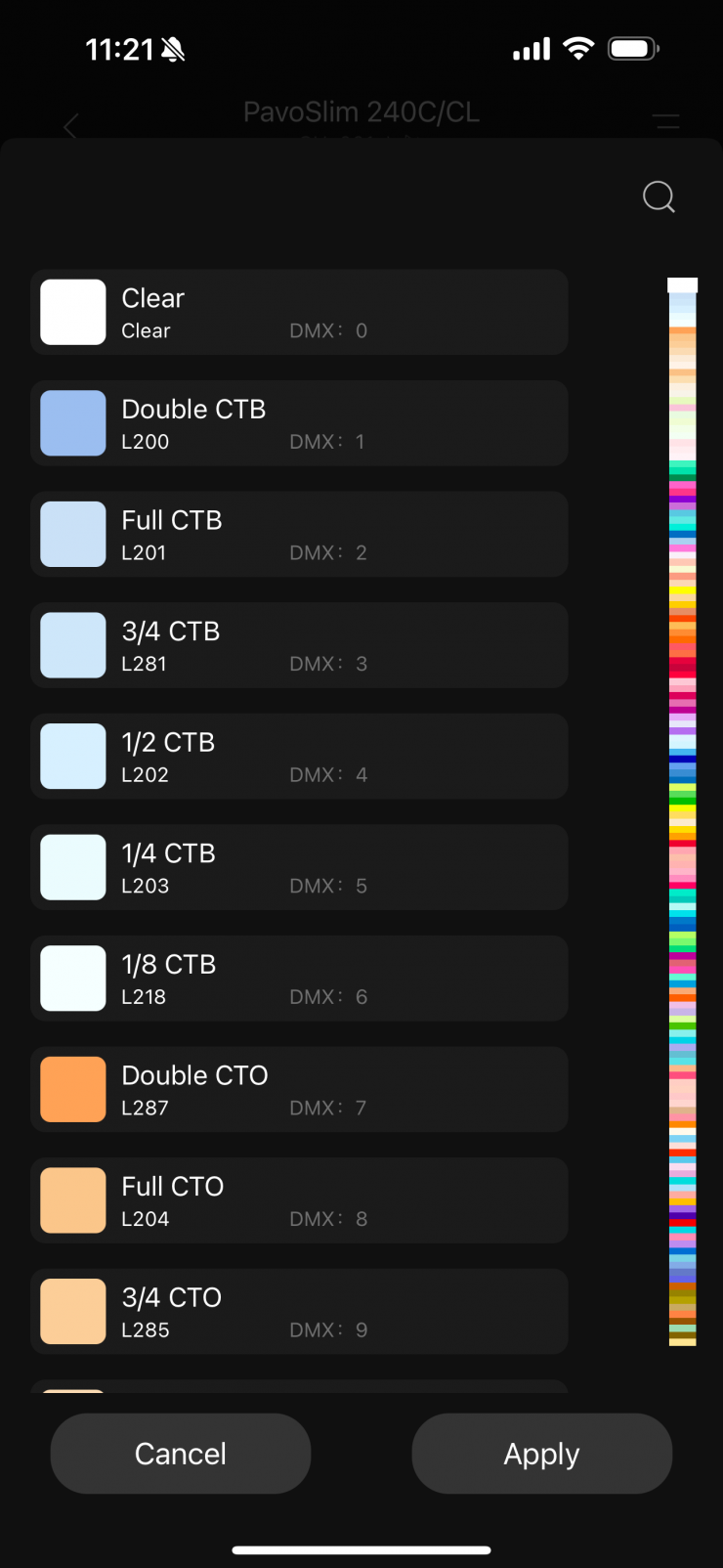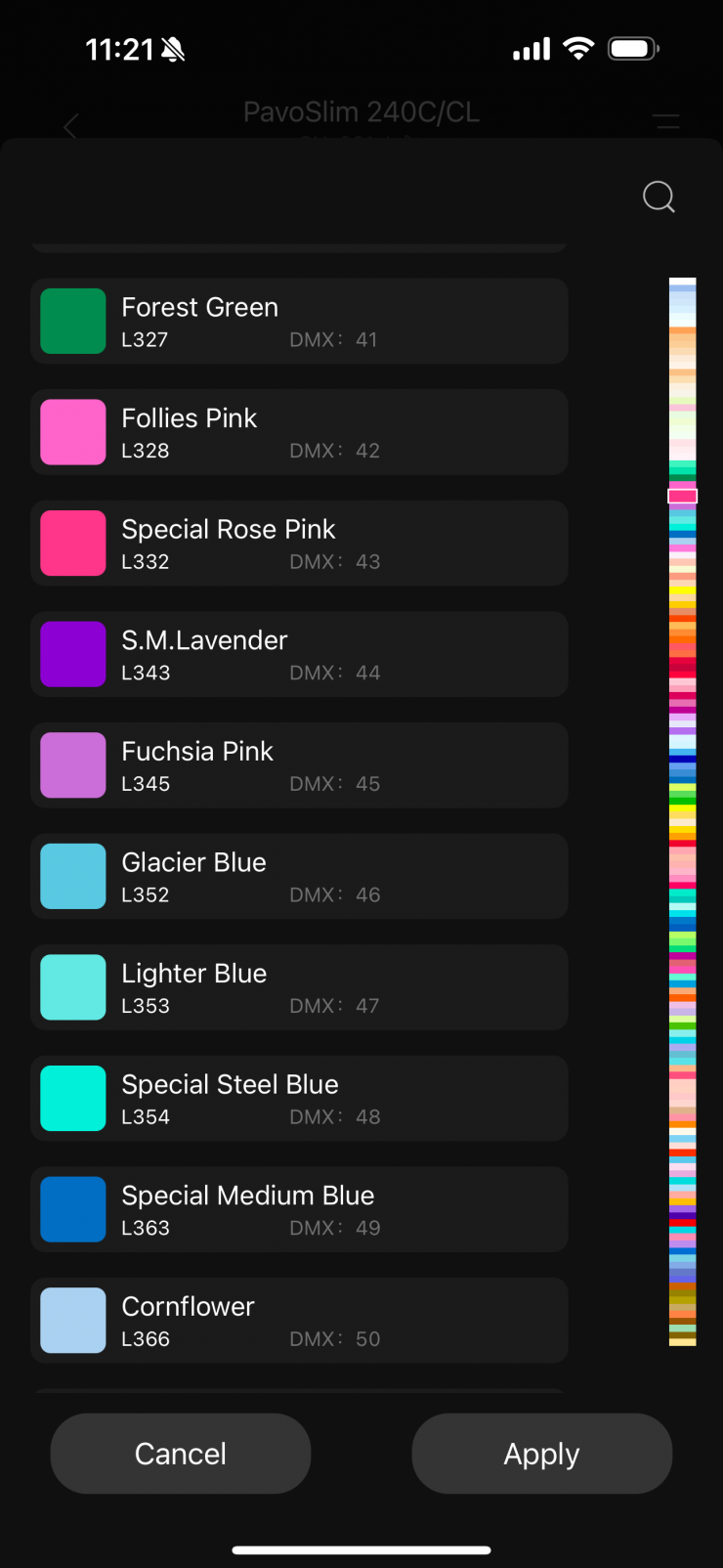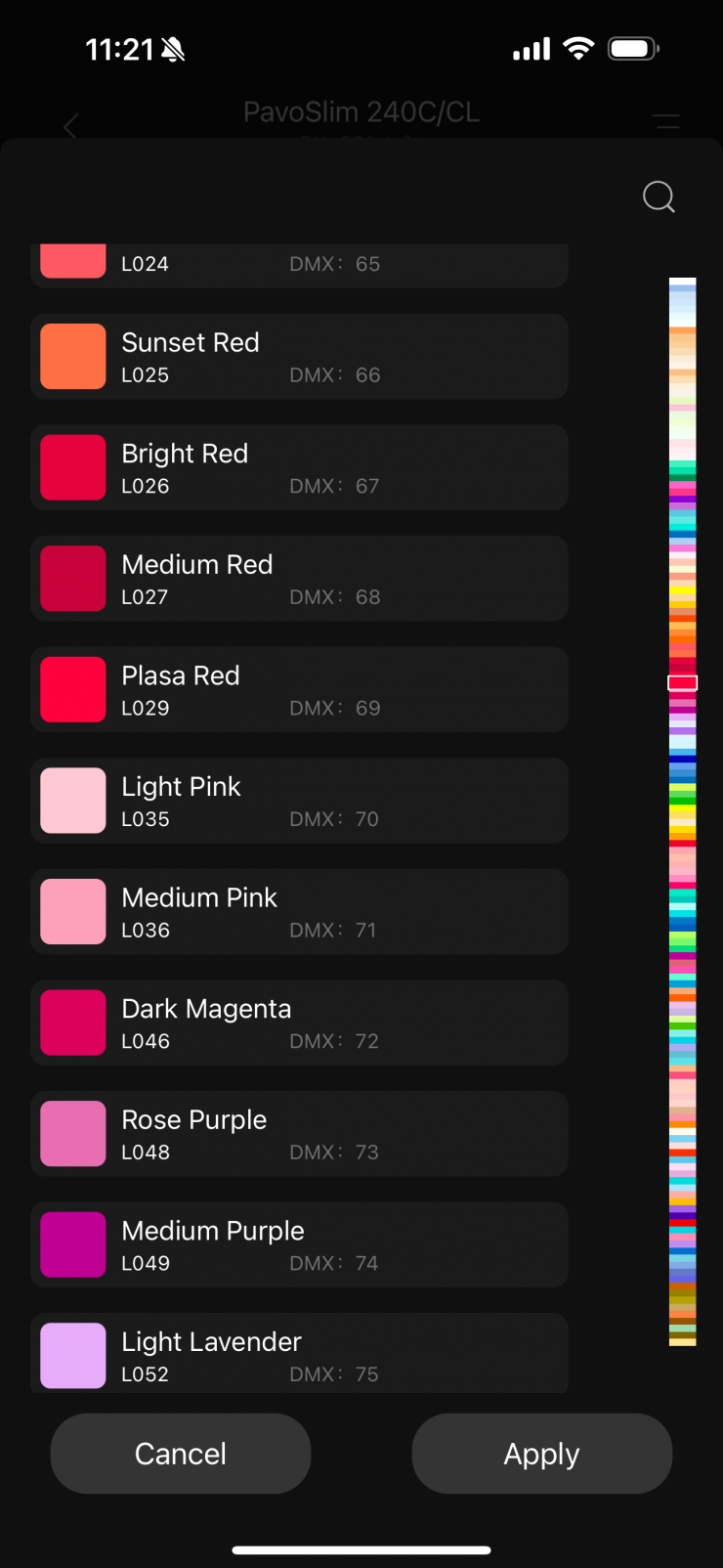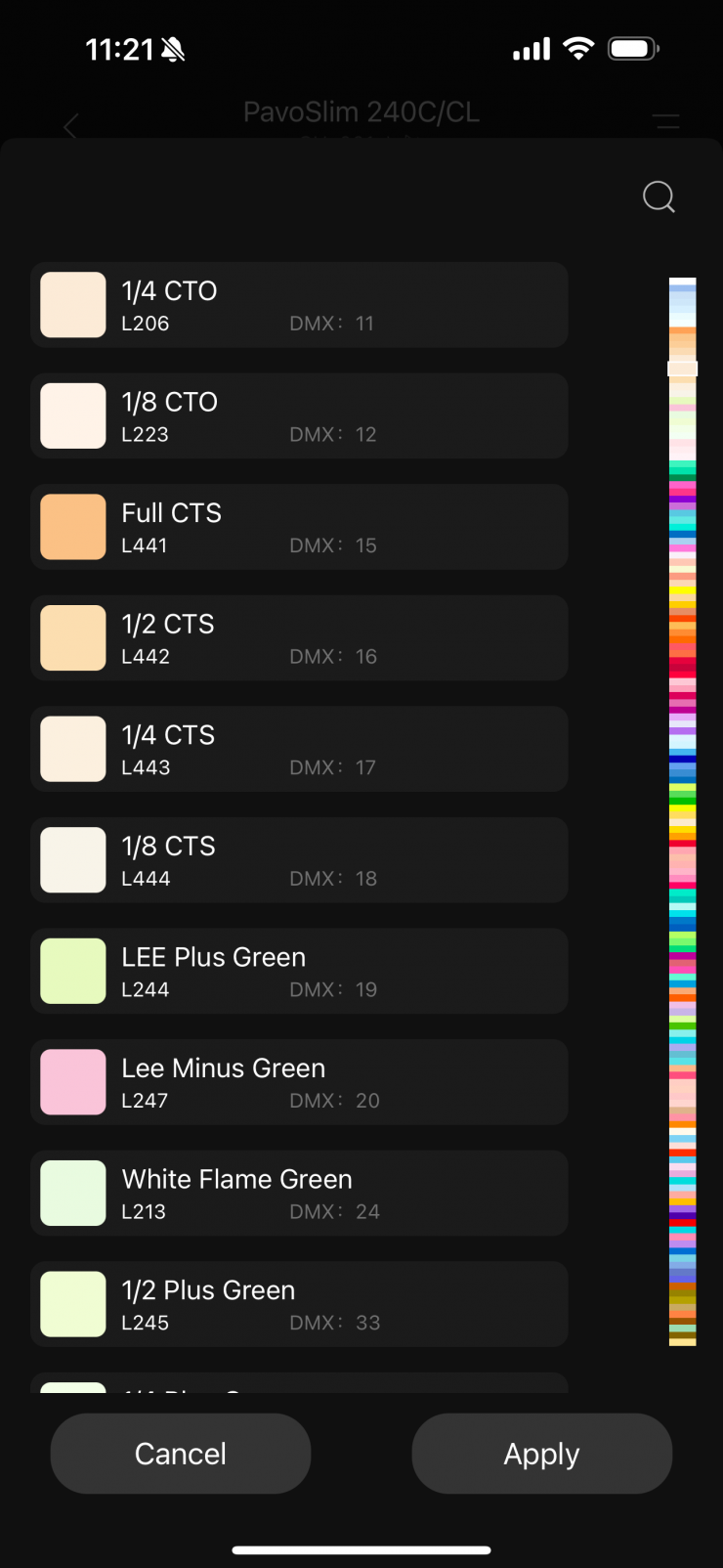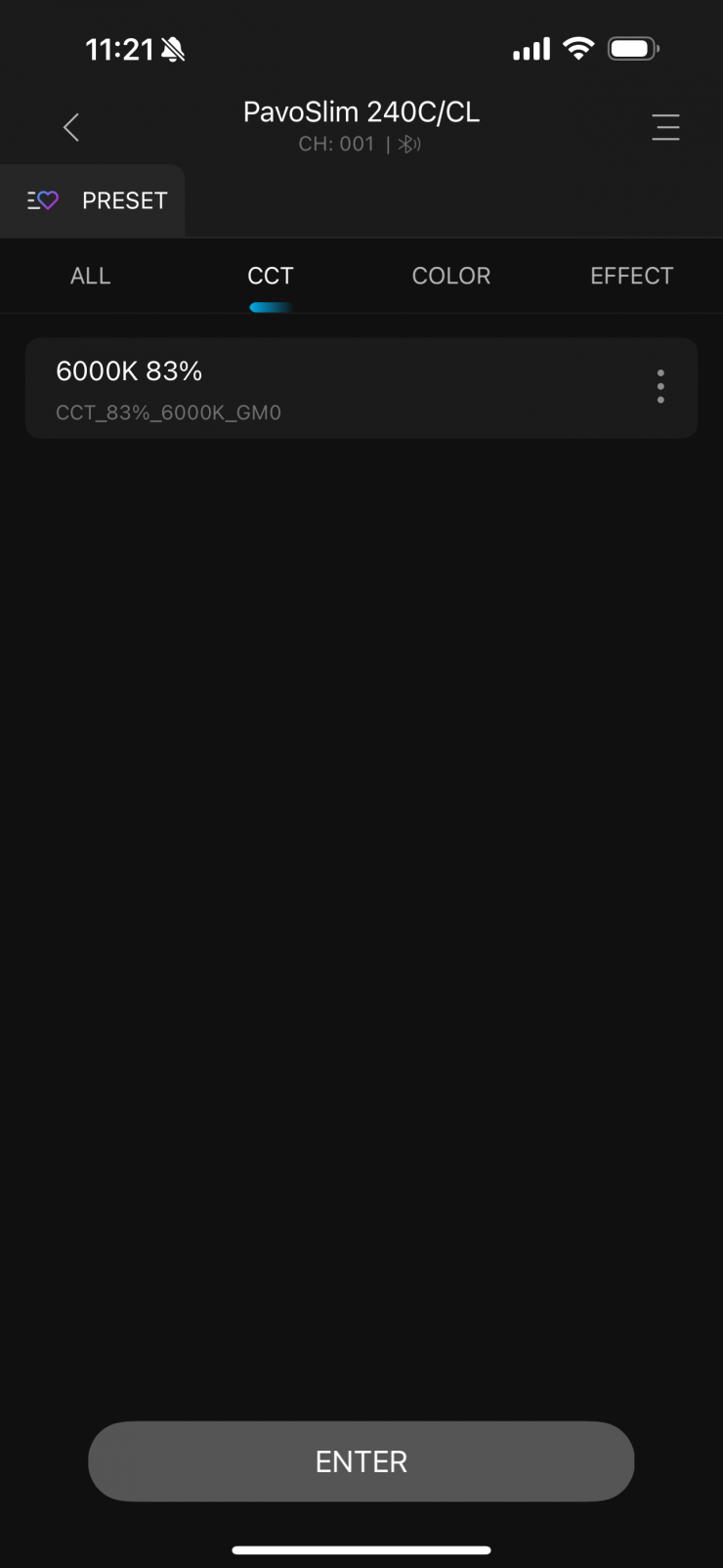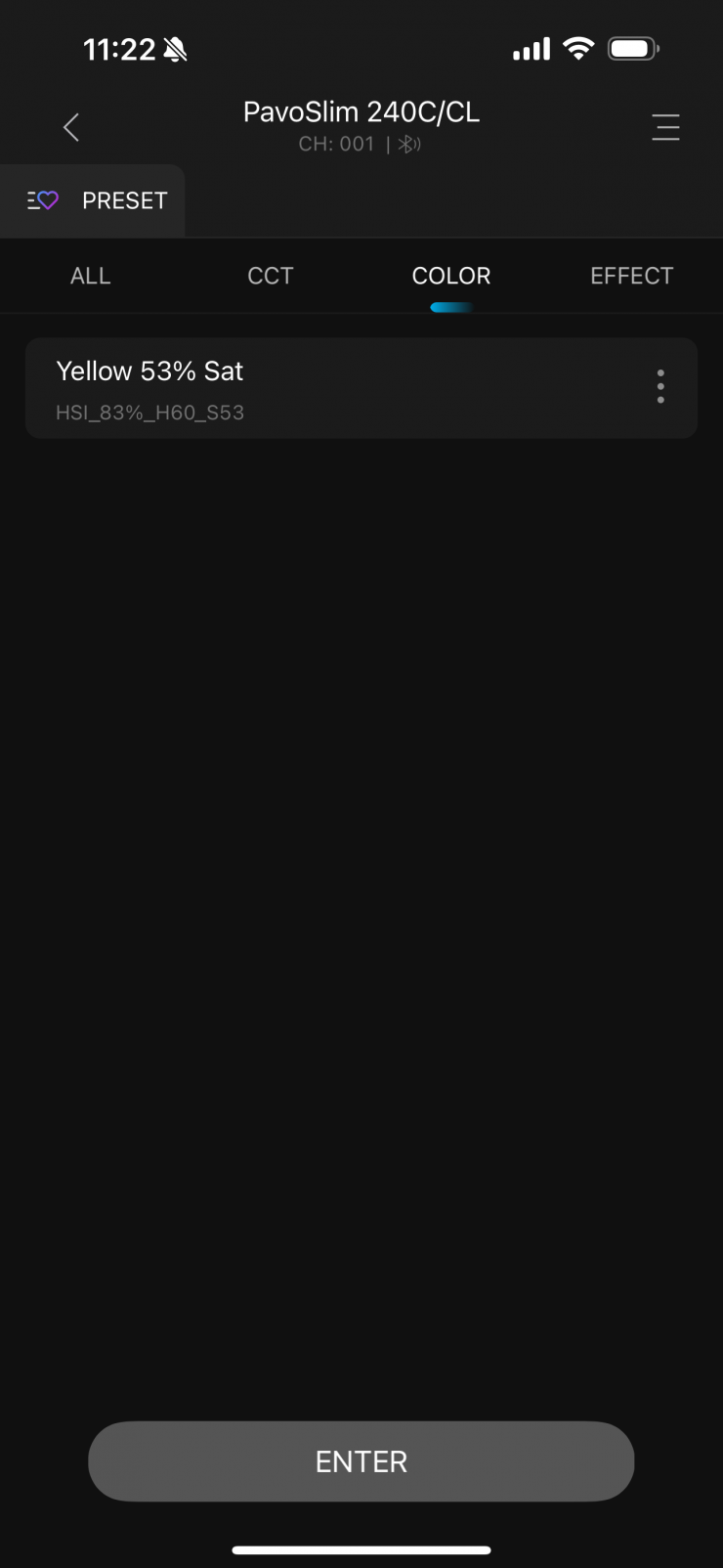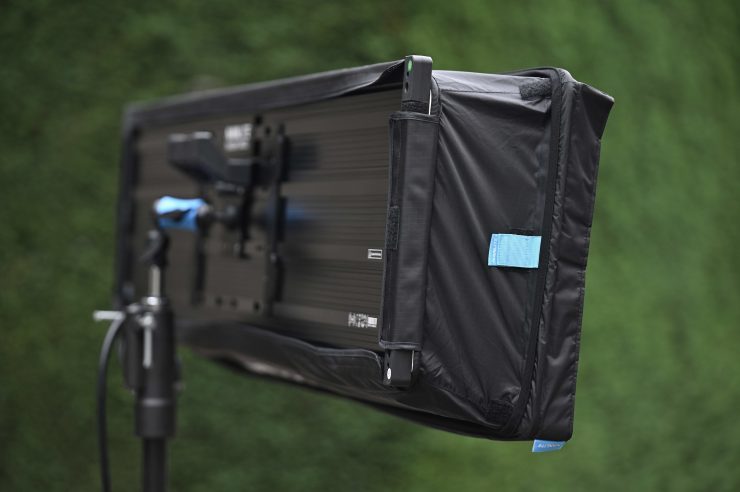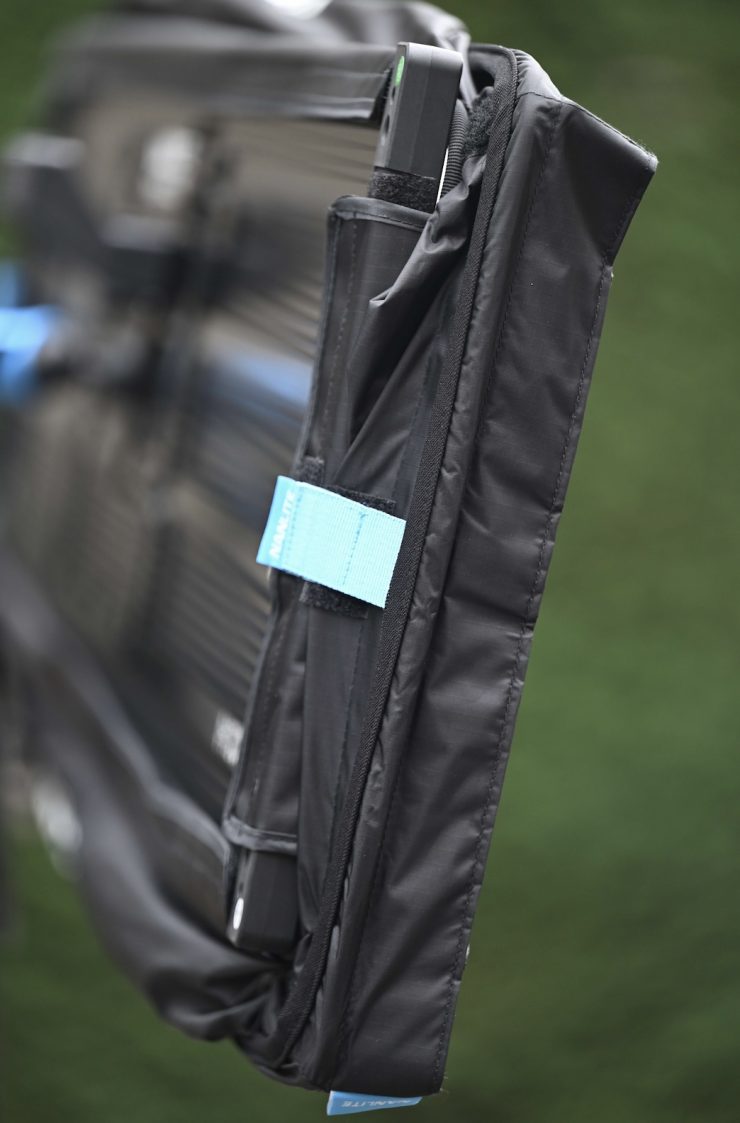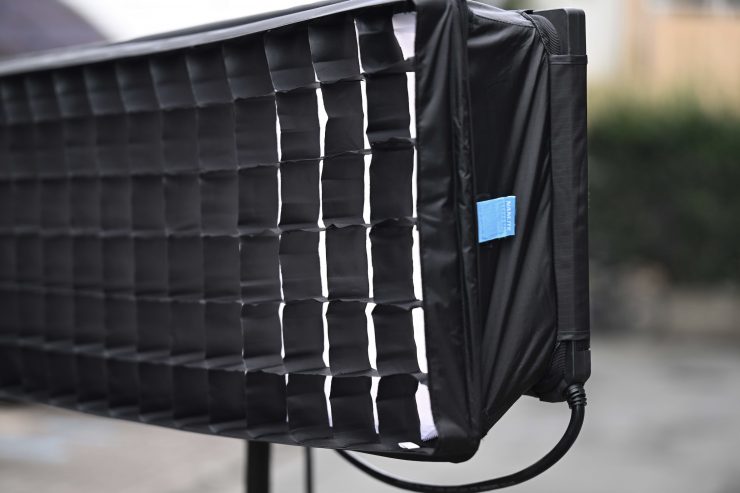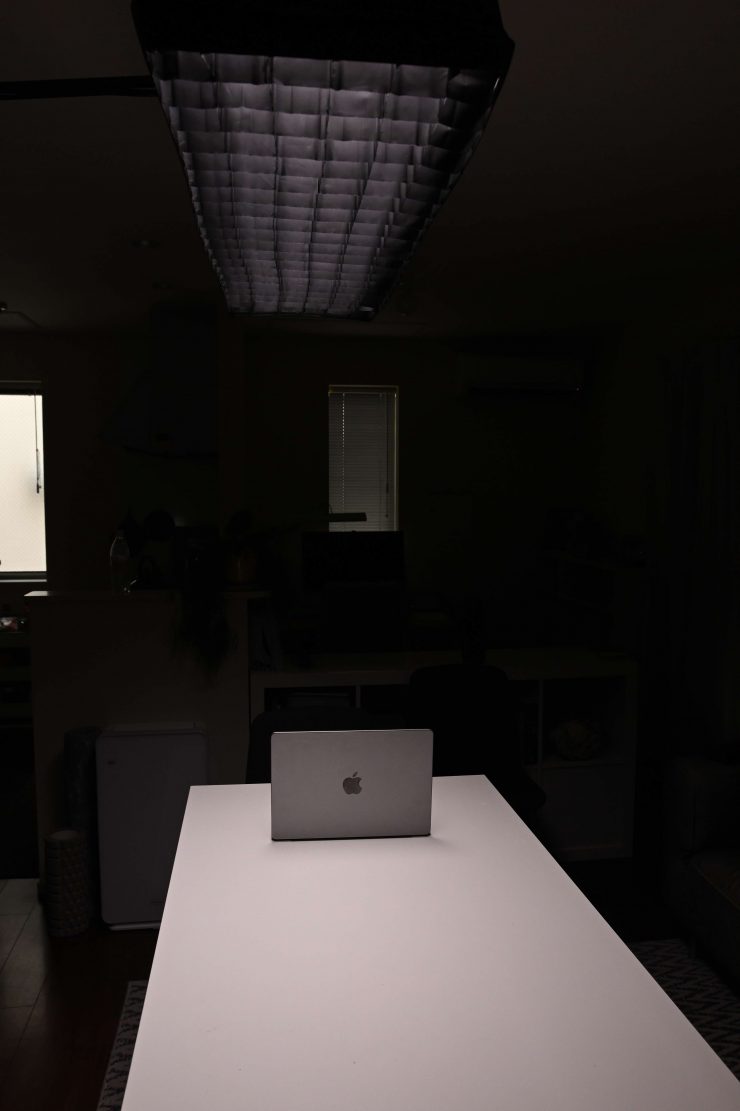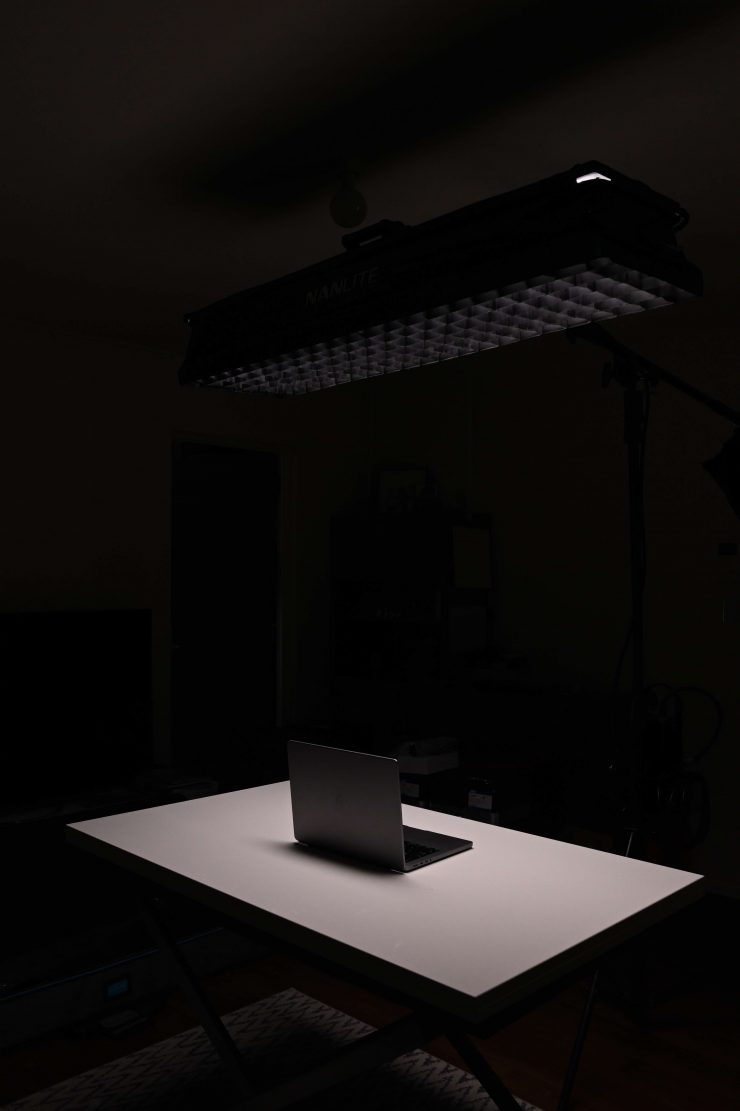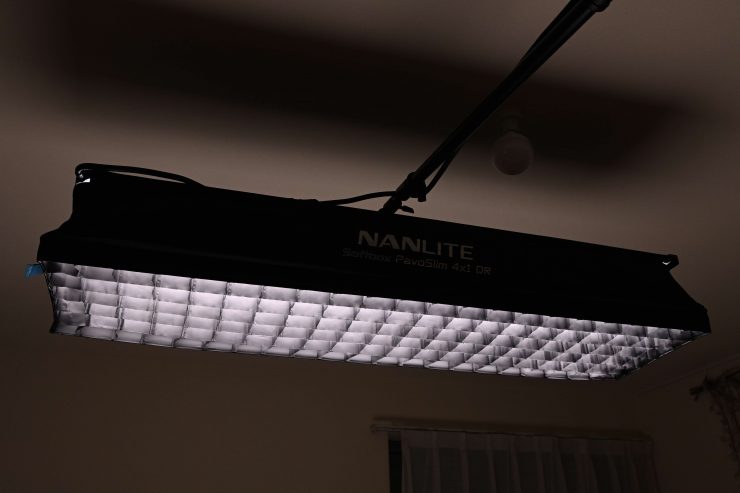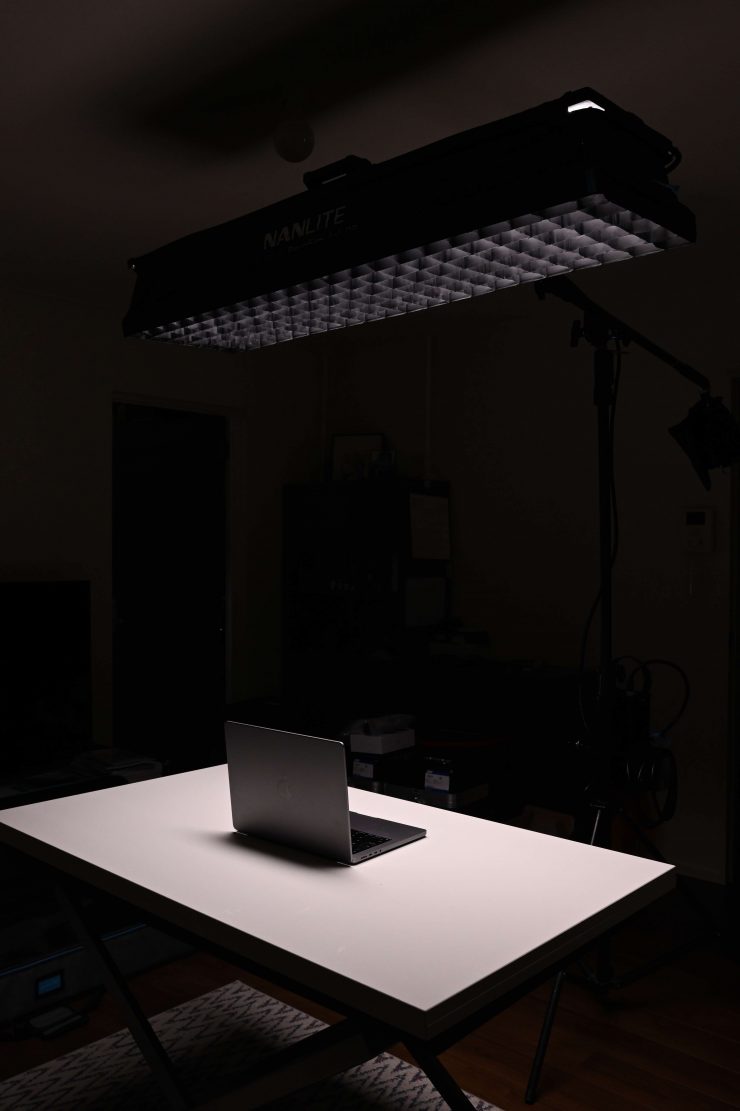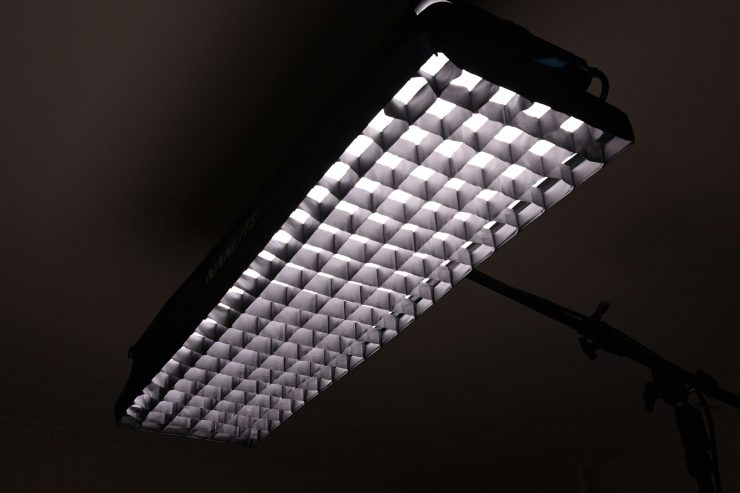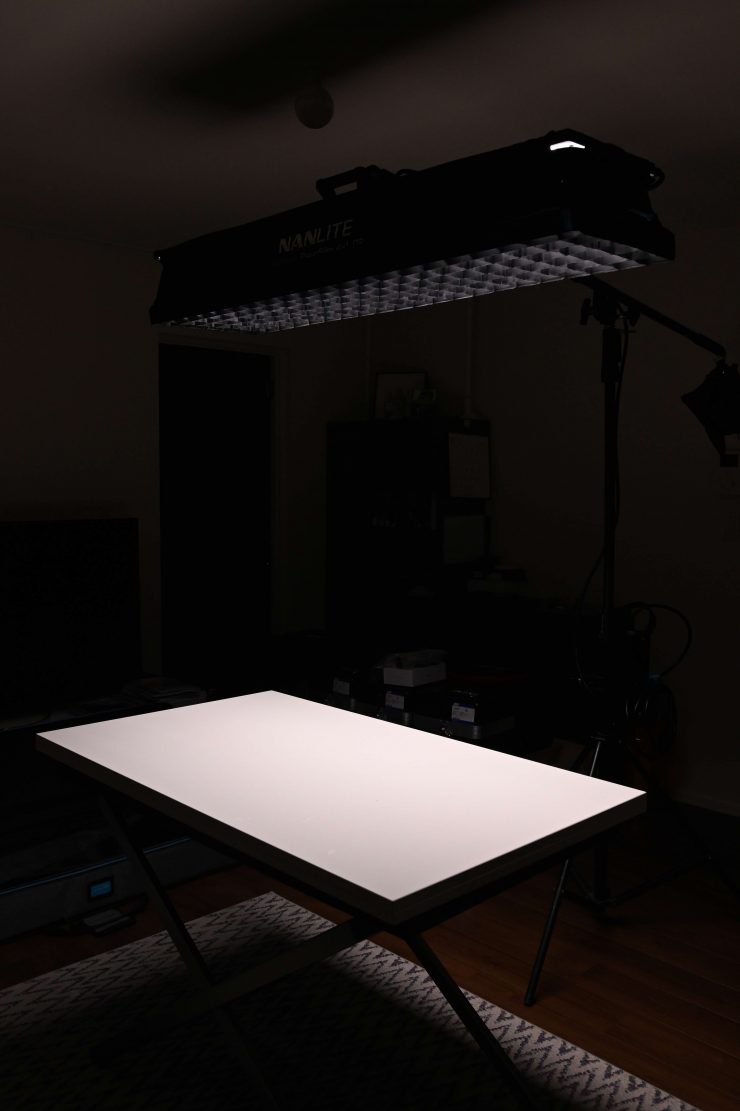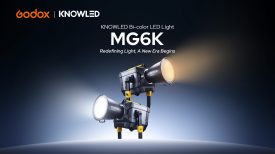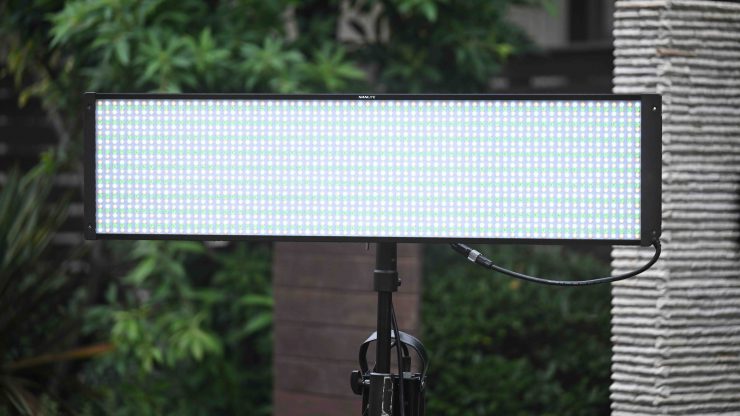
Nanlite’s PavoSlim panel lights are a hybrid mix of a flexible panel light and a traditional panel light. They utilize a lightweight hard backing material that is very thin, but robust. The latest addition to the series is the PavoSlim 240CL.
The 240CL is a slim, lightweight LED panel designed for lighting in tighter spaces.
The Nanlite PavoSlim range was designed to be lightweight and quick to set up with the versatility to be used for a wide range of lighting applications.
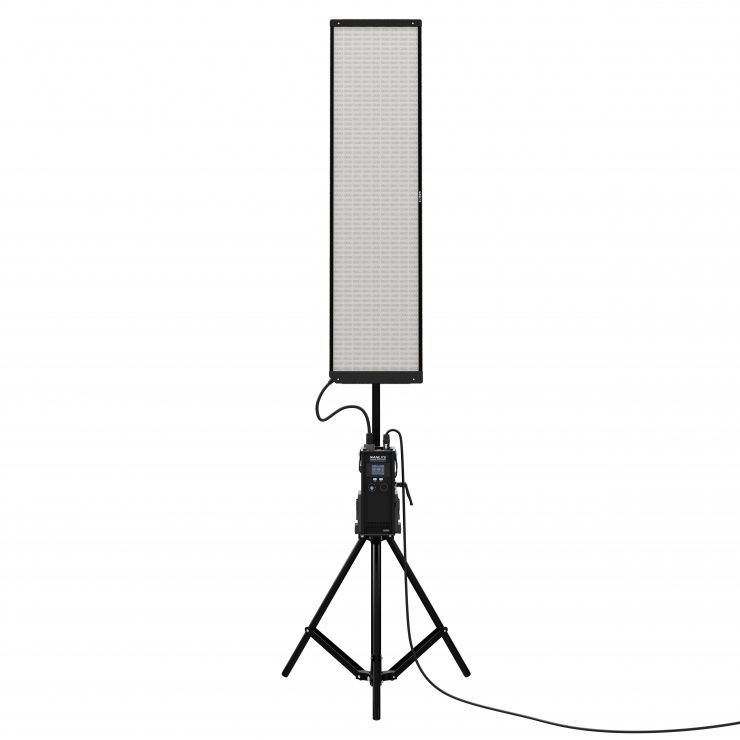
The PavoSlim 240CL is a 4×1 LED full-color panel light that draws 260W. It has a CCT range of 2700K to 7500K, with the added benefit of green/magenta adjustment.
Key features
- LED Full Color Panel Light
- 4’ × 1’ fixture body
- Delivers 21,030 lux @1m, 5600K with a rated power of 260W
- Wide CCT range of 2700K-7500K with ±150 green/magenta adjustment
- CRI/TLCI average 96/97, TM-30 Rf/Rg average 94/100, SSI 3200K: 84/5600K:74
- Intuitive operation with a two-inch screen, two buttons, and two knobs
- Included a pop-up softbox, universal holder, and baby pin holder
- Multiple control methods: On-board, Remote Controller, Nanlink APP, DMX/RDM, LumenRadio CRMX
- Multiple lighting modes: CCT/HSI/RGBW/GEL/EFFECT
- 15 lighting effects: HUE Loop, CCT Loop, INT Loop, Flash, Pulse, Storm, Police Car, TV, Paparazzi, Candle/Fire, Disco, Bad Bulb, Firework, Explosion and Welding
- Multiple power supply options: AC/DC/V-mount battery
Size & Weight
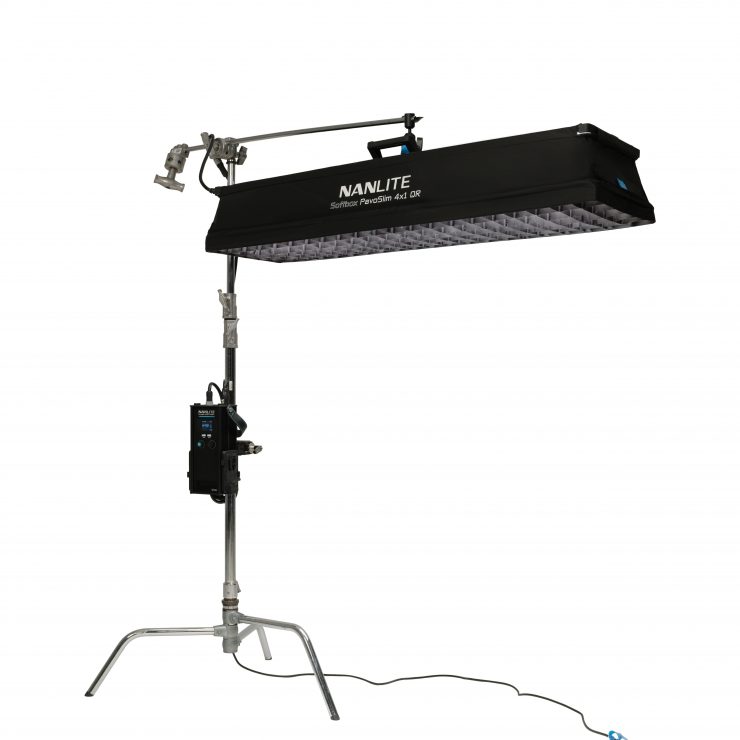
The dimensions of the PavoSlim 240CL make it ideal for use in confined spaces or areas with limited headroom. It can be used close to talent, hidden easily within a set design, or suspended from ceilings, and it would also work well in virtual production applications. The difference in length and width enables the fixture to provide a softer light on the long side and a harder light on the short side, allowing for flexible application based on needs.
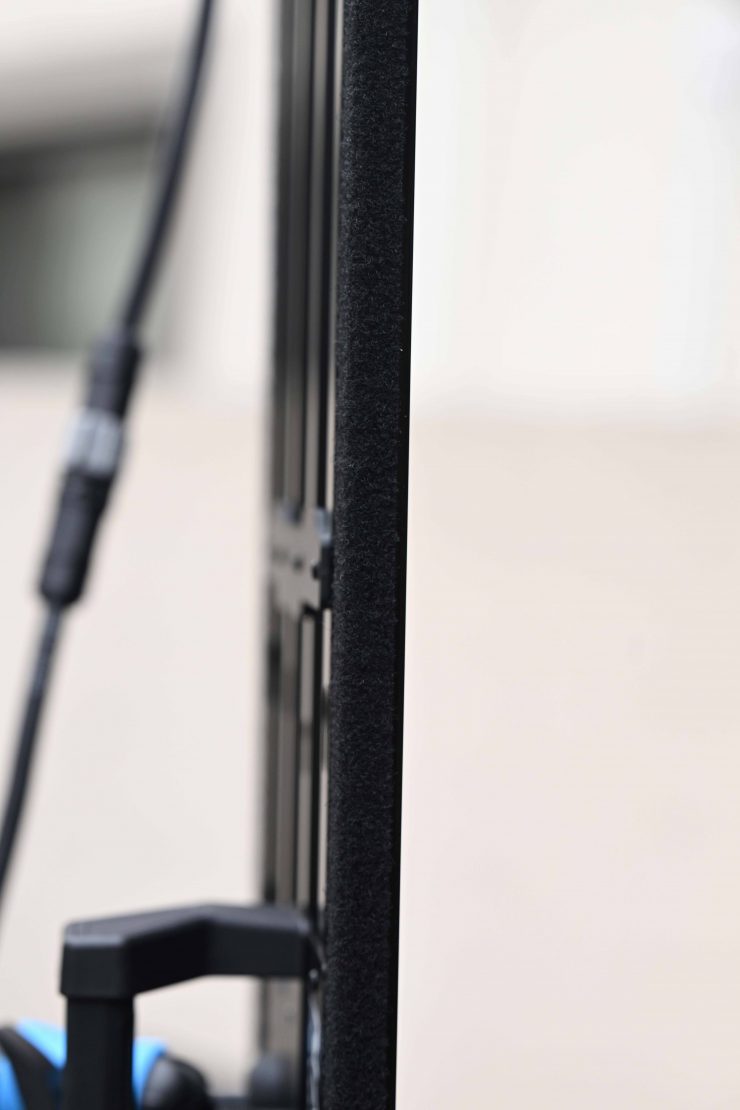
The PavoSlim 240CL has a thickness of just under 1 inch / 2.35 cm and it weighs 3.62 kg / 7.98lb.

The fixture is made from super light high-quality aluminum alloy, providing protection and heat dissipation.
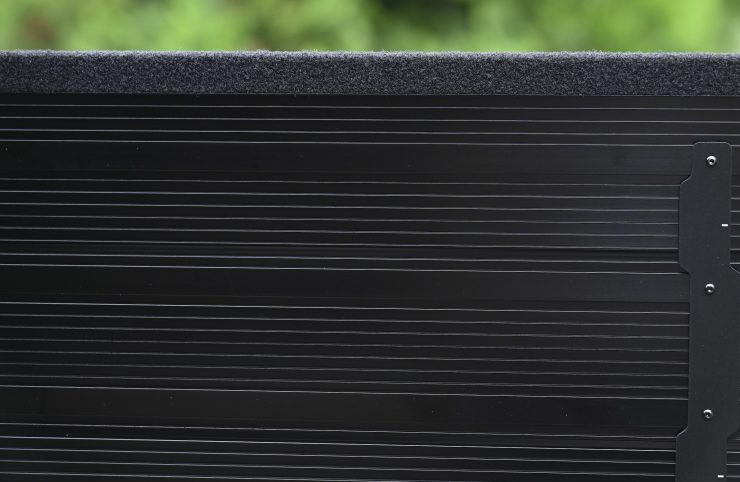
The rear of the PavoSlim 240CL features a large multi-row heat sink for structural strength and efficiently moving heat away.
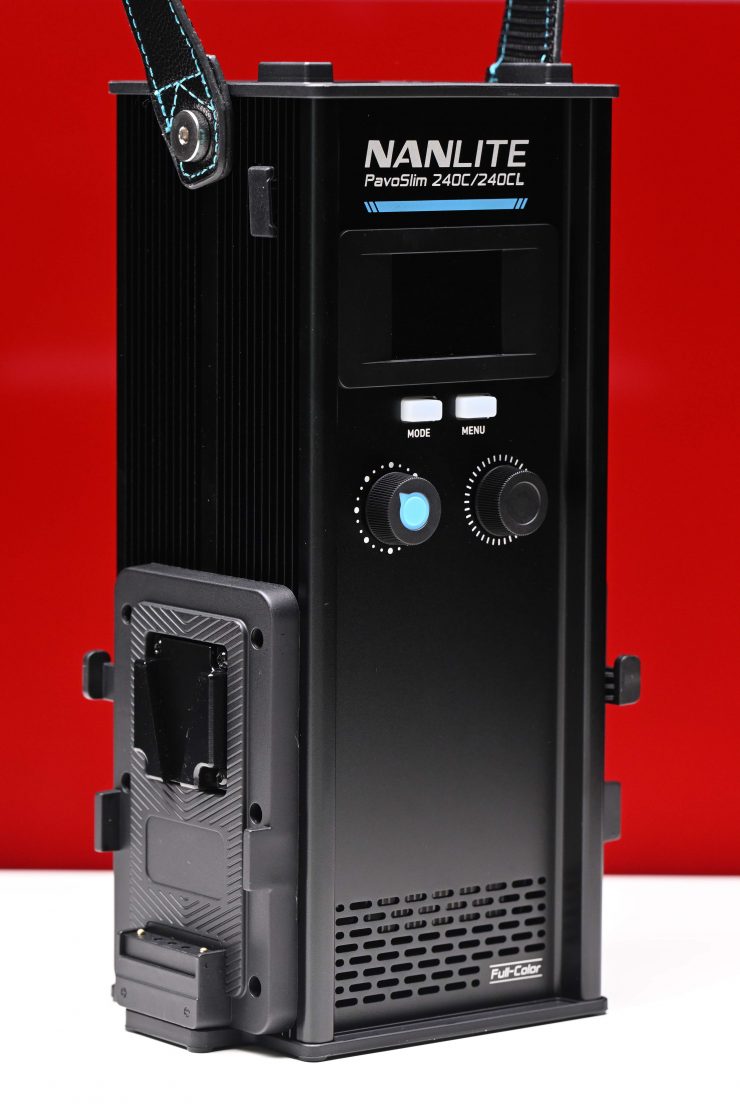
The light utilizes a separate power supply/controller and features V-mount battery plates. The power supply/controller weighs 6.08 lb / 2.76 kg.
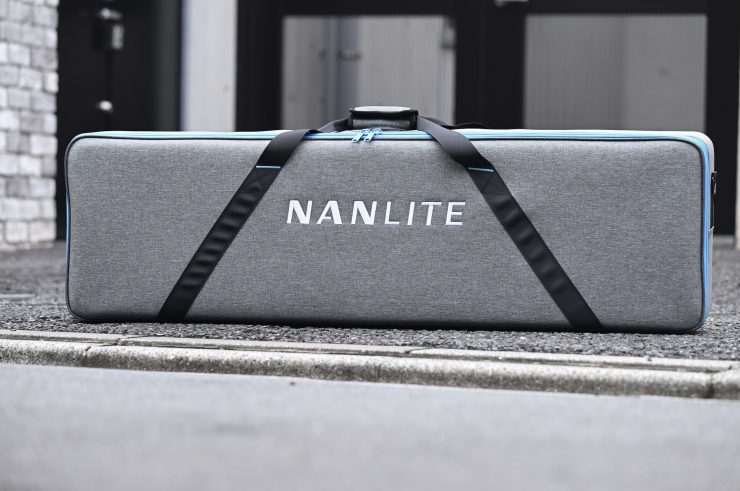
In its included case, it weighs 15.5 kg / 34.17 lb.
| WEIGHT (Controller/Power Supply & Panel) | |
| Nanlite PavoSlim 240CL | 14.04 lb / 6.38 kg |
| Nanlite PavoSlim 60C | 5.09 lb / 2.31 kg |
| Nanlite PavoSlim 120C | 7.94 lb / 3.6 kg |
| Westcott Flex Cine 100W Bi-Color Set (1 x 3′) | 5.1 lb / 2.27 kg |
| Intellytech Mini Mega-3FC Litecloth 3.0 RGB LED Flexible Mat | 17 lb / 7.7 kg |
| Litegear LiteMat Spectrum 2L RGB LED Light Panel | 14.33 lb / 6.52 kg |
So how does the weight of the PavoSlim 240CL compare to some other flexible and hard-backed solutions on the market? Well, above you can see.
Easy to travel with?
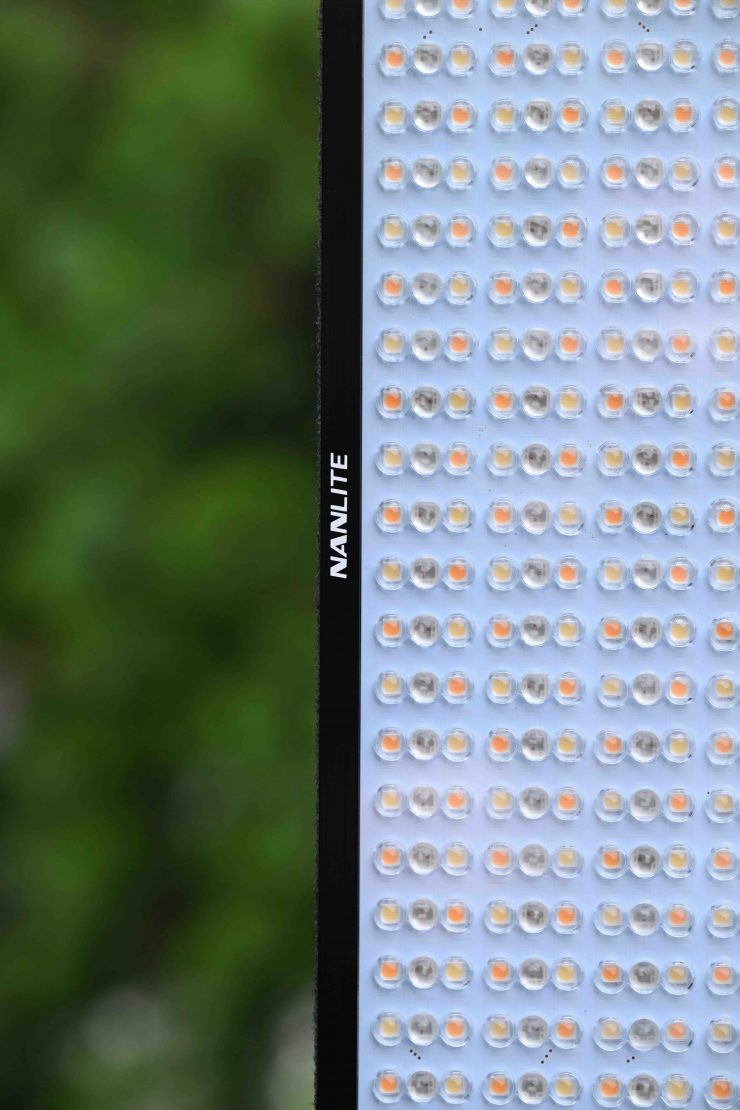
The PavoSlim, as I previously mentioned, are not flexible LED panels that you can fold up to make smaller. They are more like LiteMats as they have a hard backing plate. For anyone who travels a lot, the PavoSlim 240CL may arguably not be the best option given its physical footprint. If you want something for travel and you need to keep a small footprint, then the PavoSlim 120C/60C is arguably going to be a better option.
Power Draw

The Nanlite PavoSlim 240CL draws 240W. This isn’t a massive amount and it means that you can run the fixture at 100% output using two flight-safe 14.4V or 26V batteries. This is handy for anyone who travels a lot and needs to run the lights remotely.
| POWER DRAW | |
| Nanlite PavoSlim 240CL | 240W |
| Nanlite PavoSlim 60C | 72W |
| Nanlite PavoSlim 120C | 150W |
| Westcott Flex Cine 100W Bi-Color Set (1 x 3′) | 100W |
| Intellytech Mini Mega-3FC Litecloth3.0 RGB LED Flexible Mat | 200W |
| Litegear LiteMat Spectrum 2L RGB LED Light Panel | 100W |
So how does this power draw of the PavoSlim 240CL compare to some of the competition? Well, above you can see.
RGBWW

The PacvoSlim 240CL is RGBWW and not RGBACL. Lights that utilize RGBACL don’t use any white LEDs, instead, they mix all of those different color LEDs to produce white light. Hive Lighting has also been using 7 LED-chip blending. Instead of the traditional 3 colors, Hive uses red, amber, lime, cyan, green, blue, and sapphire. The advantage RGBACL has over RGBWW is that it is capable of giving you a larger CCT range and it can produce more saturated colors with more output. RGBWW lights tend to struggle to create saturated colors like yellow and they don’t always have as much output when generating saturated colors. They can also have a large drop-off in output at different CCT settings.
There is a lot of debate and argument over what is better. Certain companies will tell you that RGBACL is better, while others will tell you that RGBWW is better. I don’t have any horses in this race, so I am not influenced by what lighting companies say. All my reviews are based on data and facts, and every light gets the same unbiased treatment regardless of who makes it or how much it costs.
I am not a fanboy of any one particular brand who is going to give you a biased assessment of a light. I have seen, used, and reviewed hundreds of lights over the years so I think I have a pretty solid background in giving you a professional opinion that isn’t influenced by marketing hype.
What do you get?
The lighting kits consist of:
- Nanlite PavoSlim 240CL RGB LED Panel with Pop-Up Softbox
- Control Unit
- Baby Pin Mount
- Swivel Holder
- Quick Release Clamp
- DC Connection Cable (8.5′)
- AC Power Cable (14.7′)
- Pop-Up Softbox
- Lite Diffuser
- Standard Diffuser
- Egg Crate Grid
- Padded Carry Case
- Limited 2-Year Manufacturer Warranty
- Registration Extension: 1-Year
The case for the PavoSlim 240CL with everything inside weighs 33.95 lb / 15.4 kg.
The case the light comes is pretty well made and in line with other Nanlite products, but I’m in no position to comment on how it would handle the rigors of air travel. That is something you would only find out over time. The case does come with the light, so you can’t really complain. You can use it if you want, or if you prefer another option you can decide what works best for you.
If you are going to use the case for the PavoSlim 240CL then I would put other items inside there to maximize the space. It is actually long enough that you could easily sneak in a light stand, extension cables, and a few batteries to have a reasonably fully self-contained lighting set-up.
Build Quality

The overall build quality of the Nanlite PavoSlim 240CL, just like the 60c and 120C, is solid. The backing plates are made out of metal and are nicely made. The problem I have found in the past with flexible panel lights is that they don’t tend to hold their shape well and you have to be careful folding them because you can end up killing some of the LEDs. With hard-backed lights, you don’t get those issues.
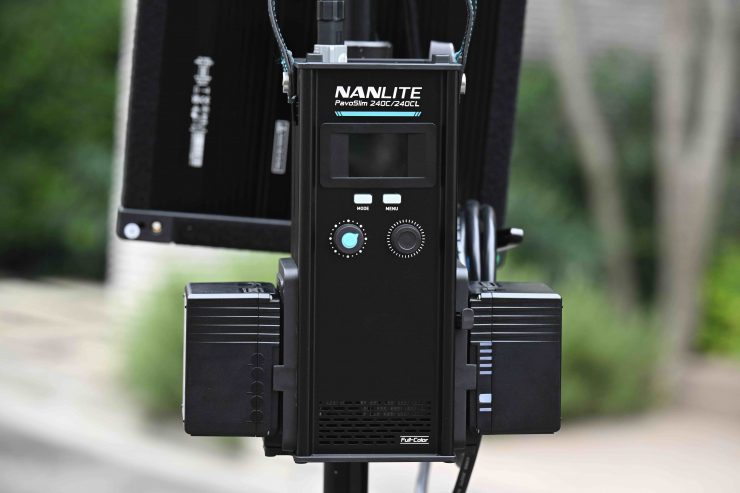
The power supply/control unit is robustly constructed and all of the connections are solidly made.
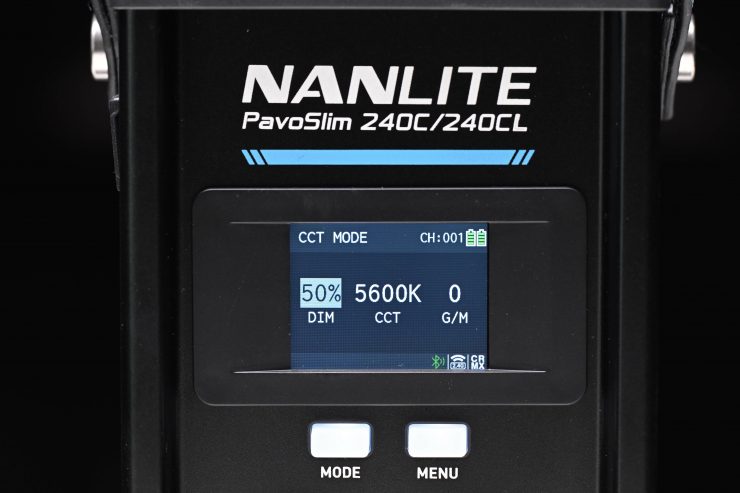
The power supply/controller features a nice color display on the front and it is very easy to see and it shows you clearly and concisely what your operating parameters are. Yes, it is fairly basic, but it gets the job done.
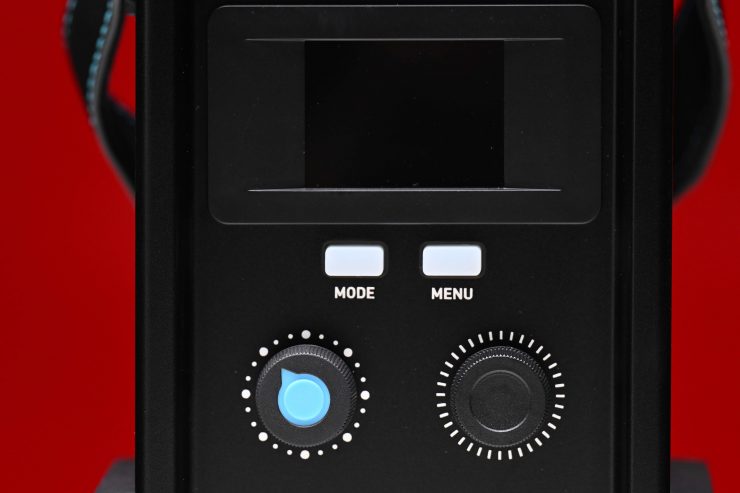
The buttons and dials are tactile and easy to use and are also solidly made.
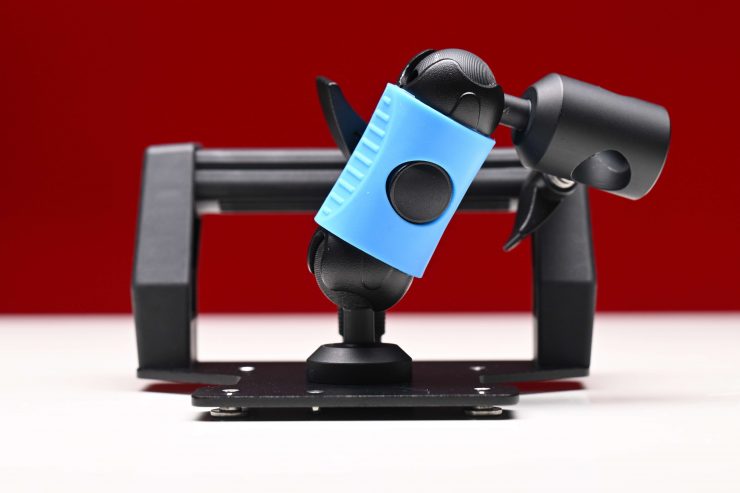
The mounting plate system has been well thought out and designed and I like how Nanlite gives you two backing plates.
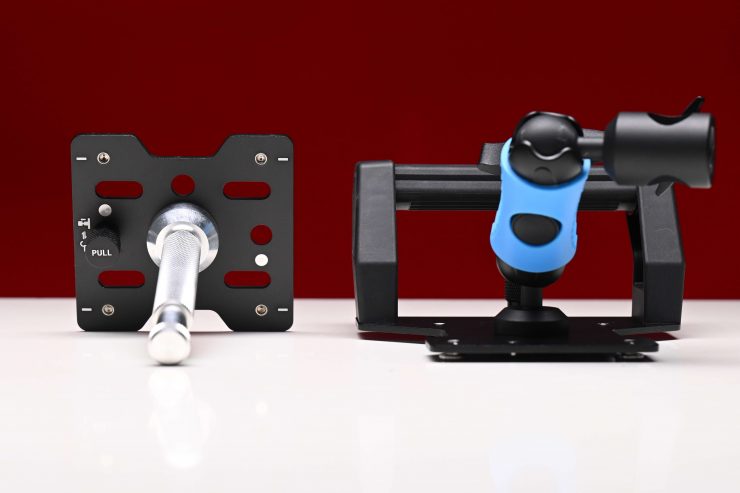
One features a straight pin, while the other has an adjustable mount if you need to angle the lights.
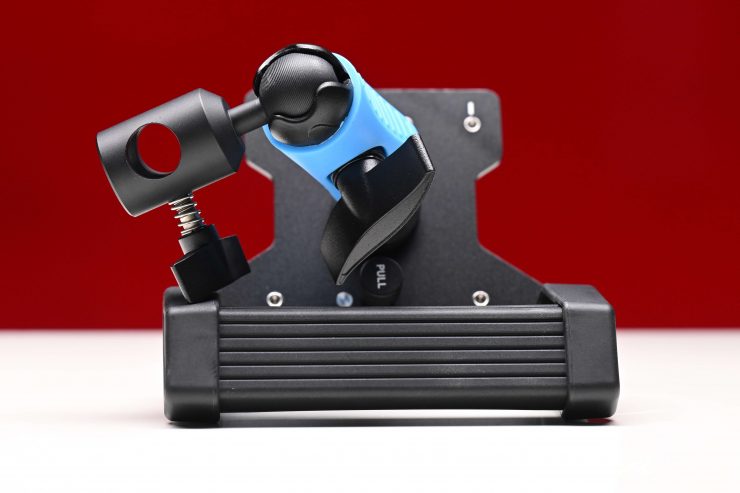
It is also nice that one of the mounting plates features an integrated handle.
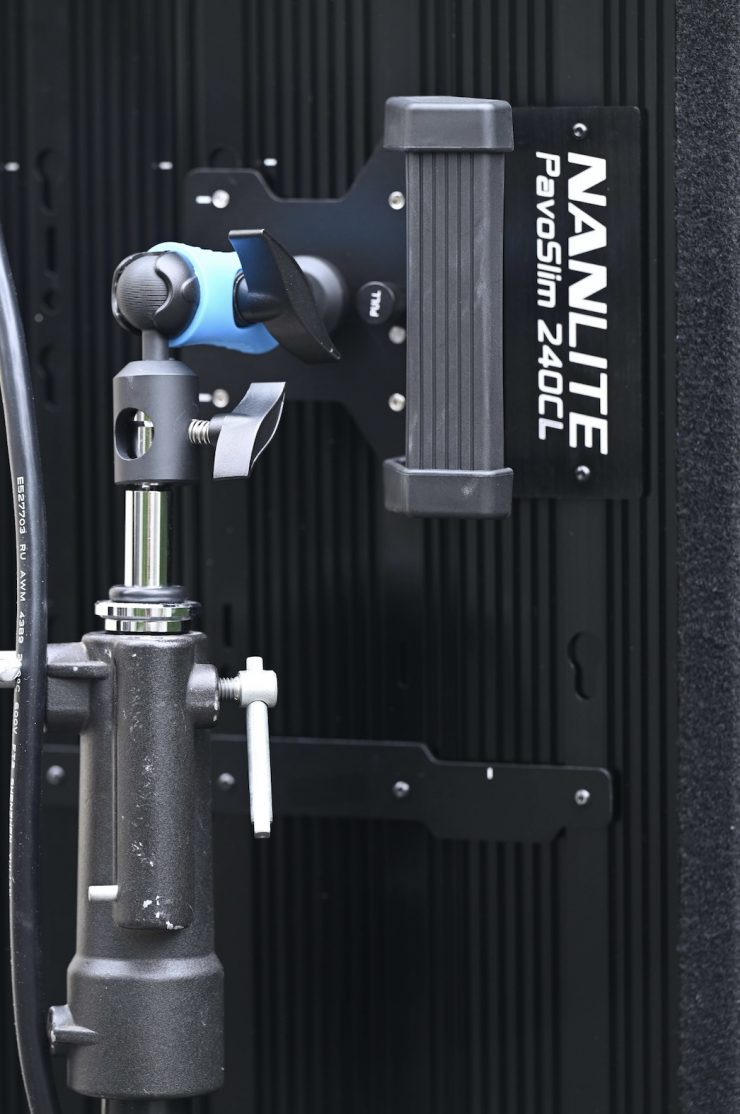
This is a really robust mounting system and it gives you complete confidence that the light won’t detach from the plate.
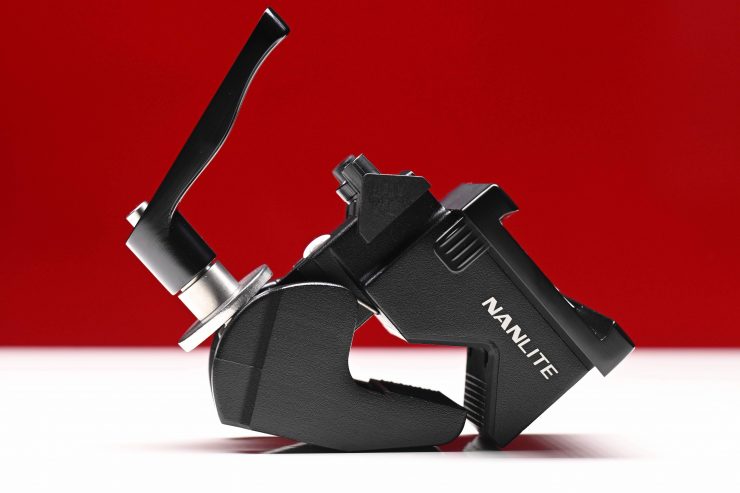
The lights also come with a clamp that has a V-wedge receptor on it if you need to attach the power supply/controller to a lightstand.
Power Supply/Controller
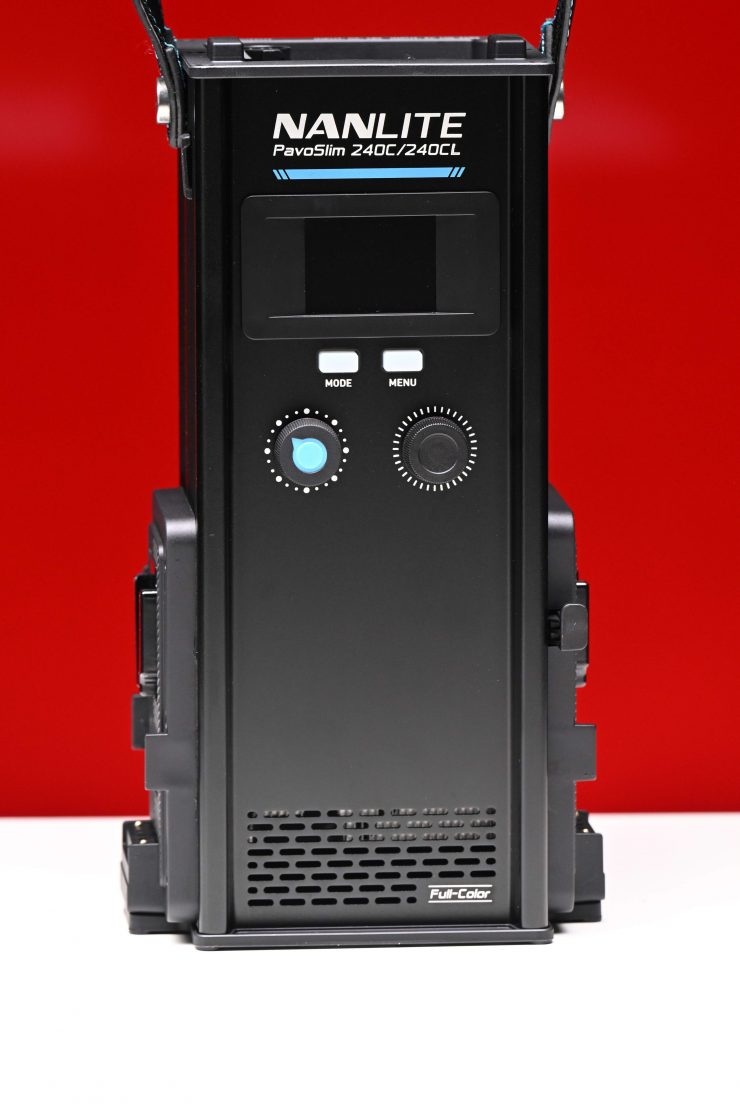
As I previously mentioned, the PavoSlim 240CL comes with a separate power supply/controller.
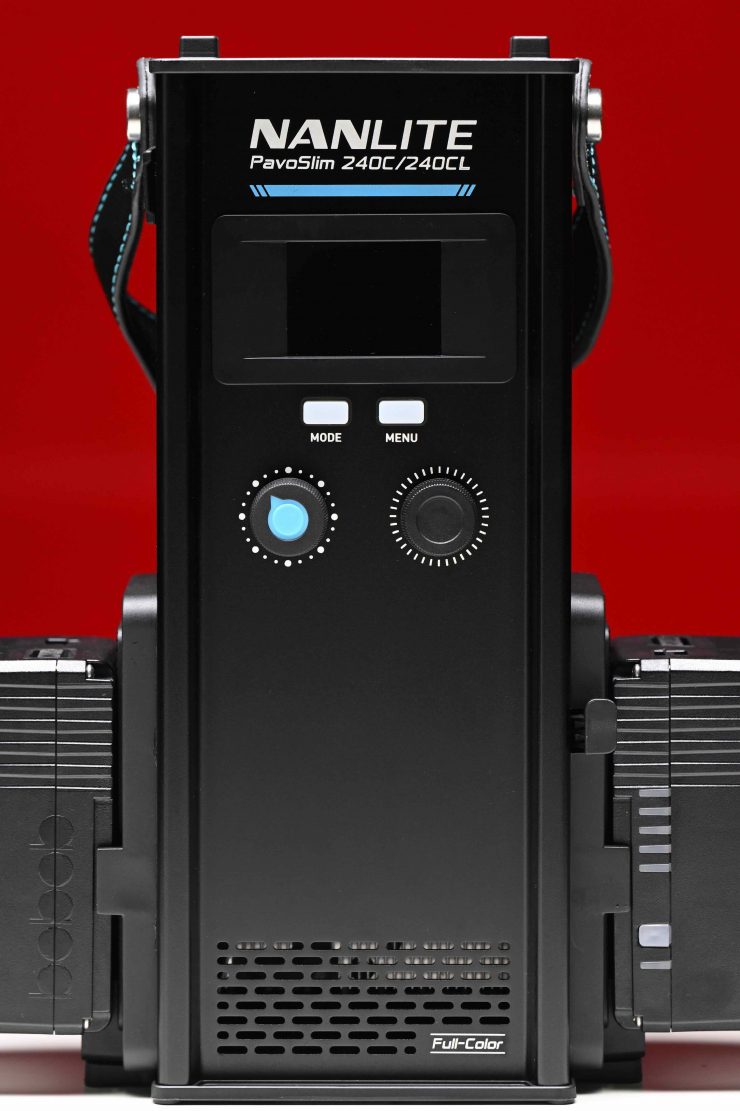
The power supply/ controller just has two V-mount battery plates. The plates allow you to run either a 14.4V or 26V batteries.

The power supply/controller is very intuitive and straightforward to use. You can clearly see all of the parameters on the display screen. There is nothing overly complicated about the operation.
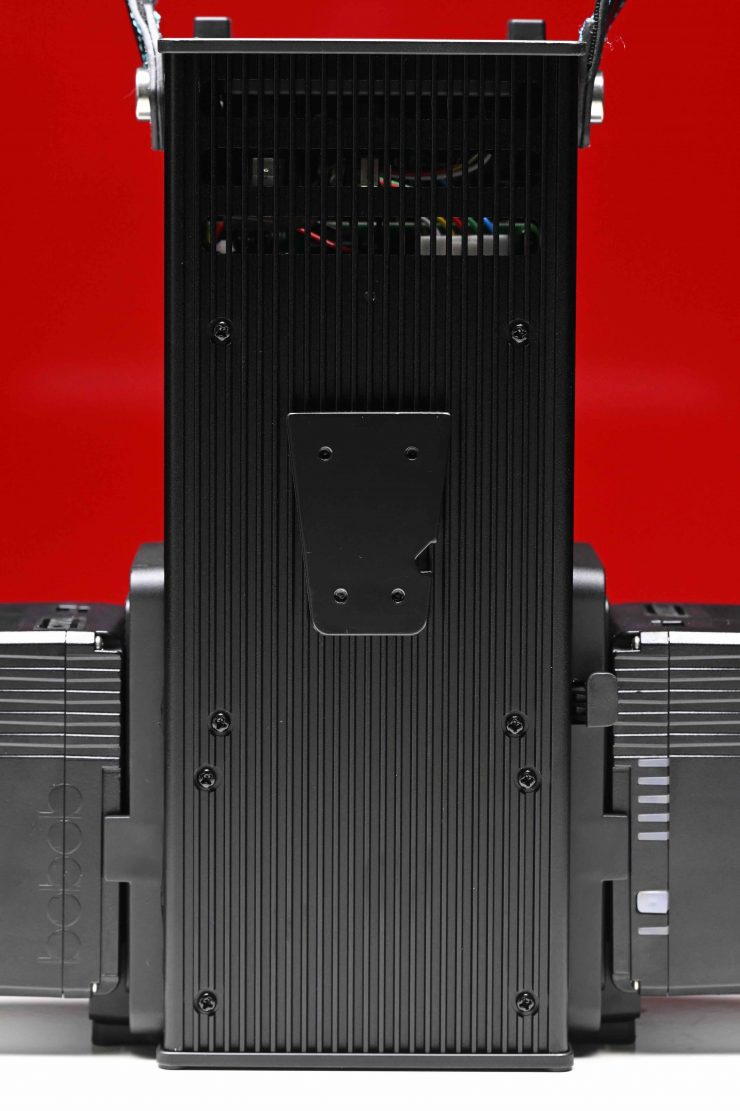
The power supply/controllers feature a little V-mount style receptor quick-release plate on the side. You can use the included clamp mount to attach the power supply/controller to a lightstand.
I like that Nanlite includes an extra long head cable that goes from the light to the power supply/controller so when you have the light out on a boom arm you can put the power supply/controller on the ground because the cable is long enough.
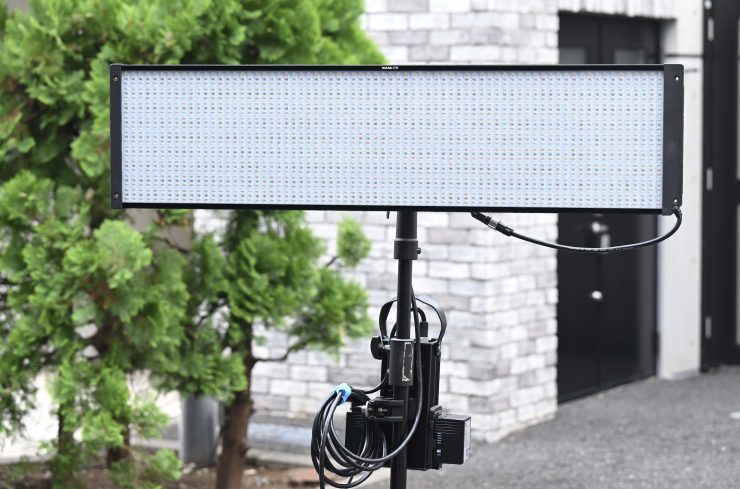
On paper, one of the appeals of the PavoSlim 240CL is that you can power it from two flight-safe batteries. While this is advantageous if you are traveling a lot, the physical size and weight of the 240CL may not make it the best option.
LED mats are great because they are compact and lightweight, but they still require power like any other light. They can’t magically produce a lot of output without a fairly large power supply. I like that Nanlite has managed to keep the weight of the power supply/controller to a minimum.
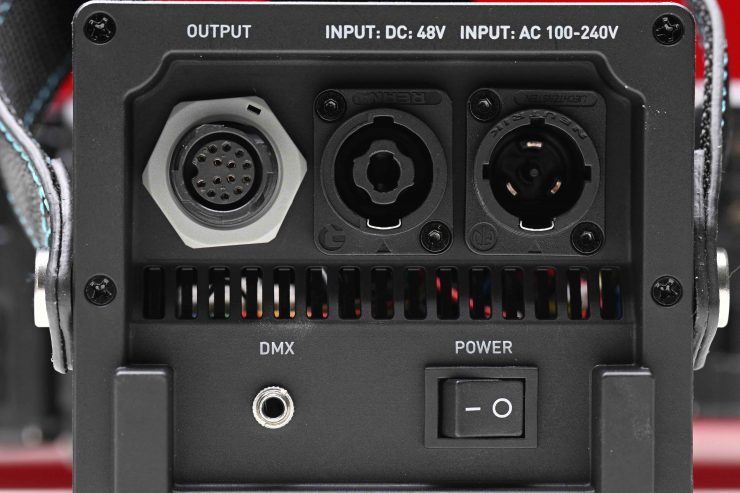
The PavoSlim 240CL Power Supply/Controller has the following inputs & outputs:
- 1x Power Output
- 1 x USB-A Female Service Input
- 1 x powerCON AC Power Input (110 to 240 VAC, 50 / 60 Hz)
- 1 x DMX Input
The power supply/controller does have an in-built fan, however, there are no fan controls or options.
The fan noise is basically non-existent and the light is extremely quiet which is fantastic.
Control
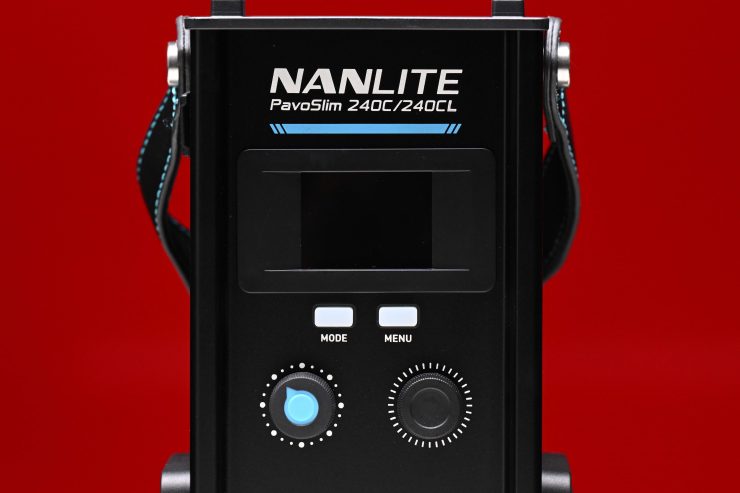
The power supply/controller has two large dials that you use to navigate between modes and to make adjustments.
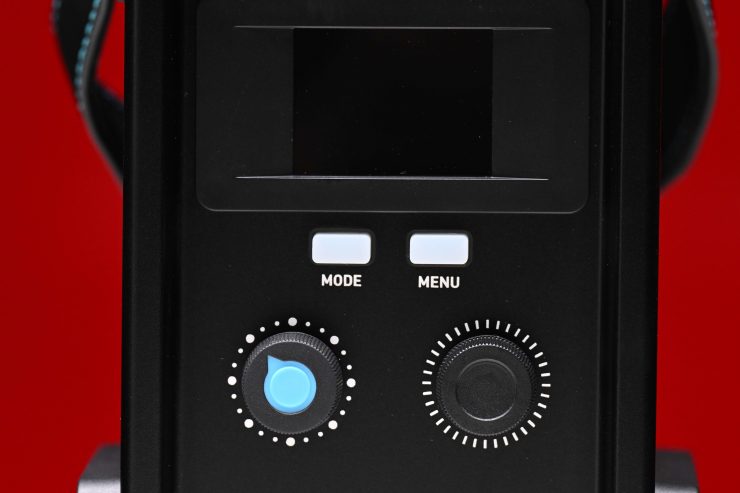
There are also two buttons:
- MODE
- MENU
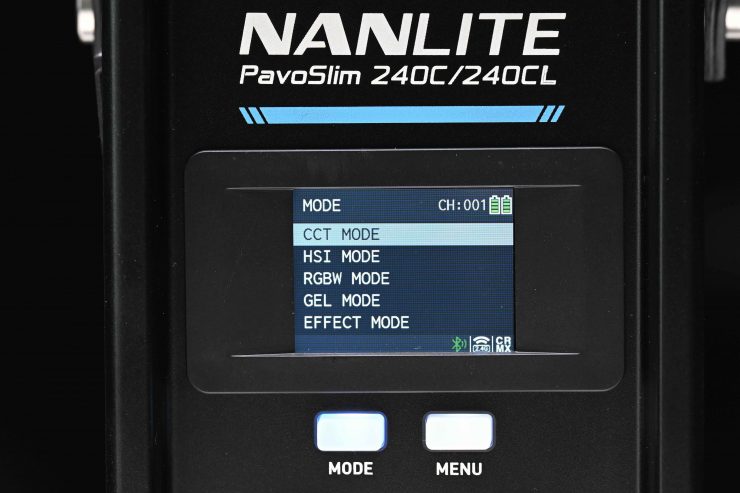
The MODE button toggles between the following operating modes:
- CCT
- HSI
- RGBW
- GEL
- EFFECT
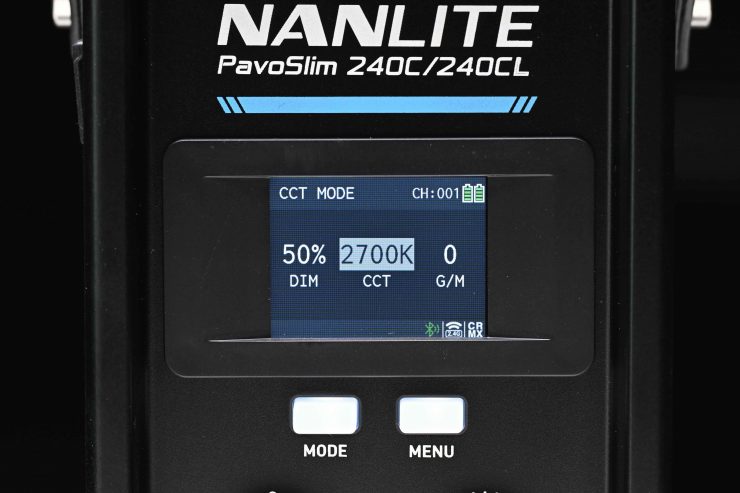
In the CCT mode, you can make adjustments to the CCT from 2700K to 7500K. You can also change the intensity and also the +/- G/M.
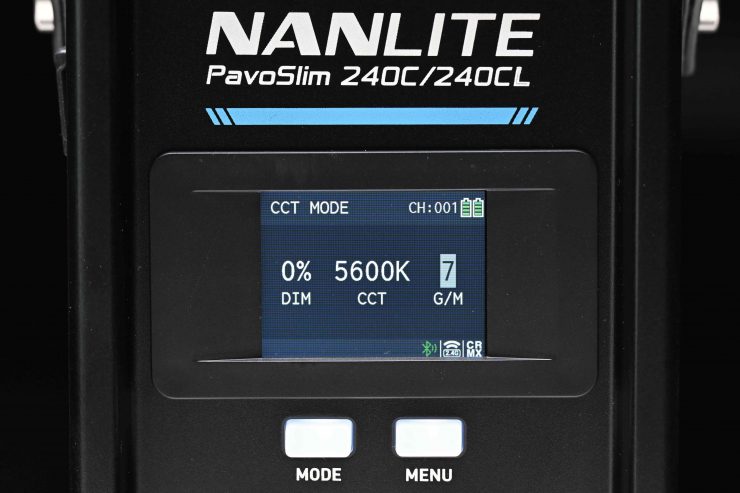
It is nice that the lights feature the ability to adjust the +/- G/M bias. This can really help you match other lighting sources.
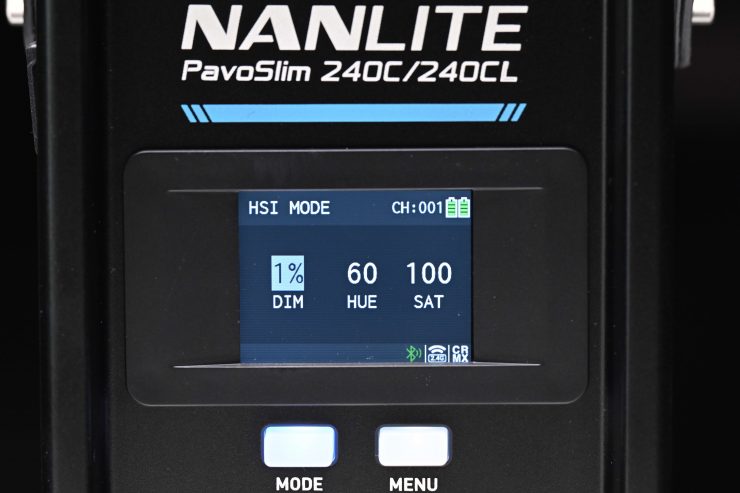
In the HSI mode, you can individually adjust the Hue, Saturation, and Intensity.
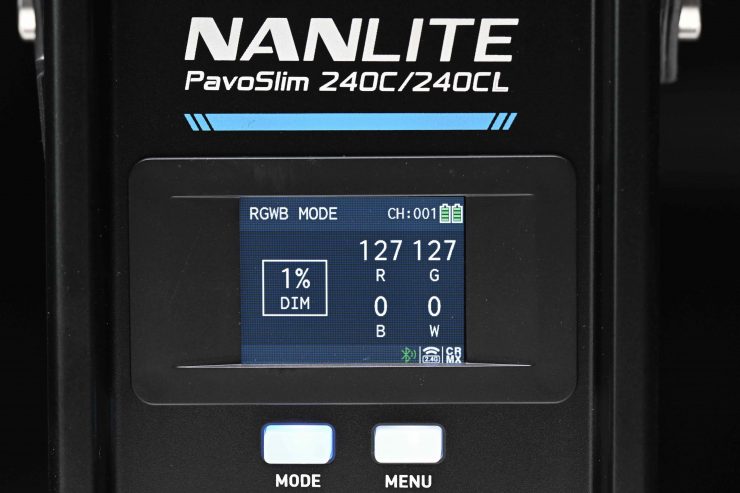
In the RGBW Mode, you can individually adjust Red, Green, Blue, and white.
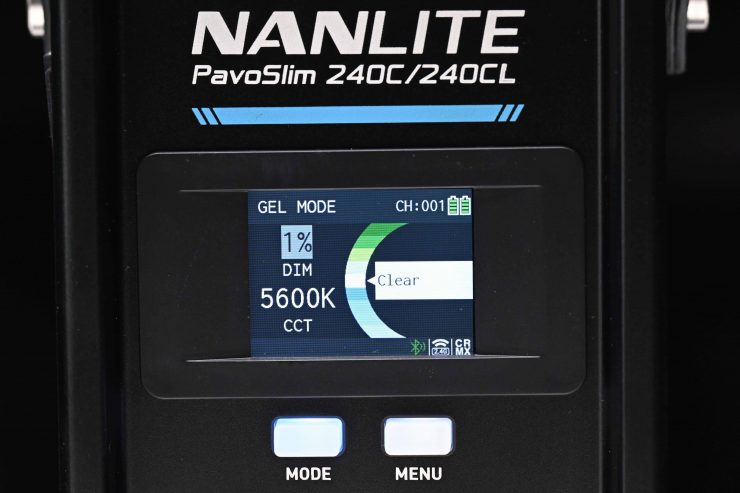
In the GEL Mode, you can choose from a vast array of digital gels. You can also choose your base CCT from either 3200K or 5600K.
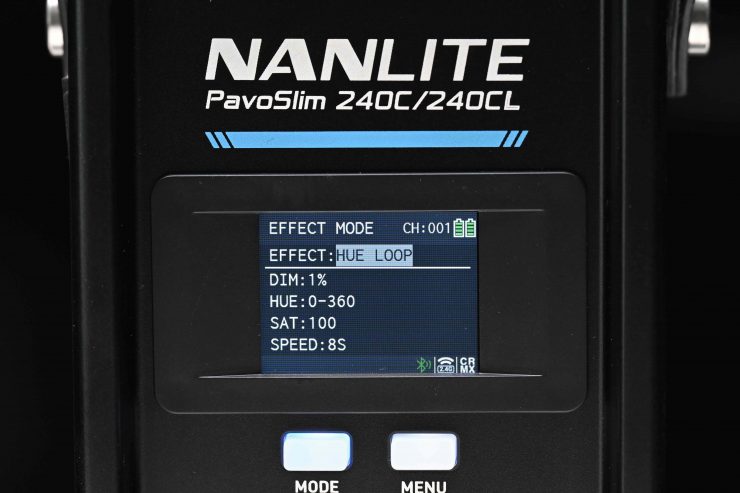
In the Effects Mode, you can choose from a decent collection of special effects.

If you press the MENU button you can choose to view or alter various settings, including the wireless, DMX, language, etc.
Overall the UI is very intuitive and easy to use. This is also partly due to the fact there are not a ton of menus or options to choose from. You don’t need a manual to be able to work out how to use this light. This is always a good thing, especially if you are handing the light off to someone who hasn’t used it before.
You can also control the lights using DMX/RDM or LumenRadio.
NANLINK Bluetooth app

As well as making adjustments directly from the power supply/controller you can also use the free NANLINK Bluetooth app to control the light remotely.
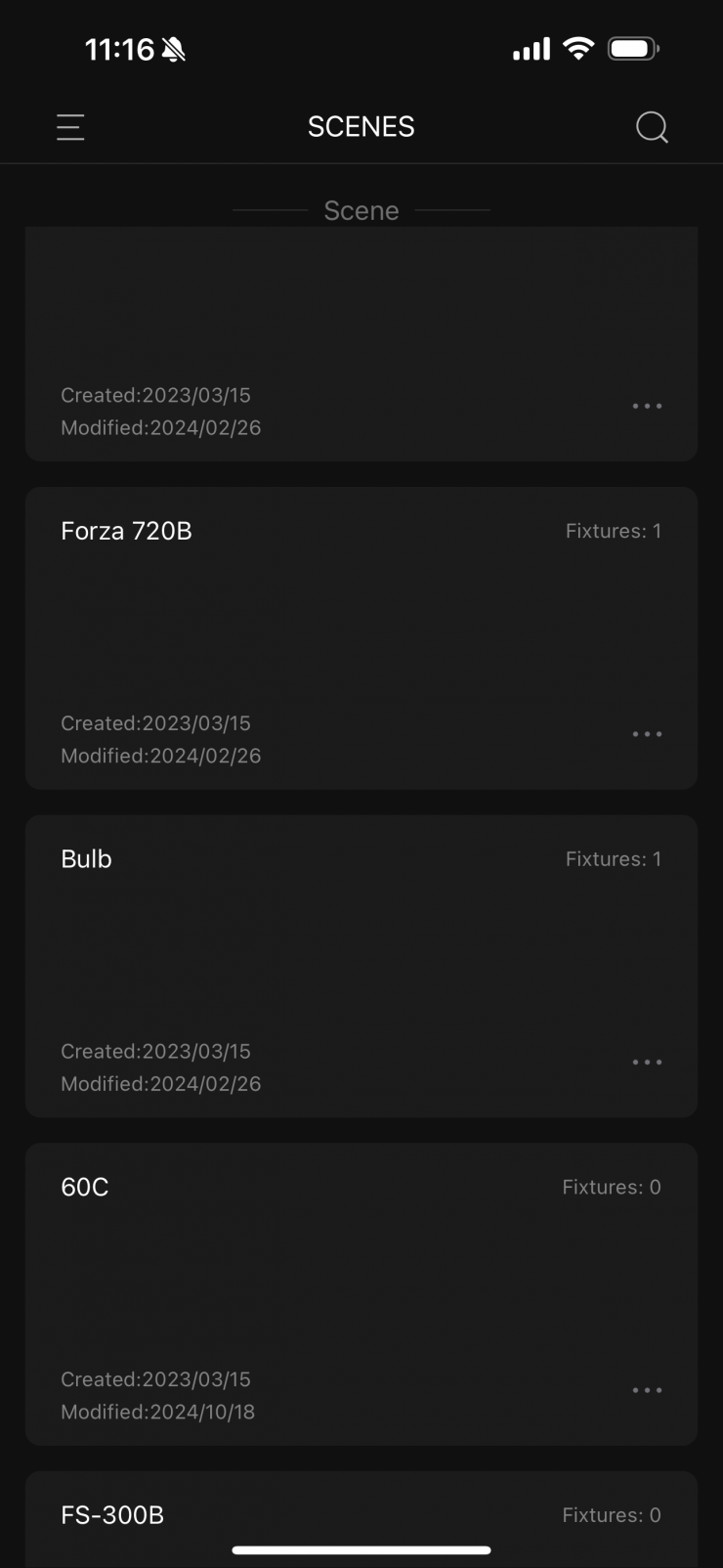
With the app, the first thing I am going to do is create a new Scene and name it PavoSlim 240CL. It will then ask me to add a fixture.
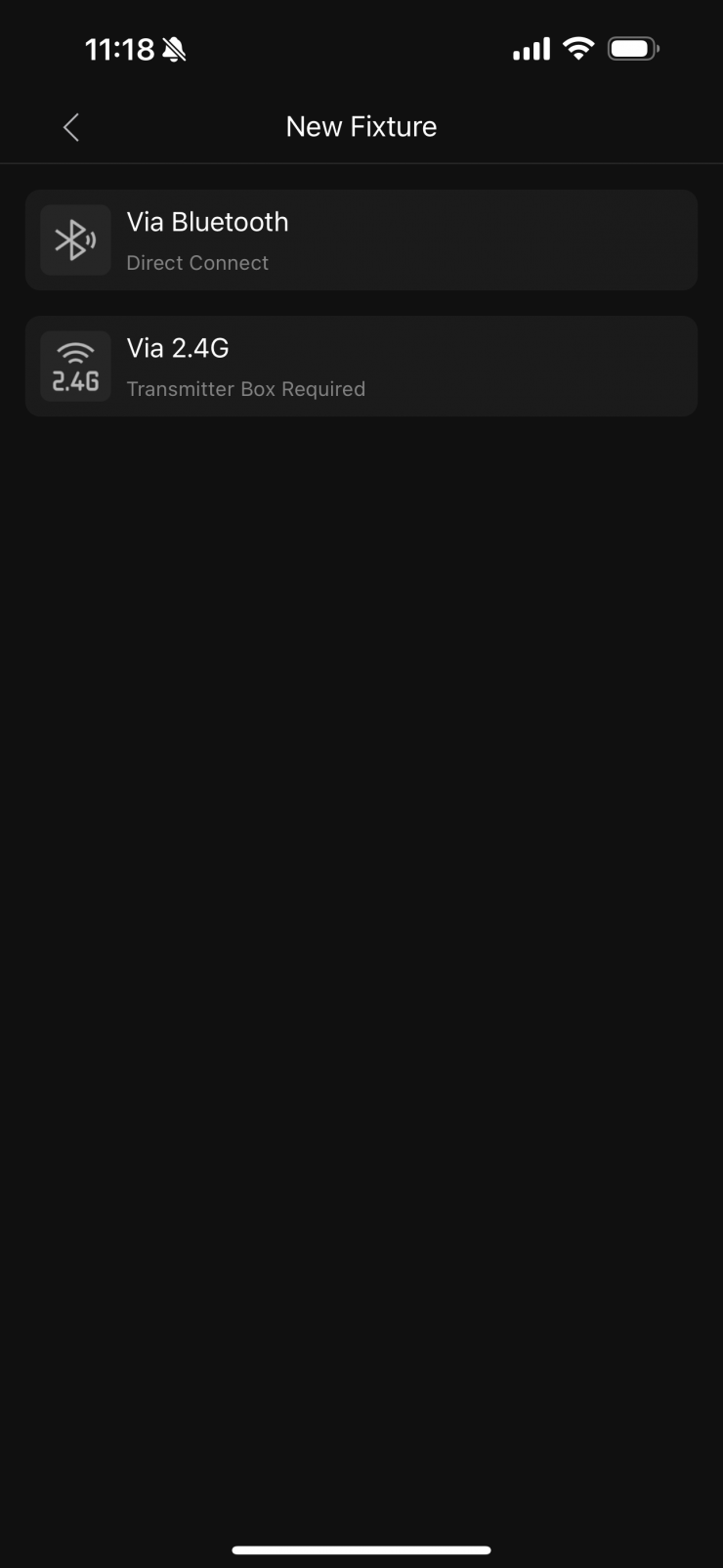
Once I click to add a new fixture it will ask me how I would like to connect. In this case, I will choose Bluetooth.

The app will then show me any Nanlite fixtures that are tuned on. I am now going to just select the PavoSlim 240CL.
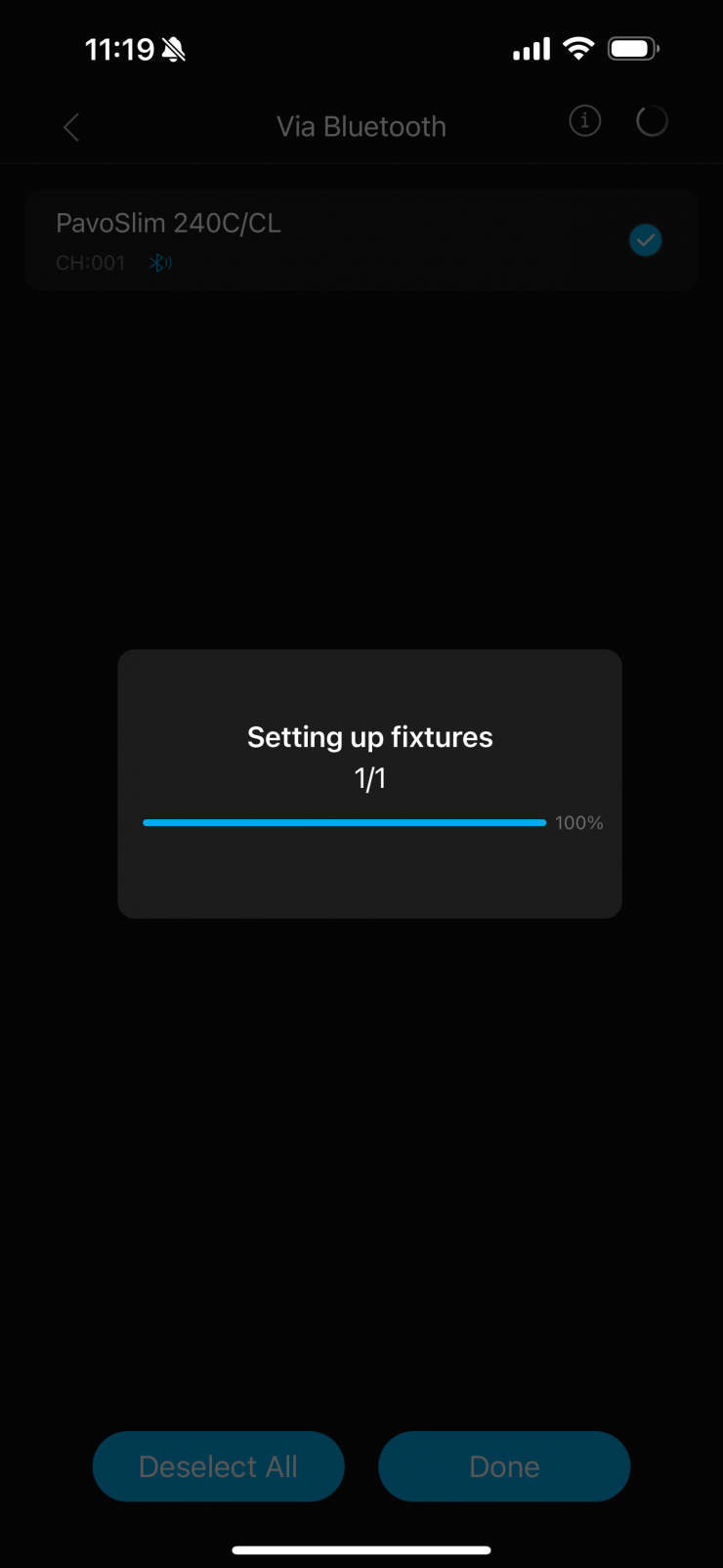
It will then start setting the fixture up to use with the app.
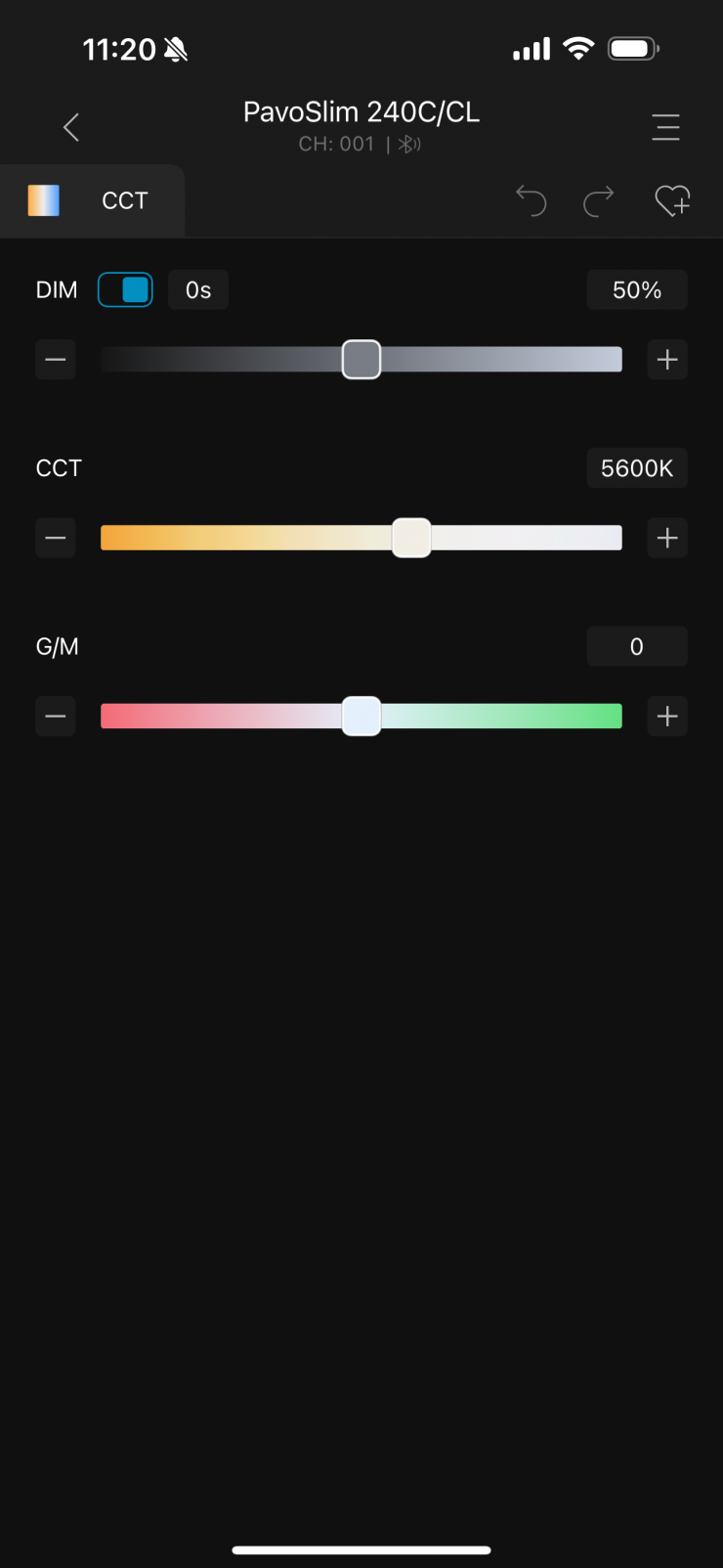
I then end up at the main UI screen. Here I can adjust the CCT, brightness, and +/- G/M bias.
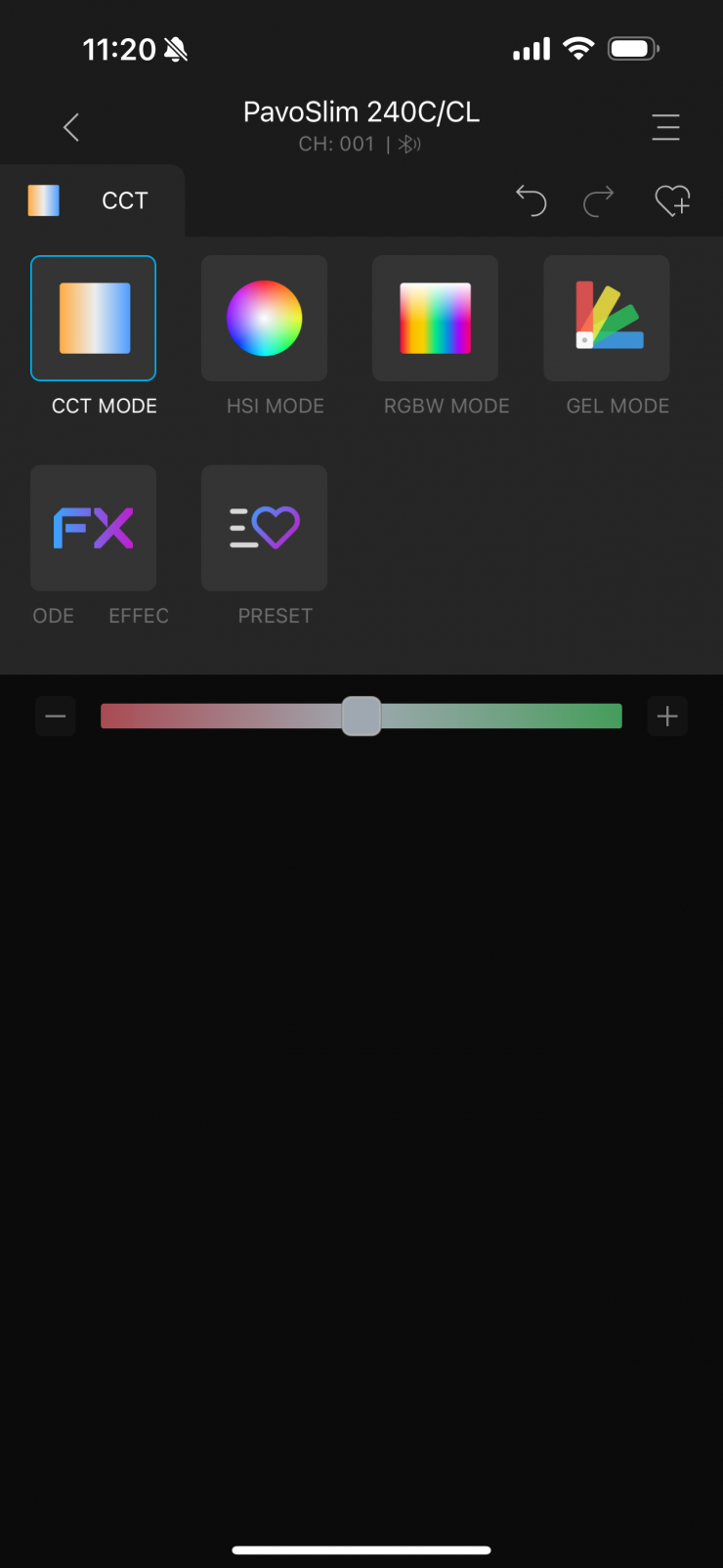
If I want to enter the various operating modes I can do so from here.
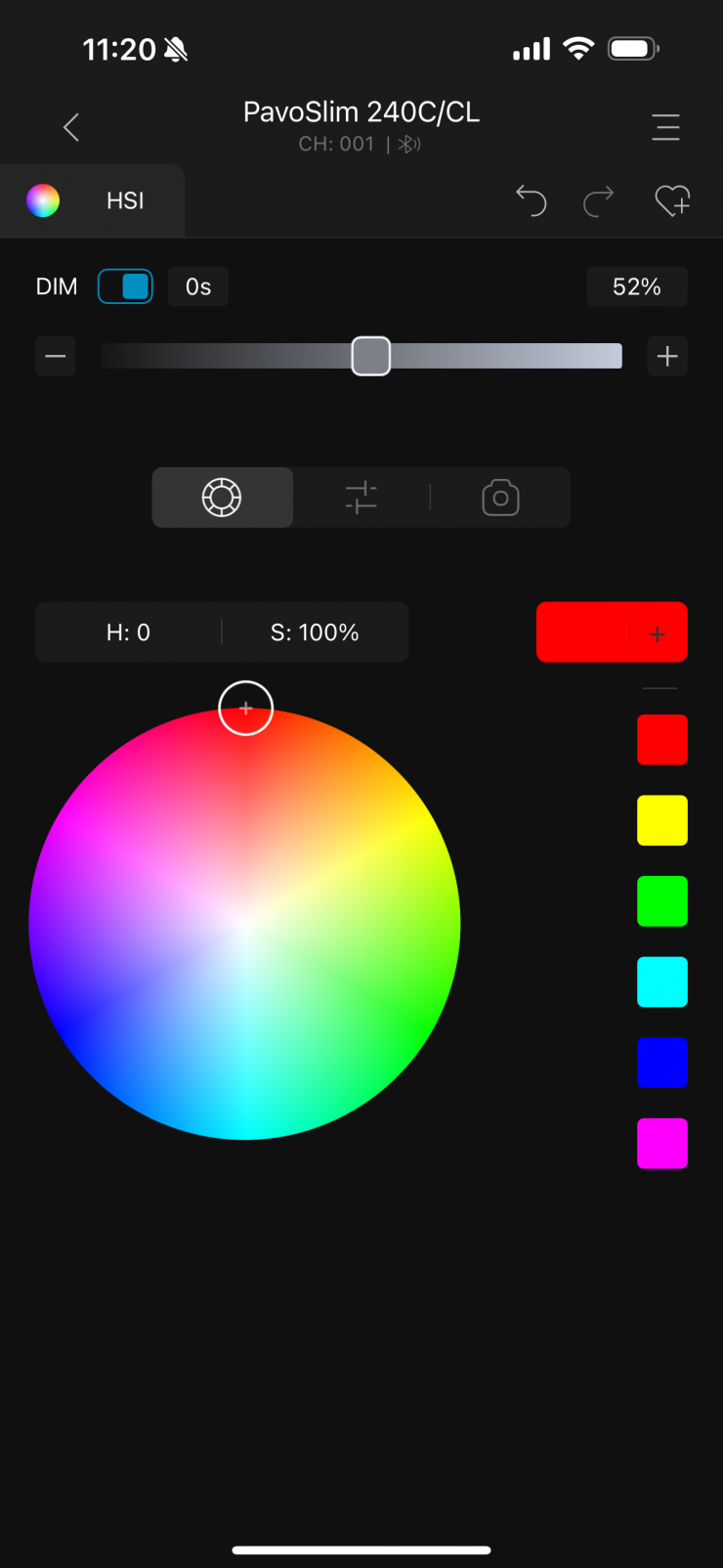
Above you can see what the screens for each mode look like.
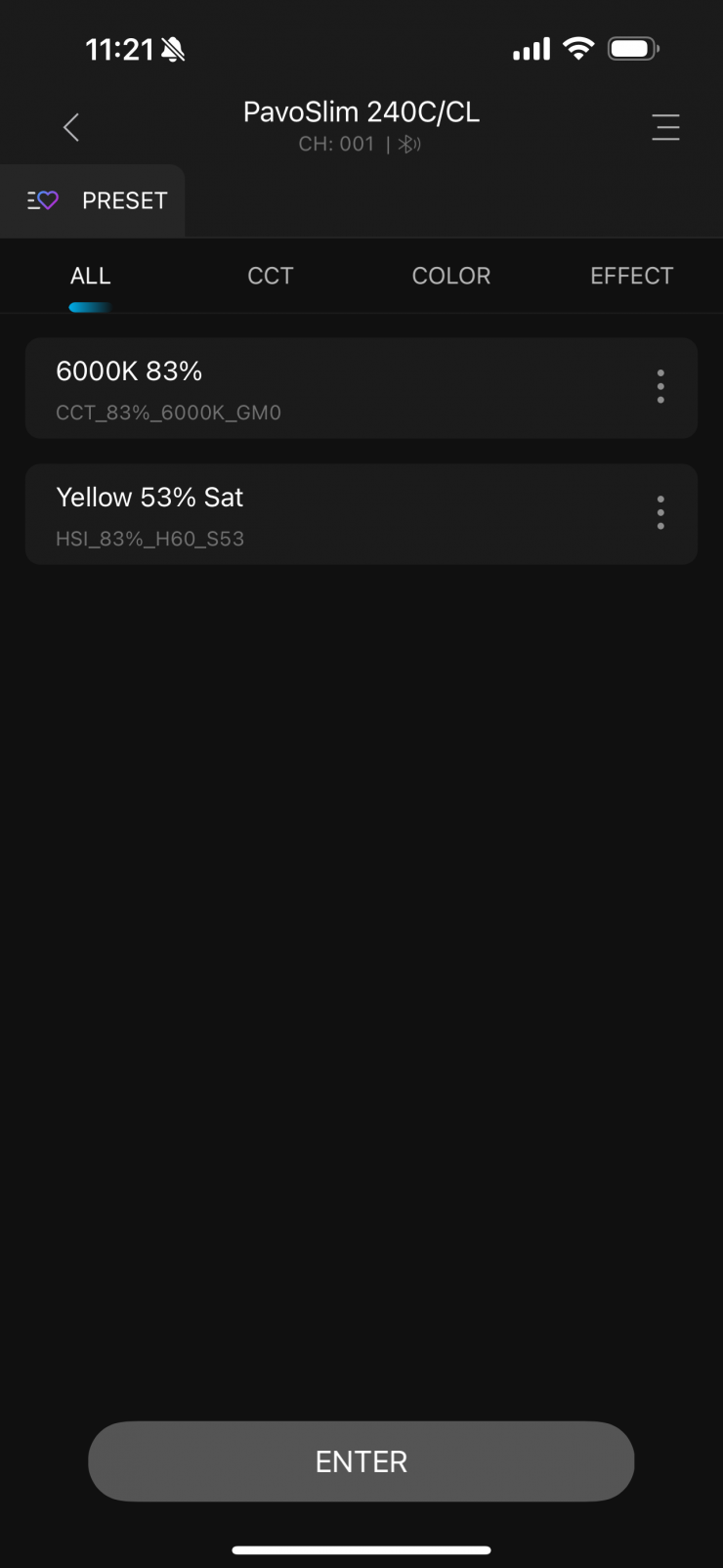
I can also save presets that I can store and recall at a later date.
Overall, the app works well. It is easy to make changes and it connects up without any issues.
Beam Angle
The beam angle of the PavoSlim 240CL is 60 degrees. This is relatively narrow, however, because of its physical length, 60 degrees isn’t actually that narrow for a light like this.
Set-Up Time & Usability
The biggest downside of using a lot of flexible or foldable LED lights is that they are a pain to set up. You normally have to construct up frames and mounts and then hook them up to controller units and power supplies.

The PavoSlim series is a little different because it features hard backing plates. This allows you to set them up very quickly, which is always handy. It is also nice that there are several different positions you can mount the plate, depending on your requirements.
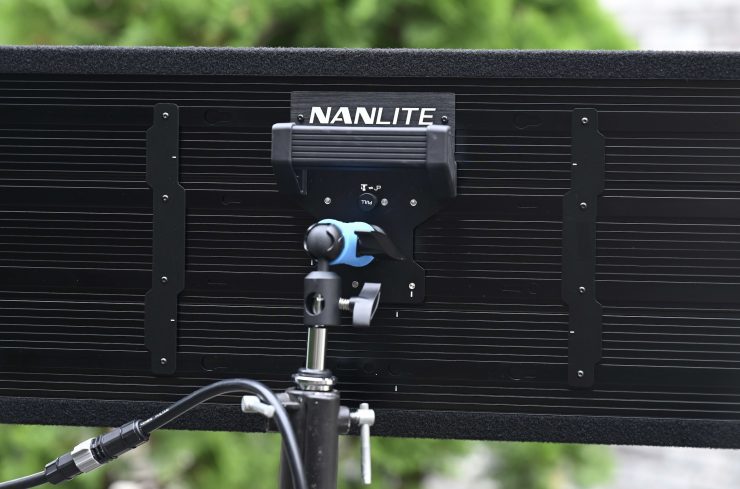
As I mentioned earlier, the light comes with nice and robust locking backing plates which makes it very easy to mount.

I also really like the clever softbox design. It is held on via velcro and because it utilizes small bendable rods you can collapse the softbox down when it isn’t in use so that you don’t have to take it off and put it back on again.
Above you can see how it works with the smaller 60C.
If you are working by yourself or in a small crew you need to be able to set up lighting quickly. The PavoSlim series can literally be set up in a couple of minutes by a single person.
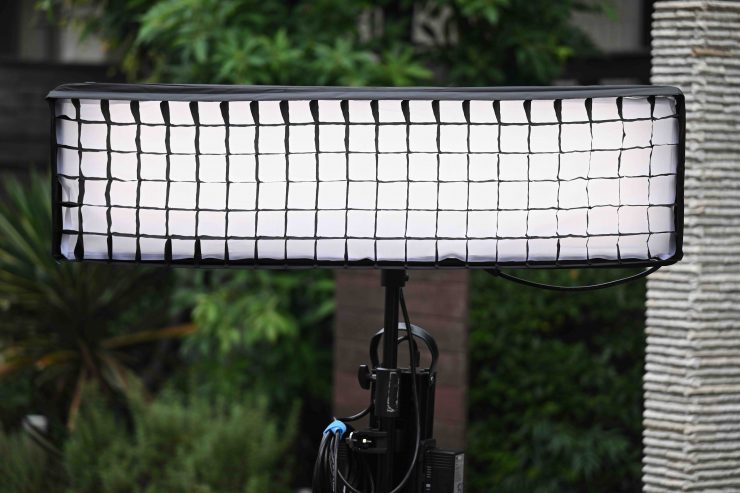
Speaking of the softbox, you also get a honeycomb grid and two different strengths of diffusion in the kit.
I actually found that you combine both pieces of diffusion and use them together if you want to create a softer source.
With the included angled mounting connector you can get the arm to point down at a reasonable degree when used on a lightstand, but you won’t be able to face it completely down given its design. You can, however, point it directly up without any issues. Of course, if you have it out on an arm, etc. then you can get it to point directly down.
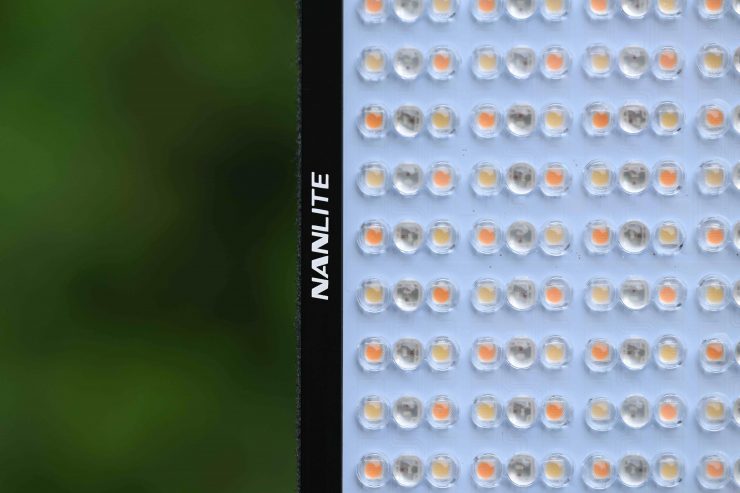
Now, the PavoSlim doesn’t feature any type of inbuilt diffusion in front of the LEDs so if you want to create a softer source you will need to use the included softbox.
One of the downsides, as I mentioned earlier with these types of LED lights, is you have to carry around a separate controller/power supply, the light, and a bunch of cables and accessories.
Output & Color Temperature Accuracy
A big factor for a lot of people when buying a light is how much output it can produce.
I tested the lights output at a variety of CCT settings both running on mains and battery power using a Sekonic C-800 at a distance of 3m / 9.9′ in a controlled environment; you can see the results below. With any diffusion or attachment, I measure from the end of it and not from the light source. I do this with all my measurements for lights.

Above you can see what Nanlite quotes as the output for the 240CL when used at various CCT settings at a variety of distances.
Nanlite PavoSlim 240CL 5600K Open Face
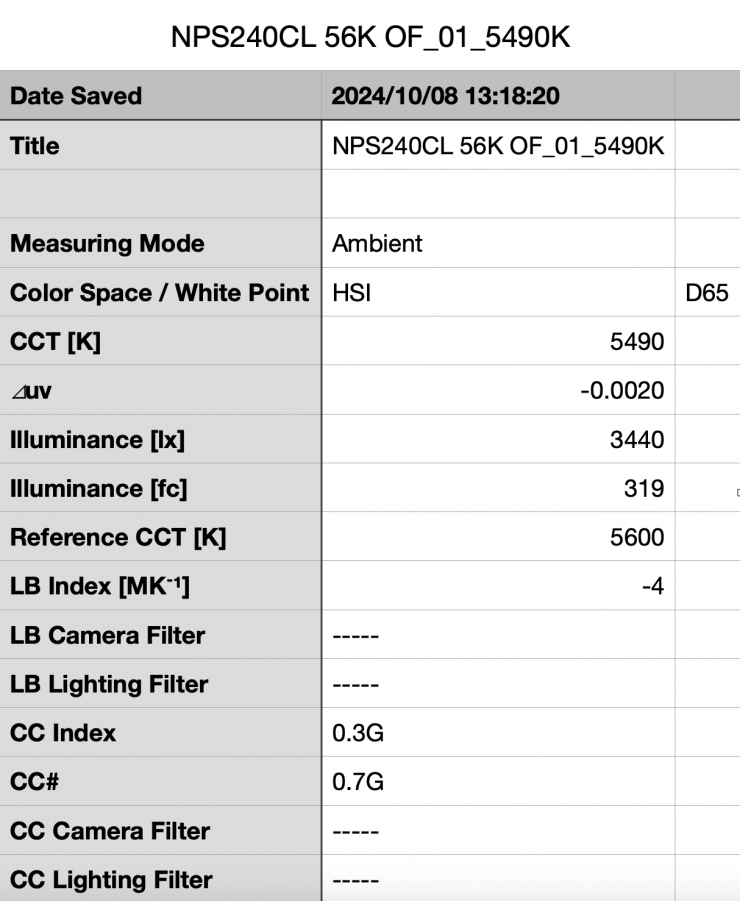
Above you can see the Nanlite PavoSlim 240CL recorded an output of 3440 lx (319 fc) when set at 5600K and run off mains power at a distance of 3m / 9.9′. This is almost identical to Nanlite’s claimed figure @3m of 3404 lx.
3440 lx from an LED light with this form factor and size that has a power draw of 240W is very impressive.
| OUTPUT @1m / 3.3′ 5600K | |
| Nanlite PavoSlim 240CL | 20,100 lx* |
| Nanlite PavoSlim 120C | 12,800 lx |
| Godox KNOWLED F200Bi | 9610 lx |
| Intellytech MEGA-6 LiteCloth 3.0 Bi-Color Foldable LED Mat | 10,300 lx |
*Measurement taken at 1m / 3.3′
As a comparison, above you can see how that output compares to the Godox KNOWLED F200Bi, and the Intellytech MEGA-6 LiteCloth 3.0 Bi-Color Foldable LED Mat. These are the only similar lights that I have reviewed. Yes, these are different from the PavoSlim 240CL, but at least it gives you a good indication of the output.
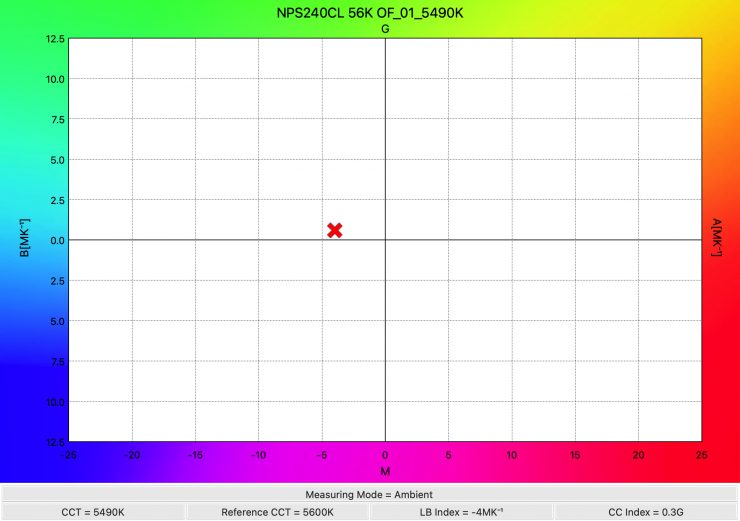
The PavoSlim 240CL produced a CCT reading of 5490K, which was 110K off being correct.
As a competition comparison, the Intellytech MEGA-6 LiteCloth 3.0 Bi-Color Foldable LED Mat produced a CCT reading of 5642K, and the Godox KNOWLED F200Bi recorded 5513K.
Nanlite PavoSlim 240CL 3200K Open Face
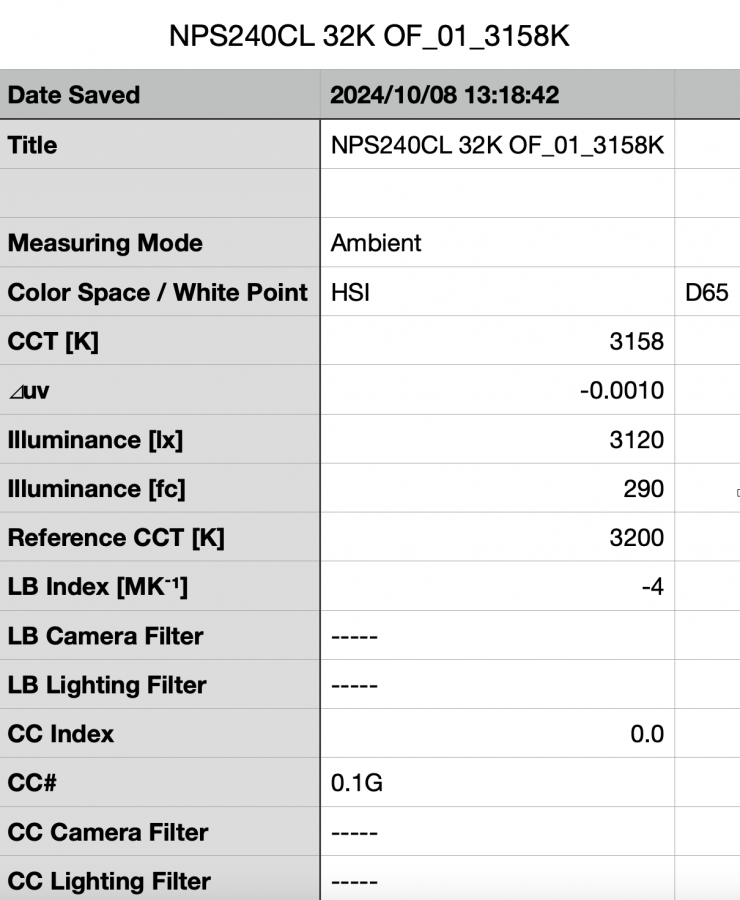
Above you can see the light’s output when it was set at 3200K and measured at a distance of 3m / 9.9′. It produced 3120 lx (290 fc), which is 9.93% less than the 3440 lx it produced at 5600K.
| OUTPUT @1m / 3.3′ 3200K | |
| Nanlite PavoSlim 240CL | 21,200 lx* |
| Nanlite PavoSlim 120C | 10,900 lx |
| Godox KNOWLED F200Bi | 8020 lx |
| Intellytech MEGA-6 LiteCloth 3.0 Bi-Color Foldable LED Mat | 9850 lx |
*Measurement taken at 1m / 3.3′
As a comparison, above you can see how that output compares to the Godox KNOWLED F200Bi, and the Intellytech MEGA-6 LiteCloth 3.0 Bi-Color Foldable LED Mat.
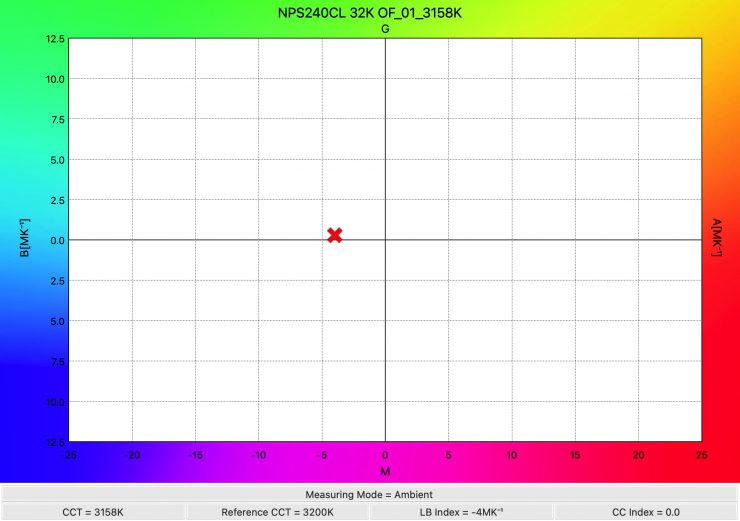
As far as CCT accuracy goes, it recorded a very good reading of 3153K. The light is more CCT-accurate at 3200K than it is at 5600K.
Again, as a comparison, the Intellytech MEGA-6 LiteCloth 3.0 Bi-Color Foldable LED Mat produced a CCT reading of 3256K, and the Godox KNOWLED F200Bi recorded 3204K.
How does it perform at various CCT settings?
Nanlite PavoSlim 240CL Open Face @3m / 9.9′
| OUTPUT | CCT | |
| 2700K | 2960 lx | 2702K |
| 3200K | 3120 lx | 3158K |
| 4500K | 3380 lx | 4360K |
| 5600K | 3440 lx | 5490K |
| 6500K | 3310 lx | 6434K |
| 7500K | 3260 lx | 7478K |
The light’s output was reasonably consistent across its CCT range. The output across its entire CCT range varied by 13.95%. While there is nothing wrong with having a higher output at certain CCT settings, on really good lights the output is almost identical no matter what CCT setting you select.
The results also show me that the light is very CCT accurate at 2700K, 3200K, and 7500K. At 4500K and 5600K, it wasn’t as good.
So, now, let’s have a look at how much output you get when using the included softbox.
Nanlite PavoSlim 240CL 5600K Softbox
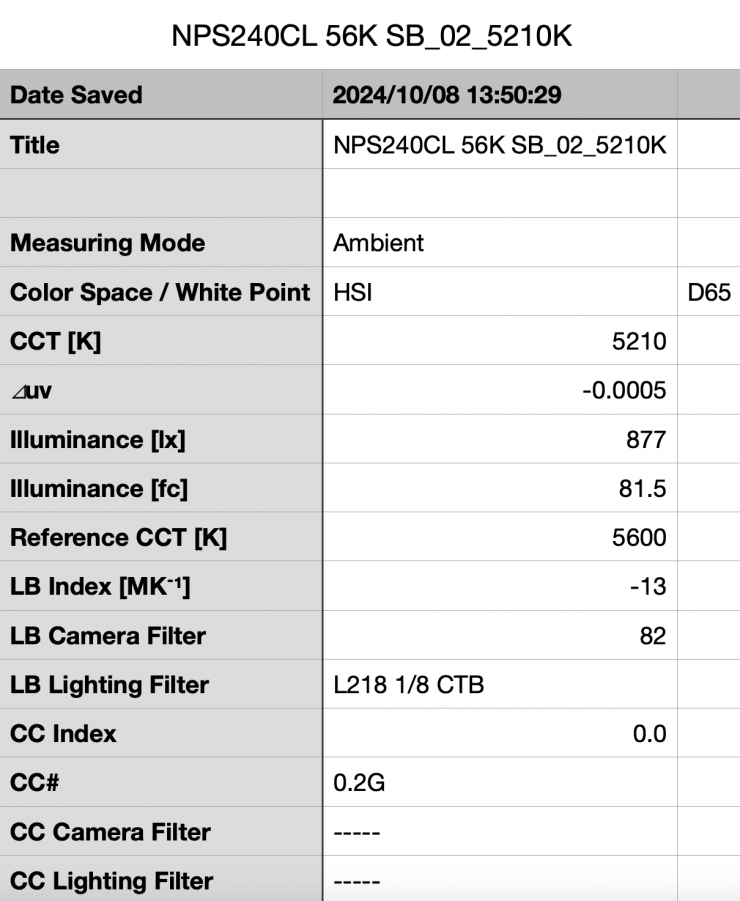
Above you can see that when the light was using its included softbox it recorded an output of 877 lx (81.5 fc) @3m / 9.9′. This was 75.5% less output than when using the light open face.
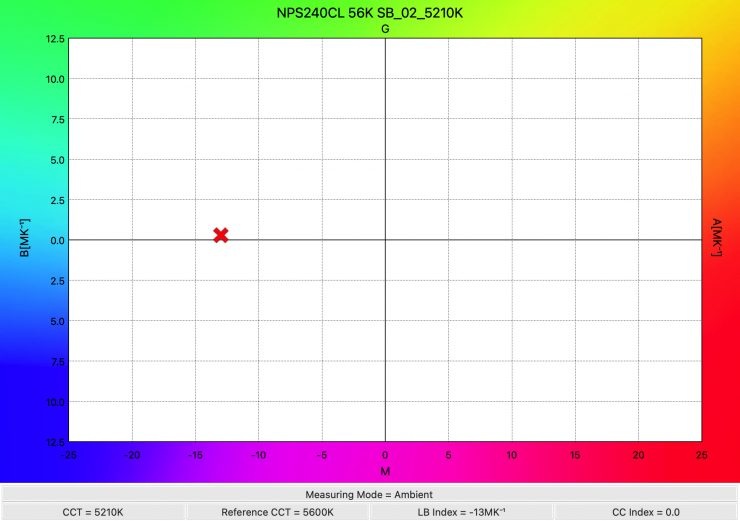
Now, the softbox did alter the CCT quite dramatically. With the softbox, the CCT reading was 5210K which was 280K lower than the 5490K it recorded with no diffusion.
Nanlite PavoSlim 240CL 3200K Softbox
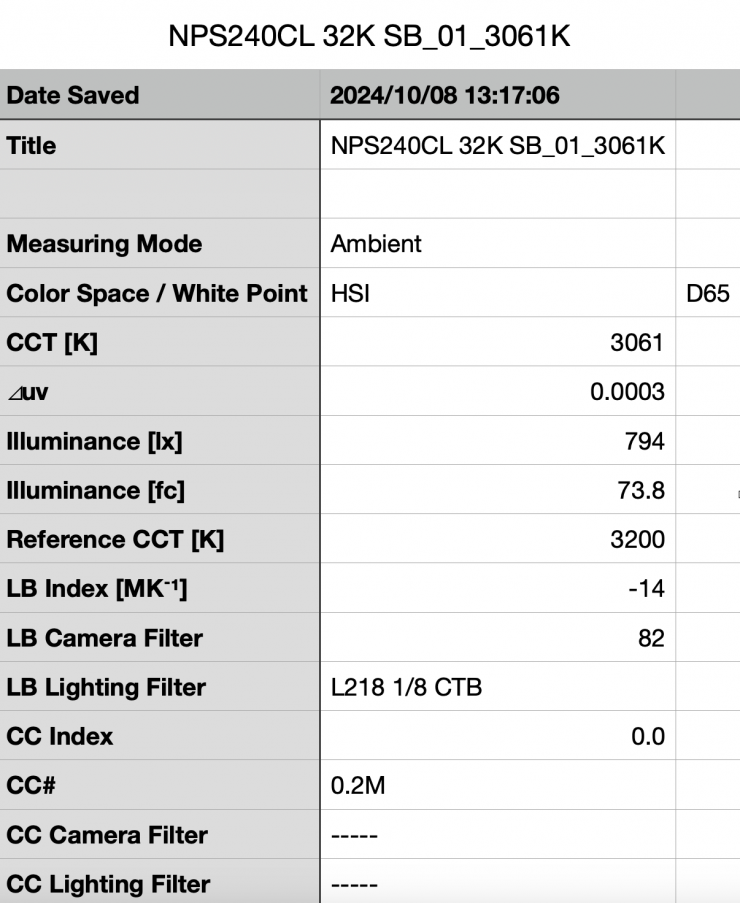
Above you can see the light’s output when it was set at 3200K and used at a distance of 3m / 9.9′ and using the softbox was 794 lx (73.8 fc), which was 74.55% less than the 3120 lx it produced when used open face.
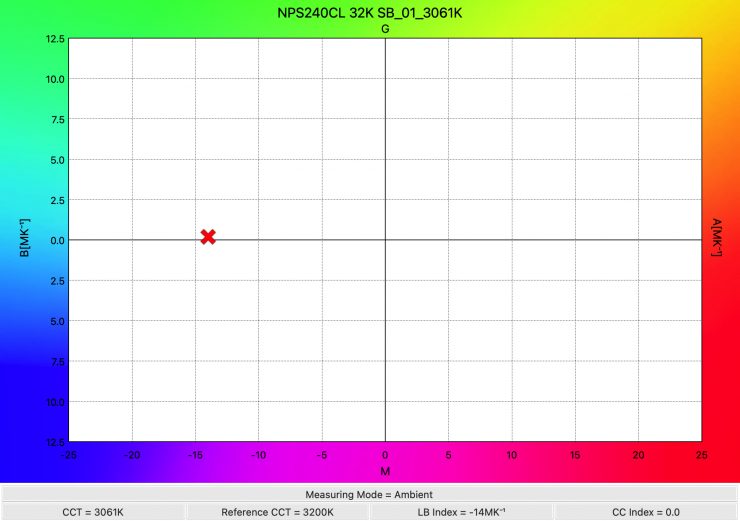
As far as CCT accuracy goes, it recorded a reading of 3061K, which was around 100K lower than the 3158K reading when used open face. If you are going to use this light with the softbox at 3200K you would need to set the CCT around 3350K to get a more accurate reading.
Battery Output
One of the nice aspects of the PavoSlim 240CL is that it can be run by two flight-safe batteries at 100% output.
Nanlite PavoSlim 120C 5600K Two V-lock Batteries
Ok, so now let’s see what happens to the output if I try running the Nanlite PavoSlim 240CL via two V-mount batteries.

Above you can see that when the light was running off two 14.4V 150Wh V-mount batteries it recorded an output of 3,470 lx (322 fc) @3m / 9.9′. This was basically the same amount of output as when it is run via mains power.
Nanlite PavoSlim 240CL 5600K Single V-lock Battery
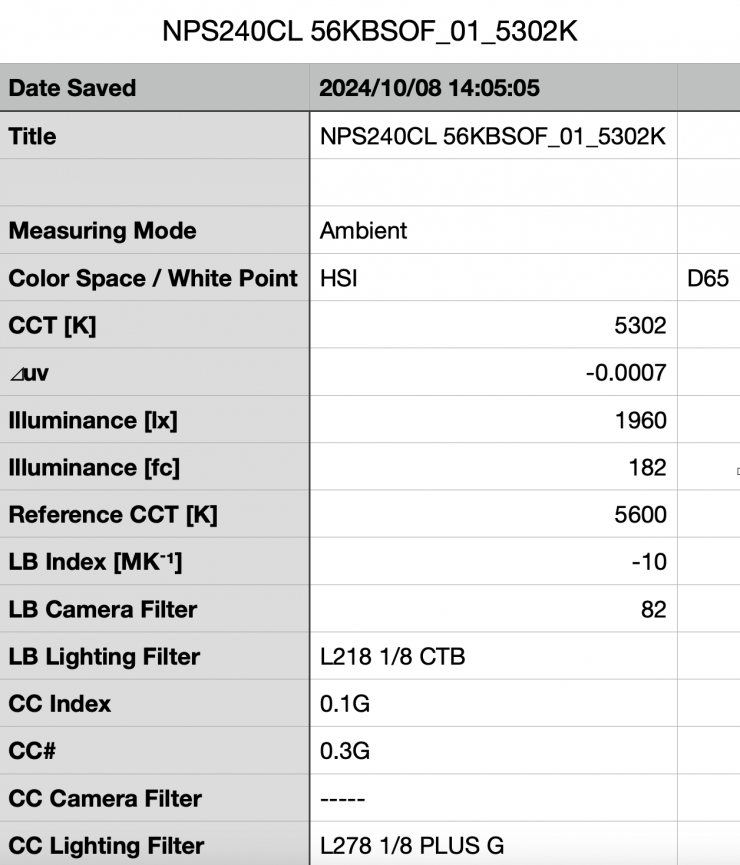
Above you can see that when the light was running off a single V-mount battery it recorded an output of 1960 lx (182 fc). This was 43.5% less than what it recorded when running off two 14.4V batteries.
CCT consistency & linear output when dimming the light
Now, what you should always do when testing lights is to see if the CCT remains consistent when dimming the light. Just because you set a light at say 5600K, that doesn’t mean that the CCT will remain stable as you start dimming the fixture down. I also wanted to see how linear the dimming curve was.
I decided to do a series of tests at 100%/75%/50%/25%10% to see if the CCT being recorded changed. This was done at a distance of 3m / 9.9′ using a Sekonic C-800. These tests were done at 5600K with the light being used open face.
Nanlite PavoSlim 240CL
| CCT READING | OUTPUT | INTENSITY % |
| 5490K | 3440 lx | 100 |
| 5414K | 2570 lx | 75 |
| 5372K | 1790 lx | 50 |
| 5341K | 960 lx | 25 |
| 5317K | 437 lx | 10 |
The Nanlite PavoSlim 240CL maintained reasonably decent CCT consistency as you start dimming the fixture. My testing showed that the CCT readings varied by 173K from 100% to 10%.
As far as how linear the output is when you start dimming the light, at 50% output it had 48.41% less output than when used at 100%. At 25% it had 72.33% less output than when used at 100%. At 10% output, it had 87.40% less output than when used at 100%. This shows me that the light’s dimming curve is reasonably linear.
Color Rendering
So now that we have seen how much output the Nanlite PavoSlim 240CL produces, how does it perform when it comes to replicating accurate colors?
Nanlite PavoSlim 240CL 5600K (Open Face)
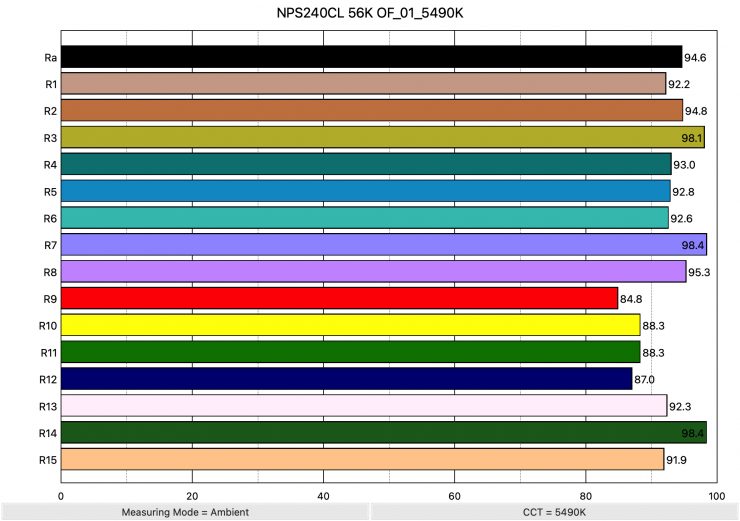
Above you can see that when the light was set at 5600K and used open face it recorded an average CRI (R1-R8) of 94.6 and an extended CRI (R1-R15) of 92.54. For replicating accurate skin tones it recorded 84.8 for R9 (red), 92.3 for R13 (closest to caucasian skin tones), and 91.9 for R15 (closest to Asian skin tones). These were ok results, but not as good as I was expecting. R9 (Red), R11 (Green), and R12 (Blue) were all below 90.

The light when set at 5600K also recorded a TLCI score of 99.
As a comparison, I compared the color rendering of the PavoSlim 240CL against the Godox KNOWLED F200Bi, Aladdin Bi-Flex2 Bi-Color LED Panel 1×2 and the Intellytech MEGA-6 LITECLOTH 3.0. The Aladdin and Godox both have excellent color rendering scores and I personally consider them to be a benchmark for these types of thin LED panels.
| EXTENDED CRI | R9 | R13 | R15 | |
| Nanlite PavoSlim 240CL | 92.54 | 84.8 | 92.3 | 91.9 |
| Godox KNOWLED F200Bi | 95.46 | 97.5 | 98.4 | 97.5 |
| Intellytech MEGA-6 LITECLOTH 3.0 | 95.78 | 93.4 | 96.7 | 95.8 |
| Aladdin Bi-Flex2 Bi-Color LED Panel 1×2 | 97.54 | 96.7 | 98.6 | 98.8 |
Above you can see a head-to-head comparison against the Godox KNOWLED F200Bi, Aladdin Bi-Flex2 Bi-Color LED Panel 1×2, and the Intellytech MEGA-6 LITECLOTH 3.0 when used at 5600K. The Nanlite PavoSlim’s scores were all below the Godox, Aladdin, and Intellytech, which are what I personally consider to be the industry benchmarks for flexible panel lights when it comes to color accuracy. I saying that any light with scores in the 90s is going to be pretty good.
Nanlite PavoSlim 240CL 3200K

Above you can see the scores for when the light was used at 3200K open face. It recorded an average CRI (R1-R8) of 96.4 and an extended CRI (R1-R15) of 95.50. For replicating accurate skin tones it recorded 98.3 for R9 (red), 95.2 for R13 (closest to caucasian skin tones), and 96.9 for R15 (closest to Asian skin tones). These were a lot better results than when the light was used at 5600K. Only R12 (Blue) was below 90.
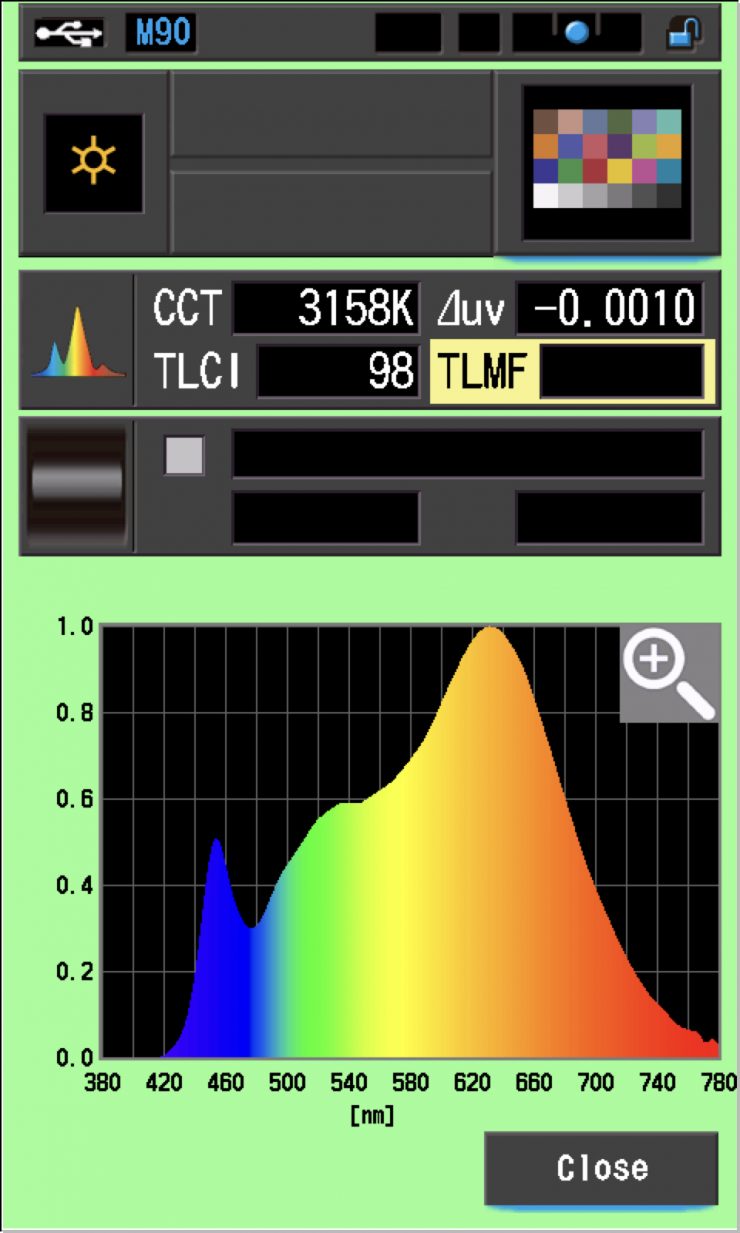
The light, when set at 3200K, recorded a TLCI score of 98.
| EXTENDED CRI | R9 | R13 | R15 | |
| Nanlite PavoSlim 240CL | 95.50 | 98.3 | 95.2 | 96.9 |
| Godox KNOWLED F200Bi | 96.84 | 92.5 | 99.5 | 98.9 |
| Intellytech MEGA-6 LITECLOTH 3.0 | 97.07 | 95.1 | 99.5 | 99.0 |
| Aladdin Bi-Flex2 Bi-Color LED Panel 1×2 | 97.54 | 96.7 | 98.6 | 98.8 |
Above you can see a head-to-head comparison against the Aladdin Bi-Flex2 Bi-Color LED Panel 1×2 and the Intellytech MEGA-6 LITECLOTH 3.0 when used at 3200K. Again, just like at 5600K, the Nanlite’s scores were all below the competition, but none the less, still very good.
Nanlite PavoSlim 240CL 5600K Softbox
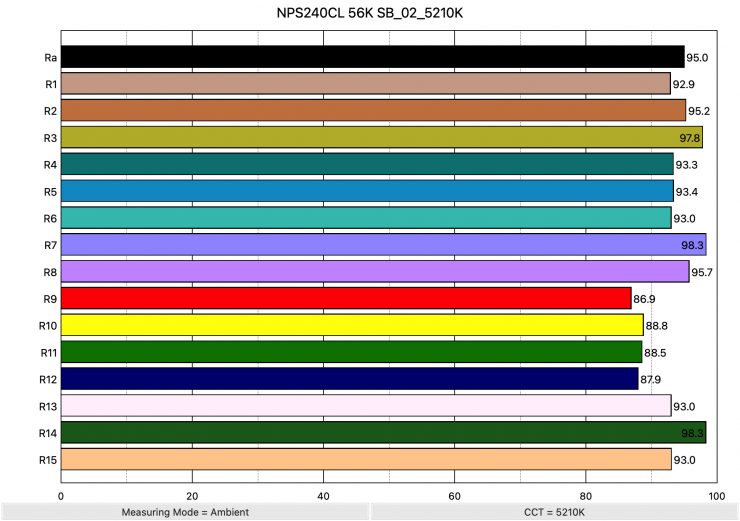
Above you can see that when the light was set at 5600K and used with its softbox it recorded an average CRI (R1-R8) of 95.0 and an extended CRI (R1-R15) of 93.06. For replicating accurate skin tones it recorded 86.9 for R9 (red), 93.0 for R13 (closest to caucasian skin tones), and 93.0 for R15 (closest to Asian skin tones). R9 (Red), R10 (Yellow), R11 (Green), and R12 (Blue) were all below 90.
| EXTENDED CRI | R9 | R13 | R15 | |
| Nanlite PavoSlim 240CL Open face | 92.54 | 84.8 | 92.3 | 91.9 |
| Nanlite PavoSlim 240CL Softbox | 93.06 | 86.9 | 93.0 | 93.0 |
Above you can see how those scores compare to when you are using the light open face.
These tests basically tell me that the color rendering performance is very similar whether you use the light with the softbox or open face.
Nanlite PavoSlim 240CL 3200K Softbox
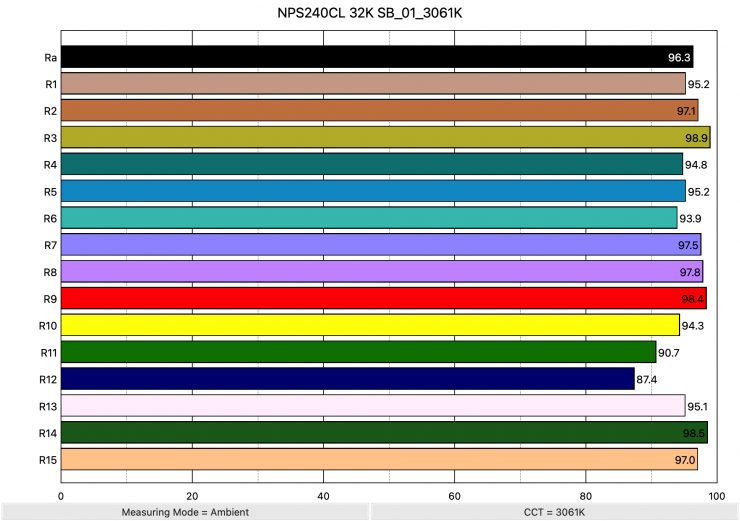
Above you can see that when the light was set at 5600K and used with its softbox it recorded an average CRI (R1-R8) of 96.3 and an extended CRI (R1-R15) of 93.06. For replicating accurate skin tones it recorded 98.4 for R9 (red), 95.1 for R13 (closest to caucasian skin tones), and 97.0 for R15 (closest to Asian skin tones). Only R12 (Blue) was marginally below 90.
| EXTENDED CRI | R9 | R13 | R15 | |
| Nanlite PavoSlim 240CL Open face | 95.50 | 98.3 | 95.2 | 96.9 |
| Nanlite PavoSlim 240CL Softbox | 95.45 | 98.4 | 95.1 | 97.0 |
Above you can see how those scores compare to when you are using the light open face.
These tests basically tell me that the color rendering performance is almost identical whether you use the light with the softbox or open face.
How does it perform when creating saturated colors?
I also wanted to test the PavoSlim 240CL to see how it performed when creating super-saturated colors.
0° – RED
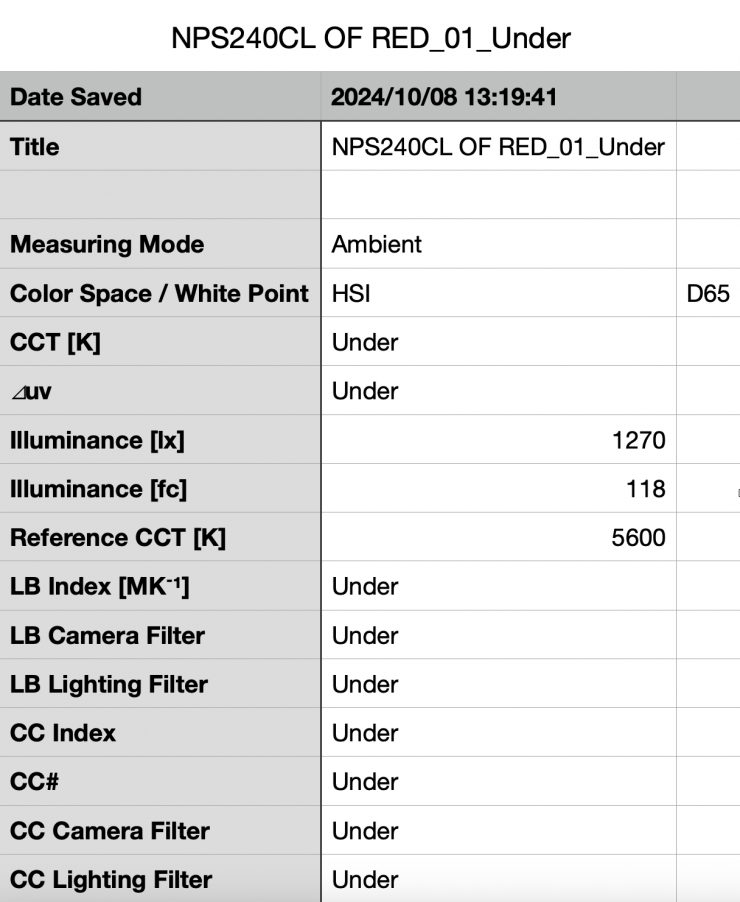
Above you can see that the light recorded an output of 1270 lx / 118 fc @3m / 9.9′.

As far as creating an accurate 0° RED, the PavoSlim 240CL was perfect.
120° – GREEN
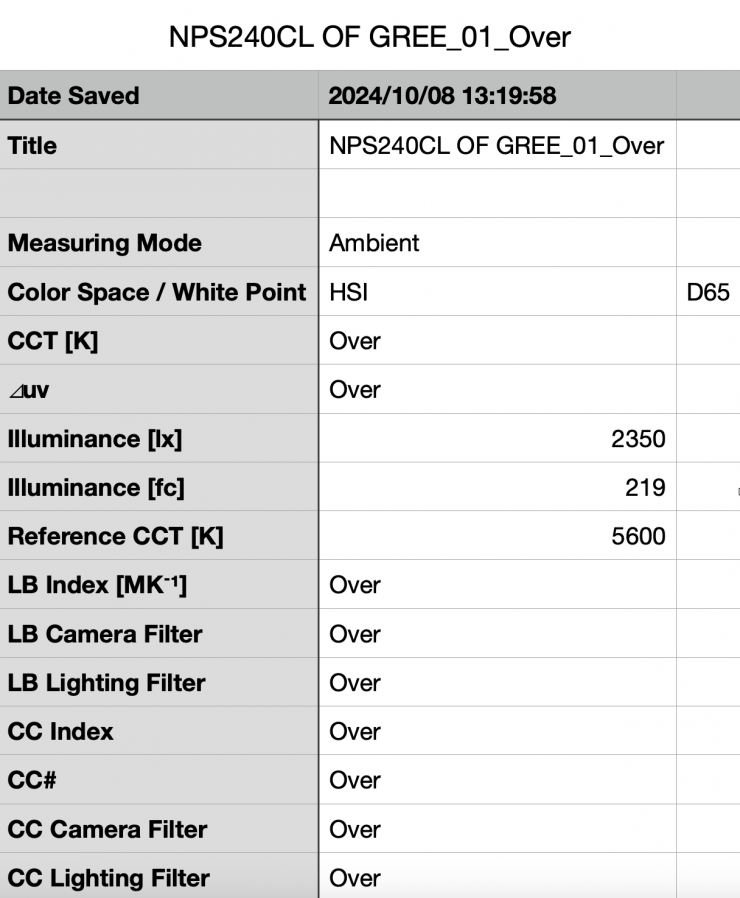
Above you can see that the light recorded an output of 2530 lx (219 fc) @3m / 9.9′.

As far as creating an accurate 120° GREEN, the PavoSlim 240CL was spot on with a 120° reading and 100% saturation.
240° – BLUE
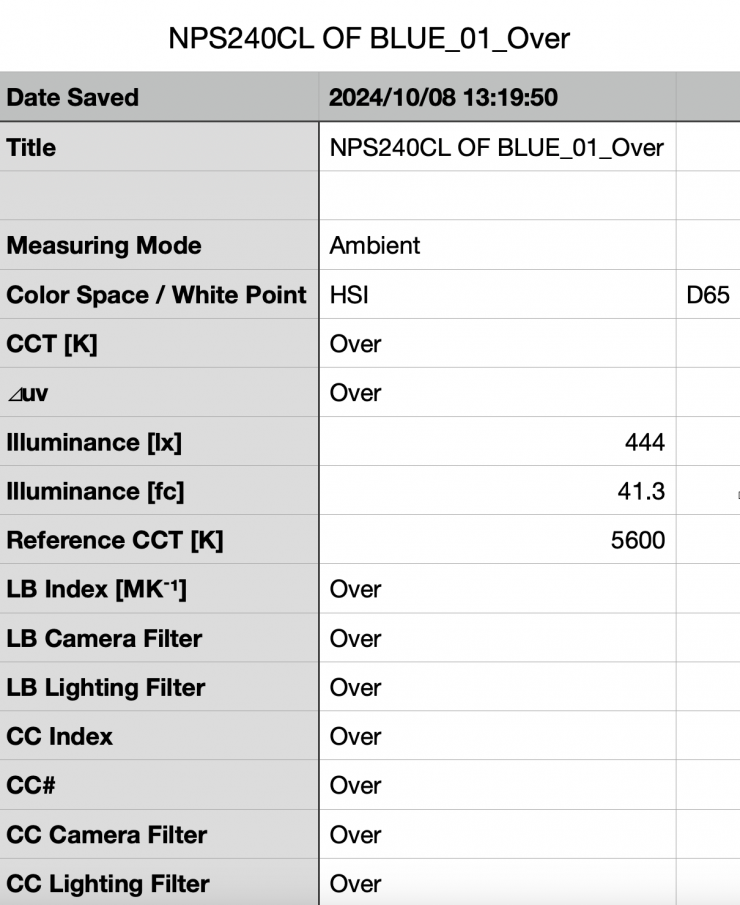
Above you can see that the light when set in its High Color mode recorded an output of 444 lx (41.3 fc) @3m / 9.9′.

As far as creating an accurate 240° BLUE, the PavoSlim 240CL had a perfect reading of 240°, with 100% saturation.
60° – YELLOW
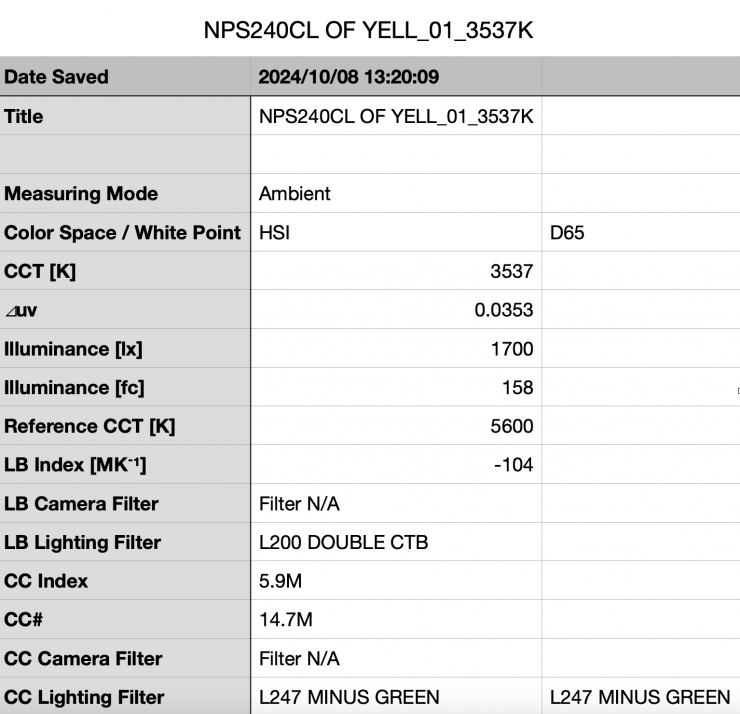
Above you can see that the light recorded an output of 1700 lx (158 fc).

As far as creating an accurate 60° Yellow, the PavoSlim 240CL was 5° off with a reading of 55°.
Because the light is RGBWW and not RGBACL it is going to struggle to recreate some fully saturated colors such as yellow accurately.
CC Index & ⊿uv
The CC Index displays the CC correction value and whether any magenta or green need to be added or subtracted. 1 CC corresponds to 035 Kodak CC values or 1/8 Rosco filter values. Any reading less than +1.00 or -1.00 and you’re probably not going to need to make any kind of adjustment. The ⊿uv is the value to show how much this light is away from being an ideal light source (black body radiation = incandescent lamp). As with the CC Index you want this number to theoretically be zero. Kelvin is not a linear value, so we need to convert from Kelvin to MK-1 to compare the values of color temperature. To calculate from Kelvin to Mired is MK-1= 1*1000000/Kelvin. While this may sound confusing, it is the only way of measuring if the Kelvin shift is significant enough to warrant having to use a filter for correction. Below are the results for the Nanlite PavoSlim 240CL:
Nanlite PavoSlim 240CL Kelvin Vs MK-1
| Kelvin | Difference in K | MK-1 | Difference in MK-1 | |
| SET VALUE | 2700K | 0 | 370.37 | 0 |
| ACTUAL READING | 2702K | 2 | 370.09 | 0.28 MK-1 |
| SET VALUE | 3200K | 0 | 312.5 | 0 |
| ACTUAL READING | 3158K | 42 | 316.65 | -4.15 MK-1 |
| SET VALUE | 4500K | 0 | 222.22 | 0 |
| ACTUAL READING | 4360K | 140 | 229.35 | -7.13 MK-1 |
| SET VALUE | 5600K | 0 | 178.57 | 0 |
| ACTUAL READING | 5490K | 110 | 182.14 | -3.57 MK-1 |
| SET VALUE | 6500K | 0 | 153.84 | 0 |
| ACTUAL READING | 6434K | 66 | 155.42 | -1.58 MK-1 |
| SET VALUE | 7500K | 0 | 133.33 | 0 |
| ACTUAL READING | 7478K | 22 | 133.72 | -0.39 MK-1 |
These figures might look confusing, but what they tell me is that the light is very CCT-accurate at 2700K, 6500K, and 7500K. Any MK-1 score that is under -9/9 means you wouldn’t have to use any color correction gels. The MK-1 scores for this light were excellent. Any MK-1 score that is under -6/6 is a very good result. At 4500K the score wasn’t great, but it was still well within the bounds of being acceptable. very good. The light had very good MK-1 consistency apart from when used at 4500K.
Ok, now let’s look at the CC INDEX & ⊿uv.
Nanlite PavoSlim 240CL CC INDEX & ⊿uv
| CC INDEX | ⊿uv | |
| 2700K | 0.1G | -0.0006 |
| 3200K | 0.0 | -0.0010 |
| 4500K | 0.0 | -0.0017 |
| 5600K | 0.3G | -0.0020 |
| 6500K | 0.4G | -0.0019 |
| 7500K | 0.2G | -0.0013 |
These were decent results across the board. There was nothing here that anyone should be concerned about. At 5600K and above it has a very slight green push, but it’s so marginal that you wouldn’t see it in the real world.
TM-30
TM-30 is a relatively new color rendering standard that was developed to deal with the limitations of CRI. TM-30 looks at 99 individual colors. These 99 colors are categorized into seven groups: nature, skin color, textiles, paints, plastics, printed material, and color systems.
TM-30 scores go from 0 – 100. The higher the score, the more accurate a light is at producing colors. Any TM-30 Rf score in the ’90s is considered to be good. What is interesting and something that you need to be very aware of is that two separate light sources with the exact same CRI scores can render colors very differently. A light with a high CRI rating could have a low TM-30 score. Conversely, a light with a good TM-30 score could have a bad CRI score.
Now, there are two measurements associated with TM-30, Rf and Rg.
Rf (Color Fidelity)
Rg (Color Gamut)
With Rf value, ideally, you want a score in the 90’s.
With Rg value, a score below 100 indicates that the light source renders colors with less saturation than the reference source. Any score above 100 means it is over-saturating colors. So ideally you want this score to be 100.
Nanlite PavoSlim 240CL
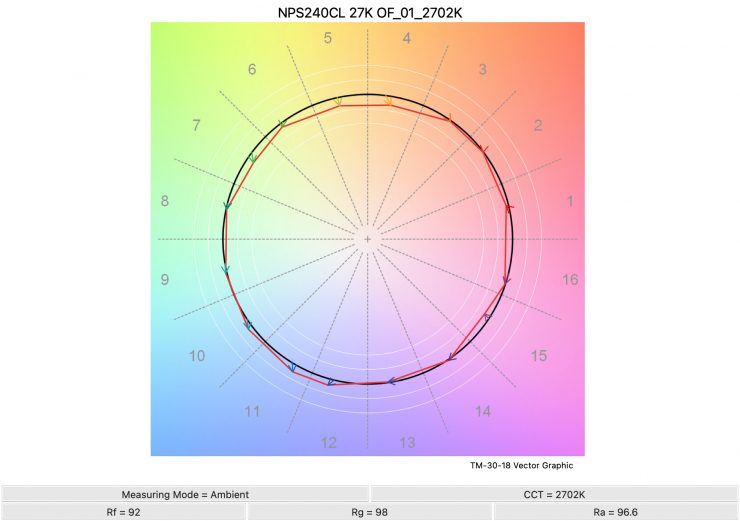

2700K 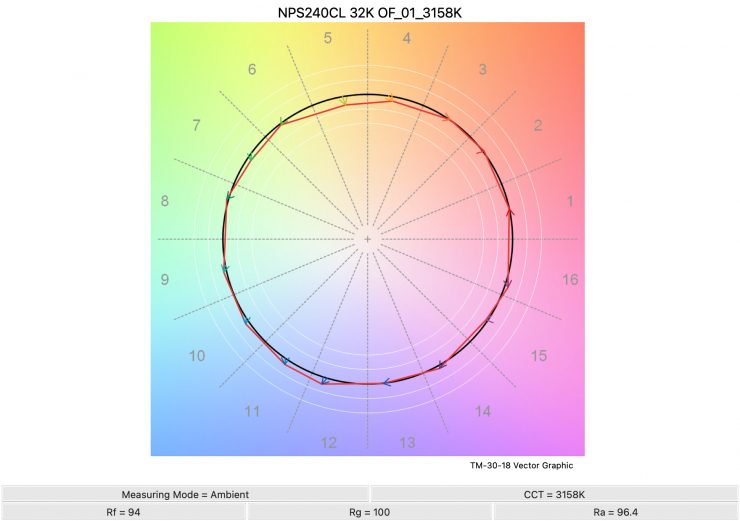
3200K 
4500K 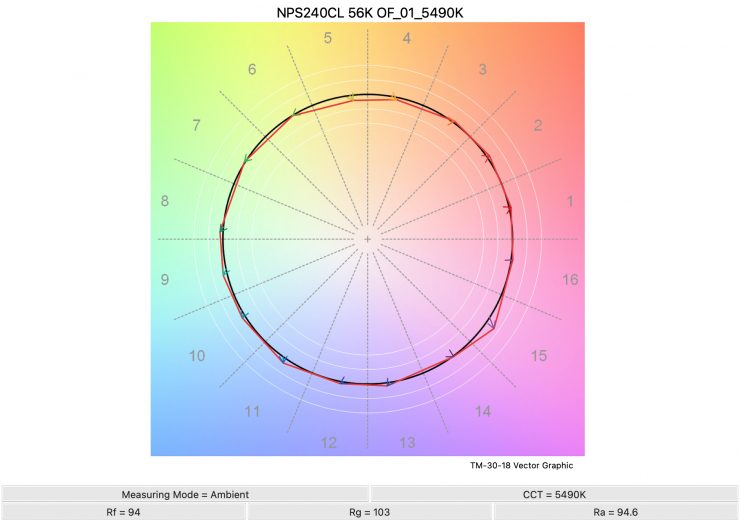
5600K 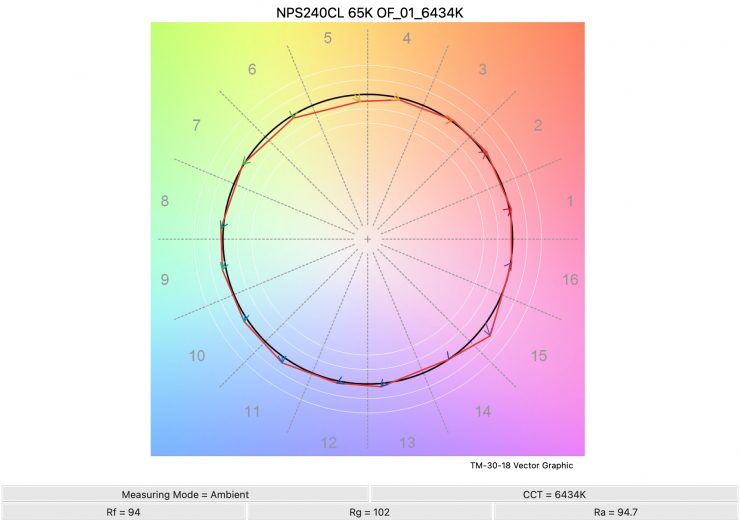
6500K 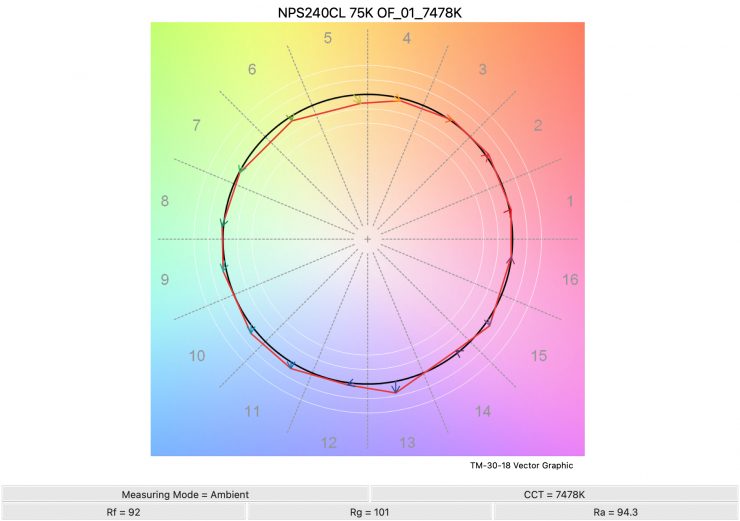
7500K
Above you can see the scores for the Nanlite PavoSlim 240CL at various CCT settings. Below I have listed the figures as well.
Here are the results:
| Rf | Rg | |
| 2700K | 92 | 98 |
| 3200K | 94 | 100 |
| 4500K | 94 | 102 |
| 5600K | 94 | 103 |
| 6500K | 94 | 102 |
| 7500K | 92 | 101 |
The TM-30 scores were fairly consistent across its CCT range and it shows me that the light is very consistent at replicating accurate colors with full saturation. However, you can see that it did have a tendency to slightly over-saturate magenta/red colors at 4500K-6500K.
SSI
SSI (Spectral Similarity Index) was developed by the Sci-Tech Council of the Academy. SSI gives me the ability to set any light as a standard, or use predefined standards (such as CIE D55), and then give other lights an SSI score based upon how well they will match standards such as CIE D55 measure spectral response and compare it directly against an ideal light source.
SSI is a much better way to judge an LED light than CRI or TLCI, although they don’t tell the full story of any light and you can’t judge a light by SSI scores alone.
SSI is useful to see how well different lights will play together. As the Sekonic C-800 Spectromaster can measure SSI, I decided to test out the Nanlite PavoSlim 60C and 120C to see how they performed.
Nanlite PavoSlim 240CL
3200K

Above are the scores for the light when used at 3200K. The scores show that the light does a very good job of accurately replicating a 3200K (Tungsten) source. Any score in the mid to high 80’s is outstanding for an LED light.
5600K

Above are the scores for the light when used at 5600K. The scores show that the light does a reasonably good job of accurately replicating a CIE D55 source. A score in the low to mid-70s is very typical for a 5600K LED light.
The main reason we want to record SSI scores is so we can see how well they match with other lights. For example, let’s see how well the Nanlite PavoSlim 240CL matches the ARRI Orbiter and Prolycht Orion 675 FS at both 3200K and 5600K. Below you can see the results.
PavoSlim 240CL 5600K

As you can see the Nanlite PavoSlim 240CL is a decent enough match with the Prolycht Orion 675 FS and Orion 675FS when used at 5600K.
PavoSlim 240CL 3200K

At 3200K the Nanlite PavoSlim 240CL is also a reasonably decent match to the Prolycht and ARRI.
As another comparison, let’s see how it matches the Nanlite Alien 300C and itself when it is used with the softbox.

As you can see the Nanlite PavoSlim 240CL was almost a perfect match to the Nanlite Alien 300C, and it was also a very good match to itself when used with the softbox.
Being able to measure SSI in advance and compare different lights you may be using together is a great way of finding out what lights will work together and what adjustments need to be made.
Spectral Distribution
Nanlite PavoSlim 240CL 3200K
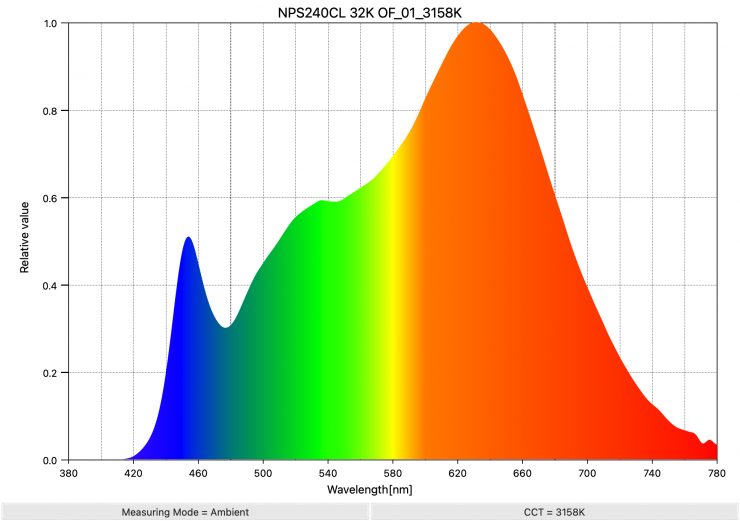
Above you can see the spectral distribution of the Nanlite PavoSlim 240CL when it is set at 3200K. The spectral distribution is decent.

As a comparison, above you can see what the spectral response of an ARRI Orbiter looks like when used at 3200K.
Nanlite PavoSlim 240CL 5600K
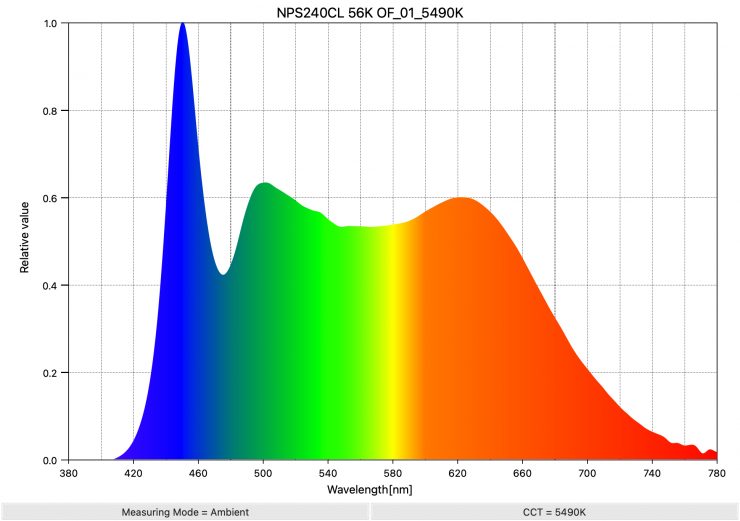
Above you can see the spectral distribution of the Nanlite PavoSlim 240CL when it is set at 5600K. The spectral distribution is decent, but there is a slight push toward green.

Let’s compare that against the best LED light I have ever tested at 5600K, the Maxima 3.
Real-World Performance and Quality of Light

As I always say, photometric scores only tell you part of the story. So do the scores from the Nanlite PavoSlim 240CL translate into real-world performance? Well, let’s find out.
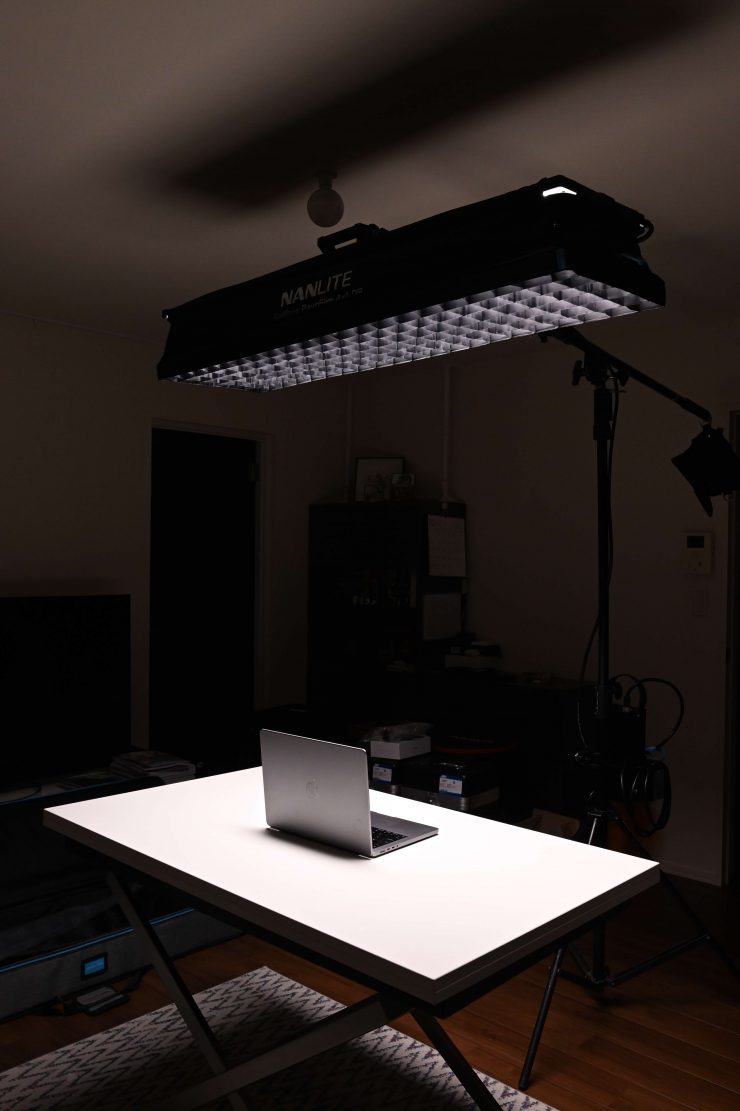
The physical size and length of the fixture make it a really nice option for overhead lighting. By using it with the honeycomb grid you can also control the spill.

As far as how the lights look, you can produce a beautiful soft source. With the included diffusion you get this lovely quality of light. As the light has a lot of output you can still heavily diffuse it and get good results.
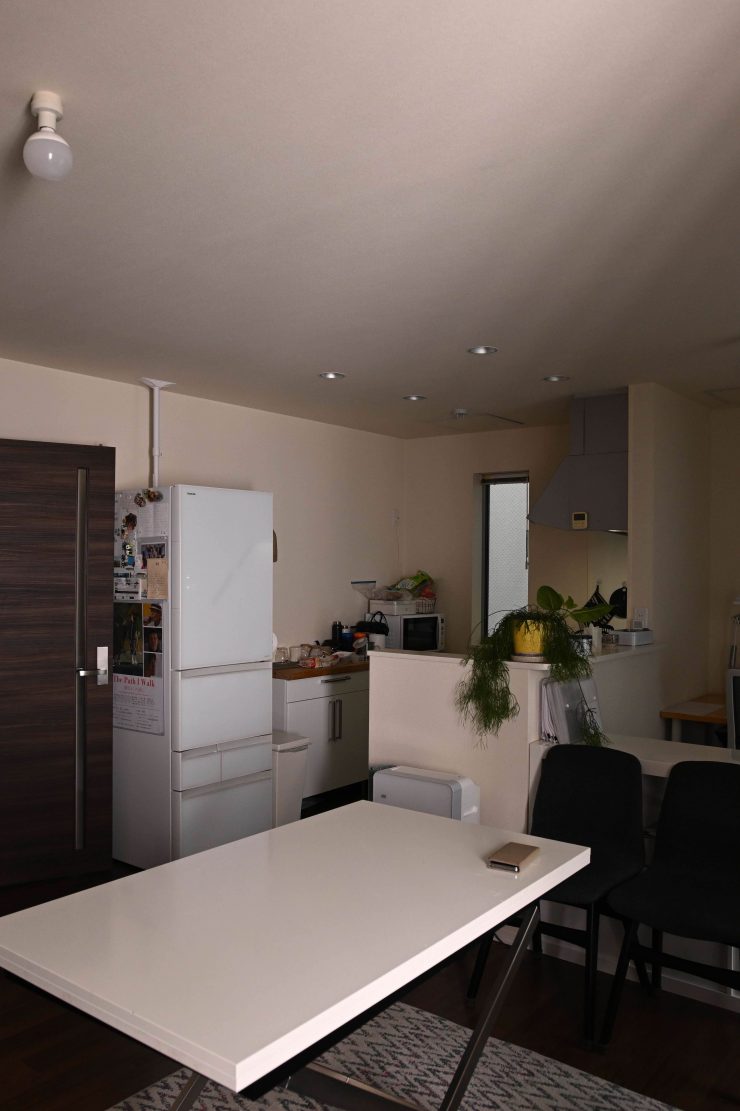
If you want to see how much output the light has, above you can see what the light looks like when it is placed outside and punched through a curtain shear with 2 layers of diffusion and a honeycomb grid


PavoSlim 240CL no diffusion 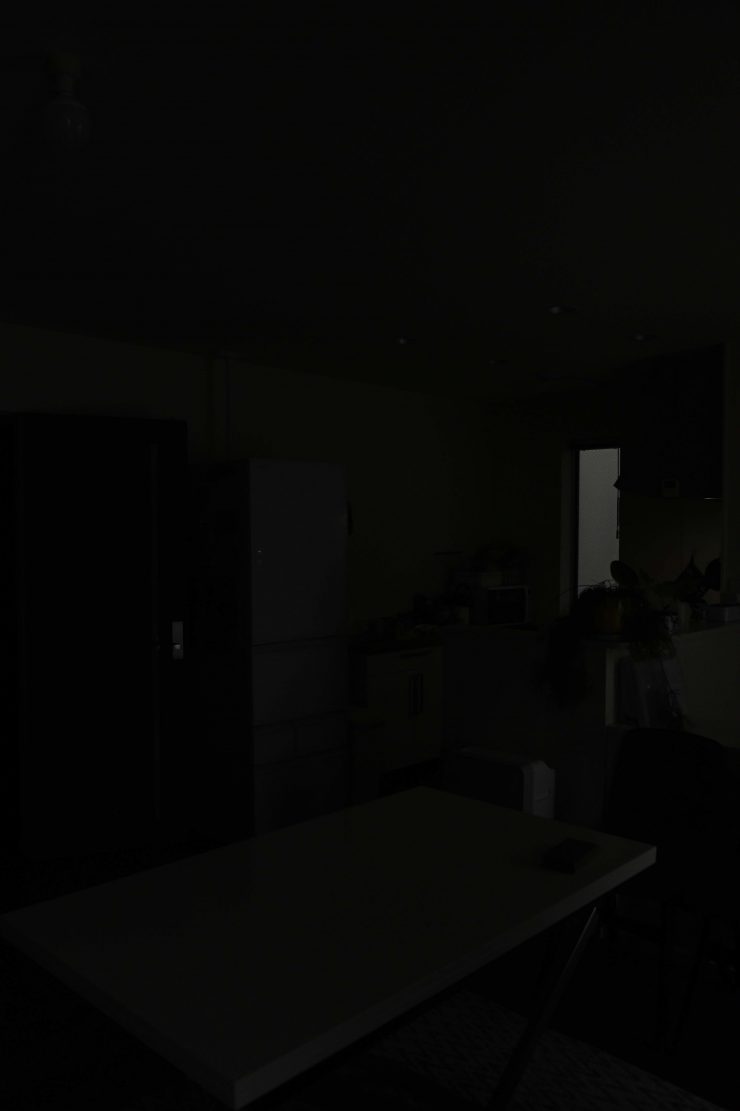
Light off
Above you can see how much output the light has when used with no diffusion.
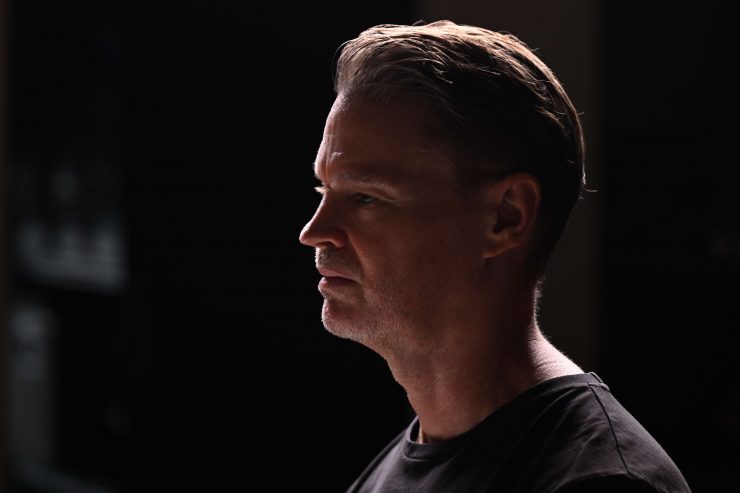
I also found it really nice to have a reasonably lightweight fixture of this size with lots of output. The light certainly punches well above its weight.
You could also use it for lighting green screens and for shooting full-length shots of people.

The lights will create some cross-hatched shadows if you use them without diffusion.

Also, because the fixtures don’t weigh much you can put them a long way out on an arm which is also very handy.
The included diffusion is reasonably strong, and because it sits away from the light source it can create nice soft light.
Optional Accessories
Nanlite makes a few accessories for the PavoSlim series.
The first one is Magnetic Base Adapter with a 1/4-20″ Thread Set. Each corner of the PavoSlim features a 1/4-20″ mount that you can use with the magnetic base adapter with 1/4-20″ thread set for mounting a fixture to any surface that a magnet will bond to.

The second one is the PavoSlim 120B/C Dual-Panel Coupler Kit, which allows you to combine two 120B/C fixtures together to effectively create a horizontal (2×2) or vertical (4×1) fixture. There are also custom-made foldable softboxes and eggcrates for both horizontal and vertical orienatation.
You can buy everything in a Dual-Panel Coupler Kit that includes the following:
- 1x PavoSlim Dual-Panel Coupler 2×2
- 1x PavoSlim Dual-Panel Coupler 4×1
- 1x Softbox PavoSlim Dual-Panel 2×2 QR
- 1x 2×2 Softbox
- 1x 2×2 Eggcrate
- 1x 2×2 Lite Diffuser
- 1x 2×2 Standard Diffuser
- 1x Softbox PavoSlim Dual-Panel 4×1 QR
- 1x 4×1 Softbox
- 1x 4×1 Eggcrate
- 1x 4×1 Lite Diffuser
- 1x 4×1 Standard Diffuser
Price
The Nanlite PavoSlim series is now available to purchase. Below are the prices:
- Nanlite PavoSlim 60B $399 USD
- Nanlite PavoSlim 60C $599 USD
- Nanlite PavoSlim 120B $599 USD
- Nanlite PavoSlim 120C $799 USD
- Nanlite PavoSlim 240CL $1,750 USD
Alternative Solutions

Other alternatives to the Nanlite PavoSlim 240CL include options from Godox, Intellytech, Aladdin, Litegear, and Falcam Eyes.
| PRICE | |
| Nanlite PavoSlim 240CL | $1,750 USD |
| Godox KNOWLED F200Bi Flexible LED Mat | $519 USD* |
| Intellytech Mega-6 Litecloth 3.0 Bi-Color LED Flexible Mat | $1,289 USD* |
| Aladdin Fabric-Lite 350W Flexible Bi-Color LED Light | $3,150 USD |
| amaran F21c 2 x 1′ RGB LED Flexible Light Mat | $479.20 USD* |
| Falcon Eyes RX-48TDX III | $1,115.29 USD |
| Litegear LiteMat Spectrum 2L RGB LED Light Panel (Schuko Power Cable) | $4,158 USD |
*Currently on sale at B&H
Above you can see how the price compares to some of the competition. Again, this isn’t an apples-to-apples comparison, because all of these lights have different power draws, beam angles, and sizes.
Conclusion
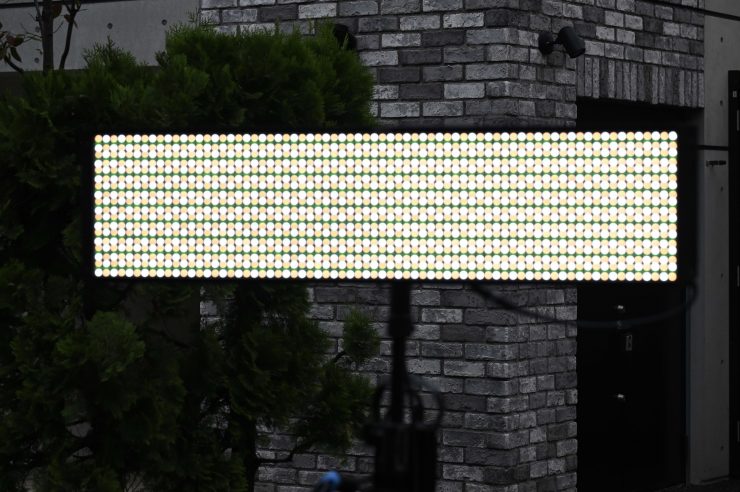
The Nanlite PavoSlim 240CL is a nice fixture, and while the size may be a little niche, I found it to be a very versatile fixture that solves a lot of real-world issues.
The light is solidly made, and well-thought-out, and it has a good amount of output and good color rendering scores.
It produces a beautiful soft light, especially when used with its built-in soft bix and diffusion. The output is extremely impressive given the light’s relatively low power draw. That high output really helps when you want to create a more diffused lighting source, but you still require a decent amount of punch.
As I just mentioned, the dimensions of the light arguably make it a little niche, but the size is reasonably similar to some of the older Kino Flo fixtures that had tubes. I found it works really well as a backlight or when you need an overhead lighting source. That’s not to say you couldn’t use it as a key light or for a wide array of lighting applications, because you absolutely could.
Being able to run the light at 100% output from two flight-safe batteries adds to its versatility.
Unlike flexible LED lights, because the PavoSlim features hard backing plates they are super quick to set up and use. The mounting system is substantially better than what you will find on most flexible LED panels.
The photometric scores across the board are impressive, however, the light doesn’t have consistent output across its CCT range. This is probably not a big deal for most people given the light’s high output.
I like that the diffusion Nanlite has used doesn’t alter the CCT readings. This is a big deal because a lot of diffusion I have previously seen with lights like this alters the CCT readings quite considerably.
The Nanlite app works well and it is easy to use and navigate, as are the physical controls on the power supply/controller.
The PavoSlim 240CL is a nice addition to the series and it’s an impressive light with a good amount of output and a relatively low power draw. Nanlite continues to make impressive features and they now have a very wide array of lighting fixtures that vary from tubes all the way up to high power draw COBs to choose from.


